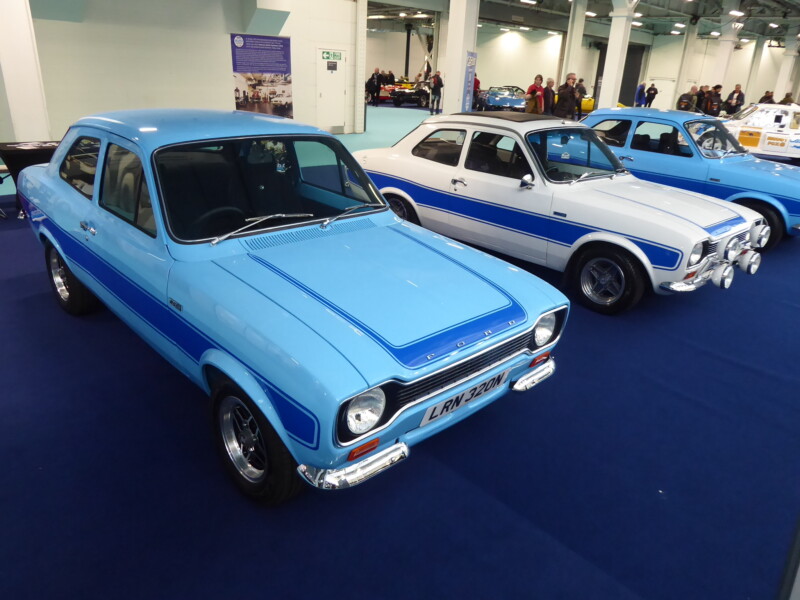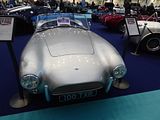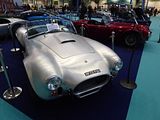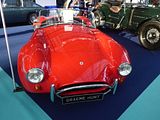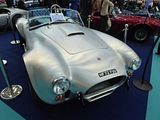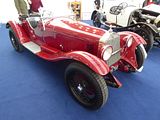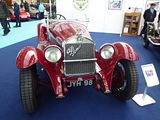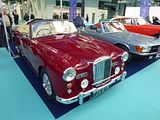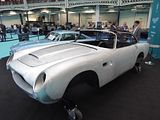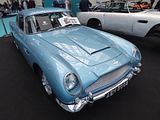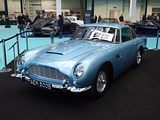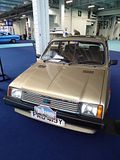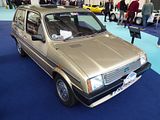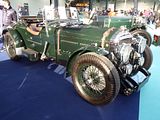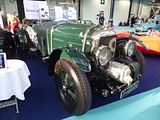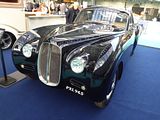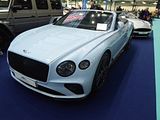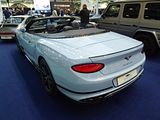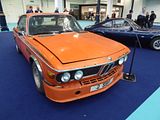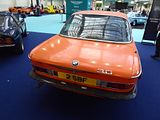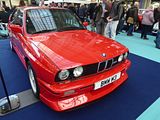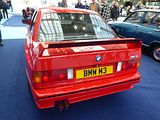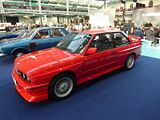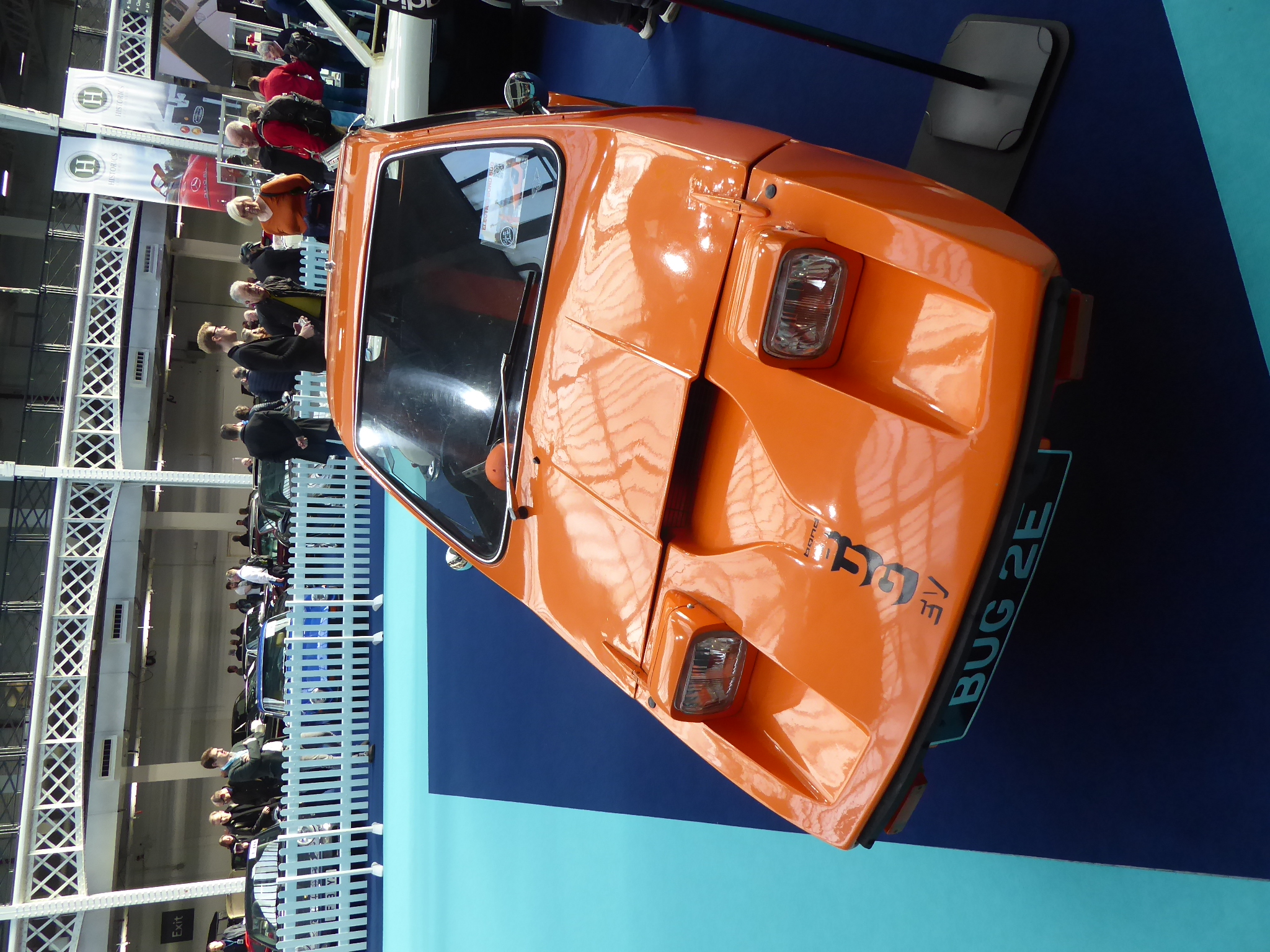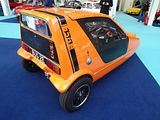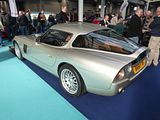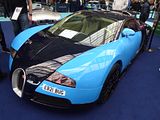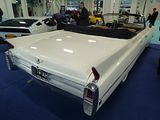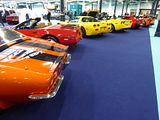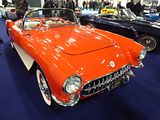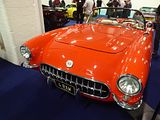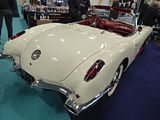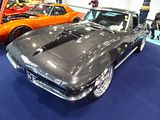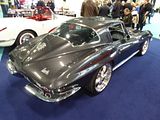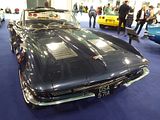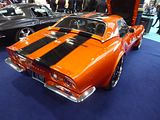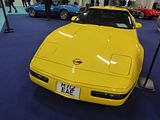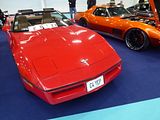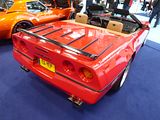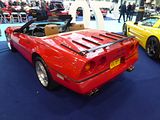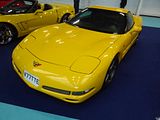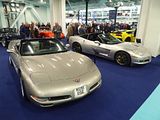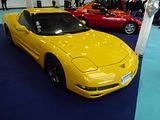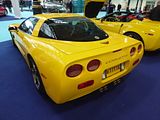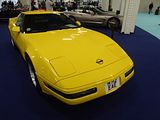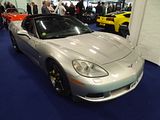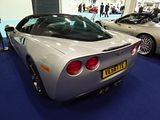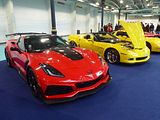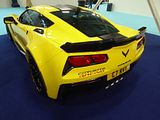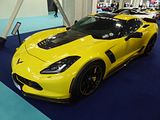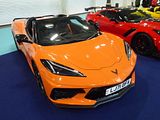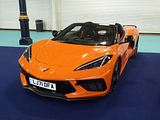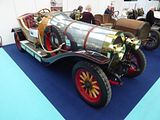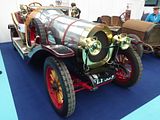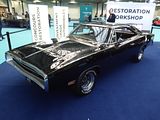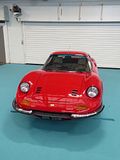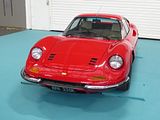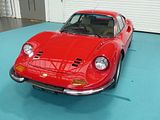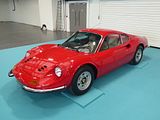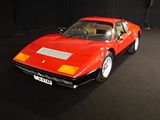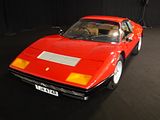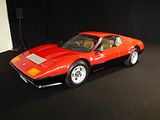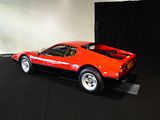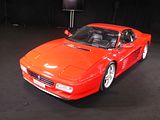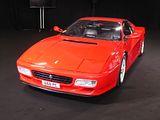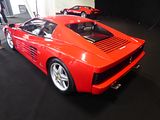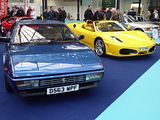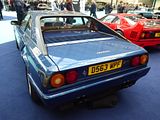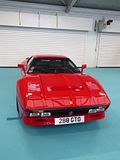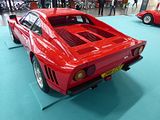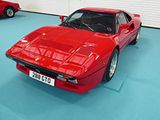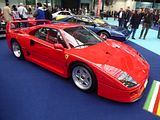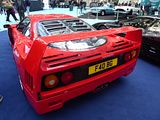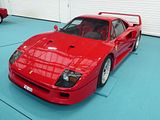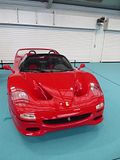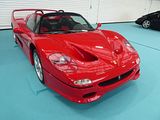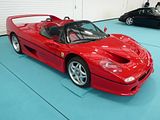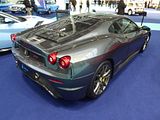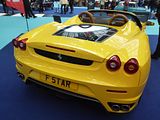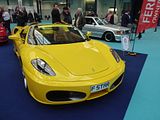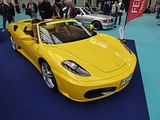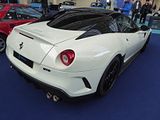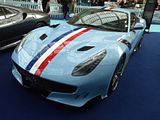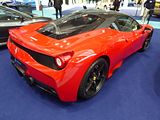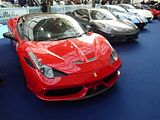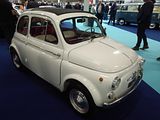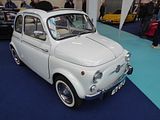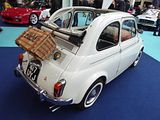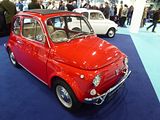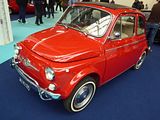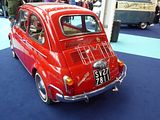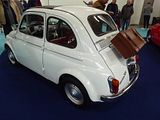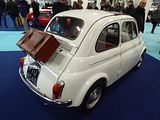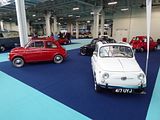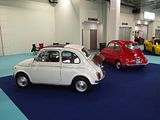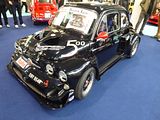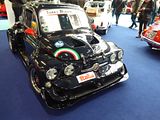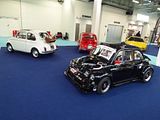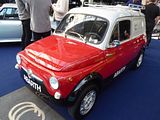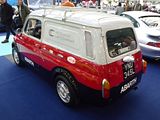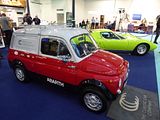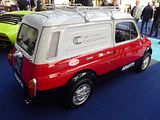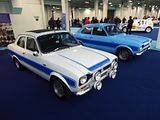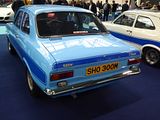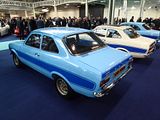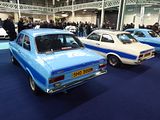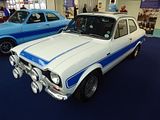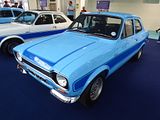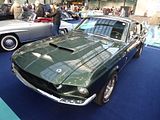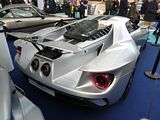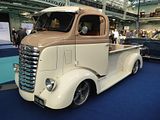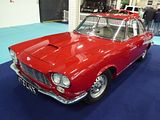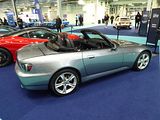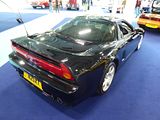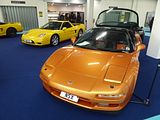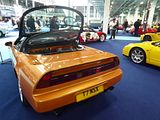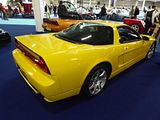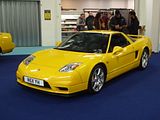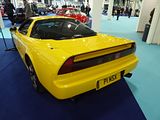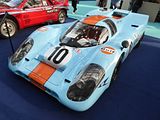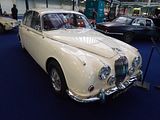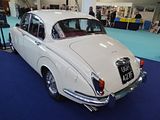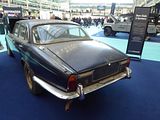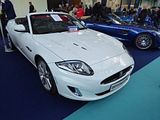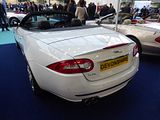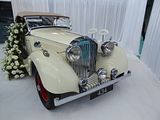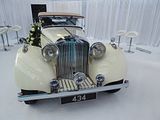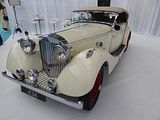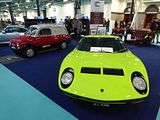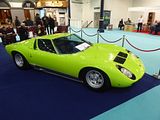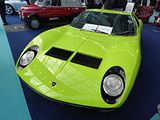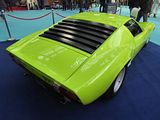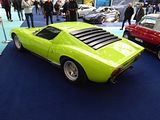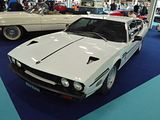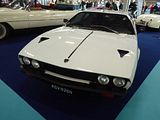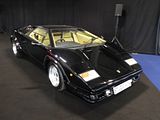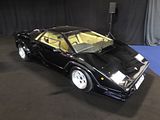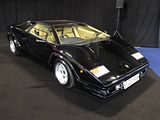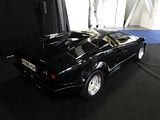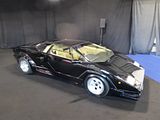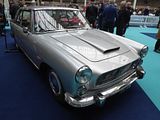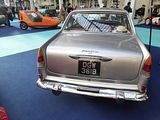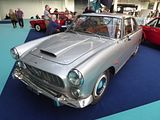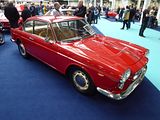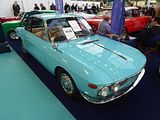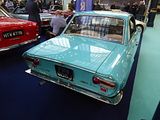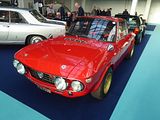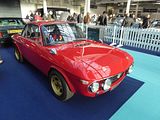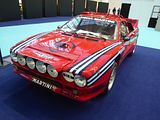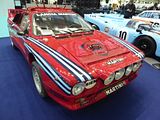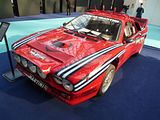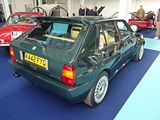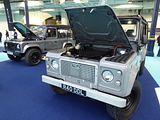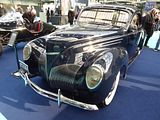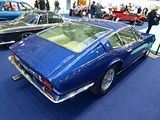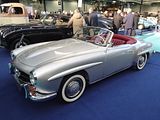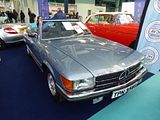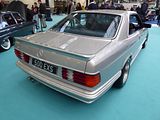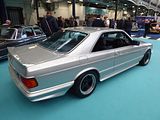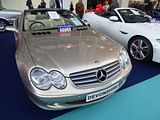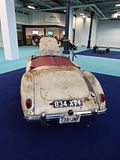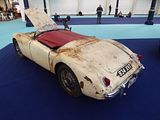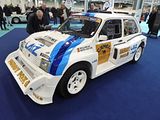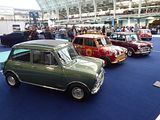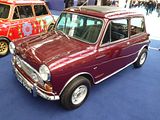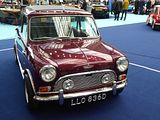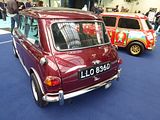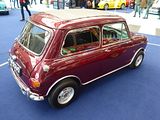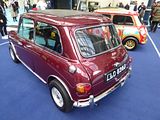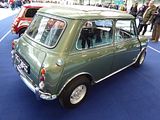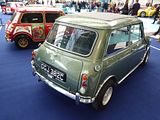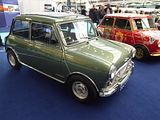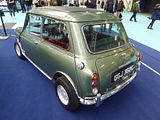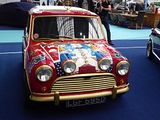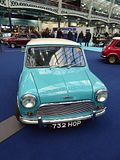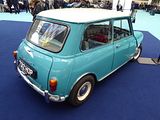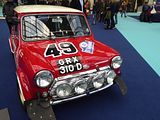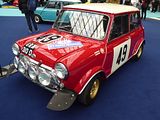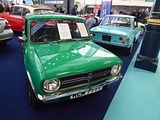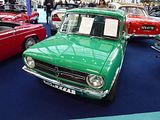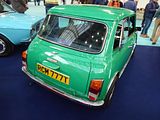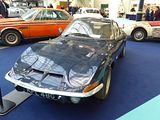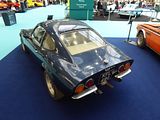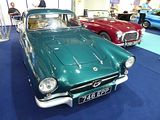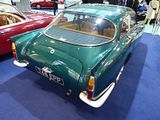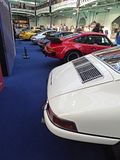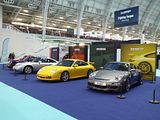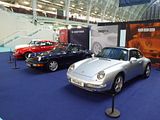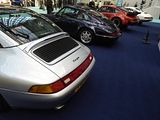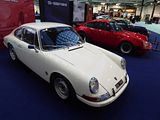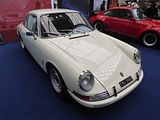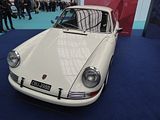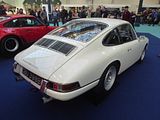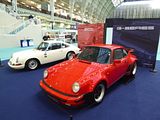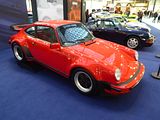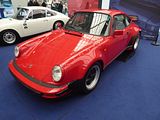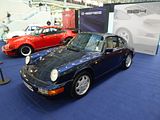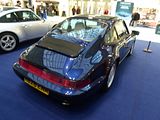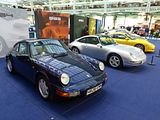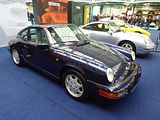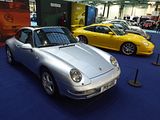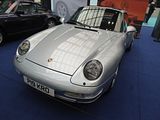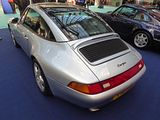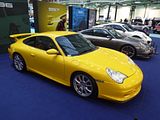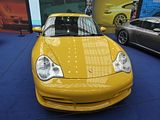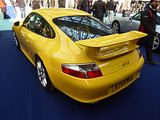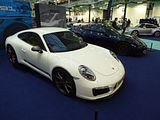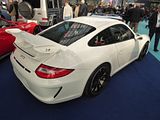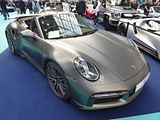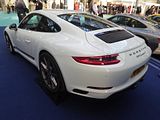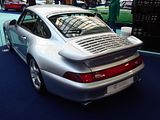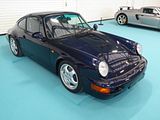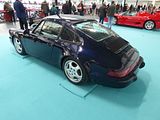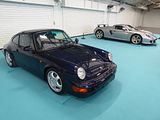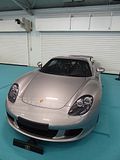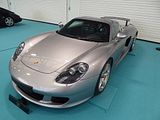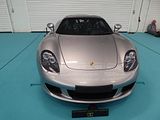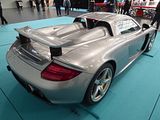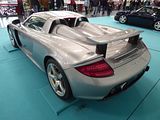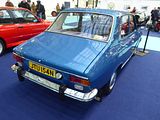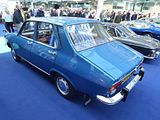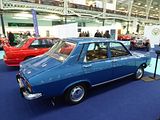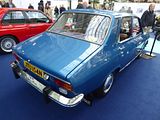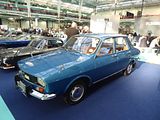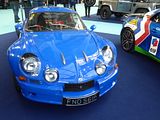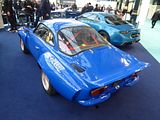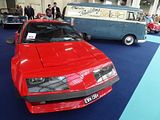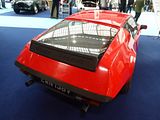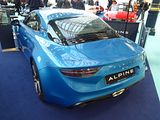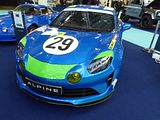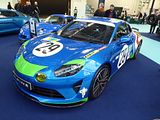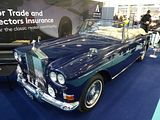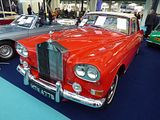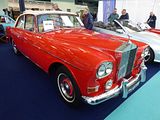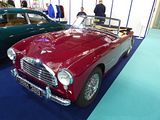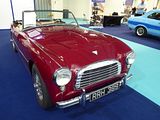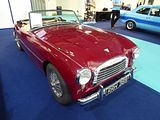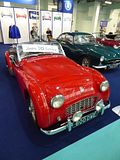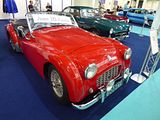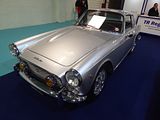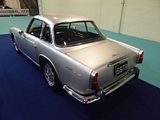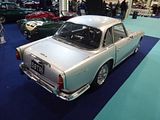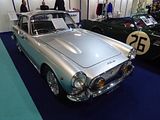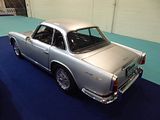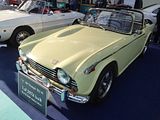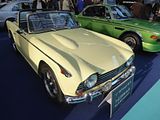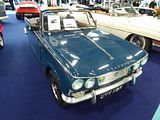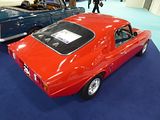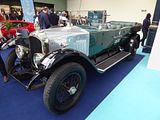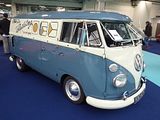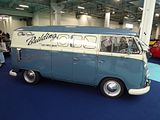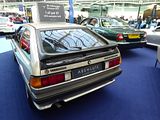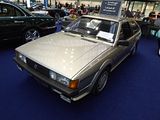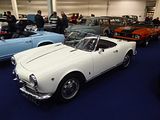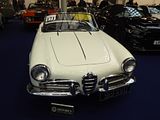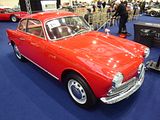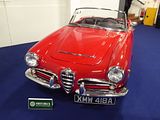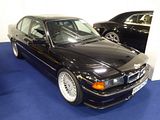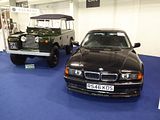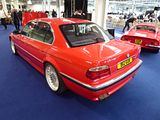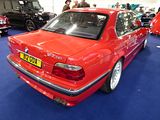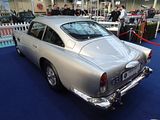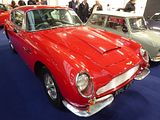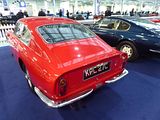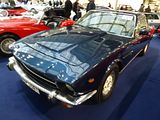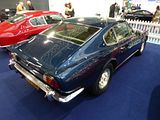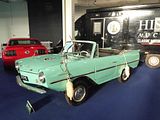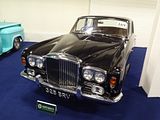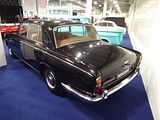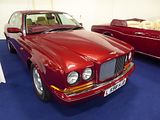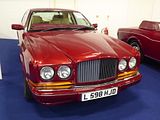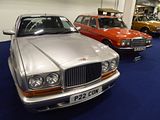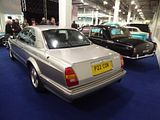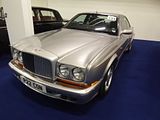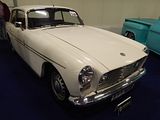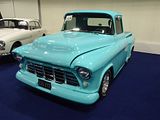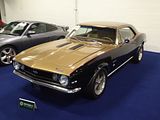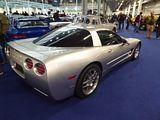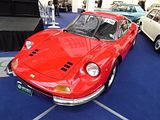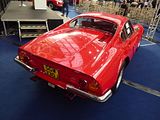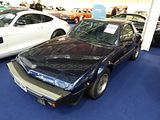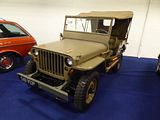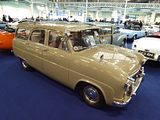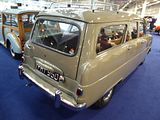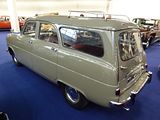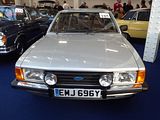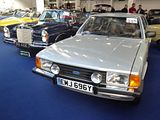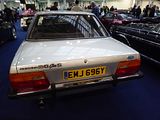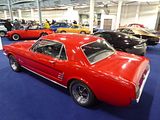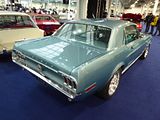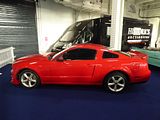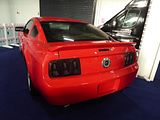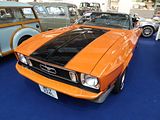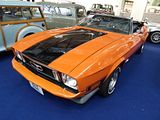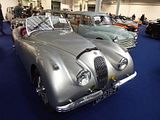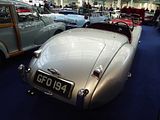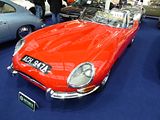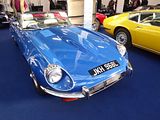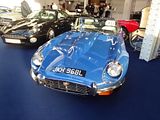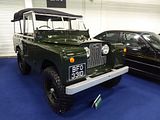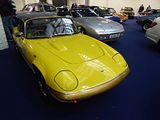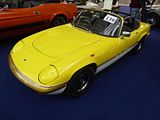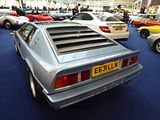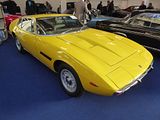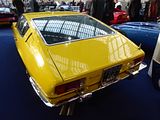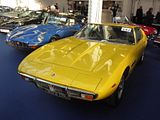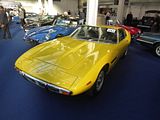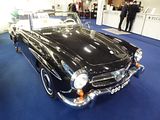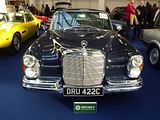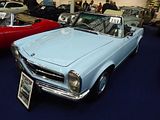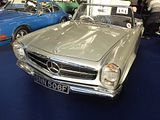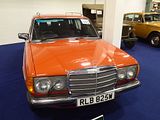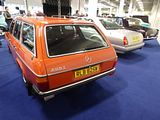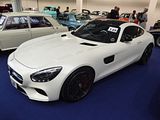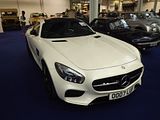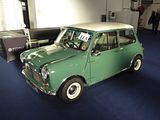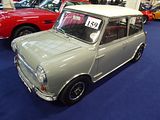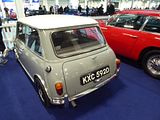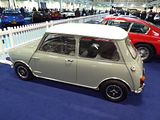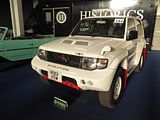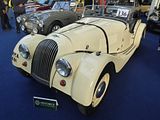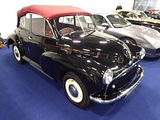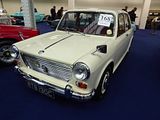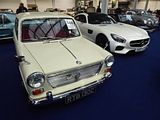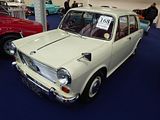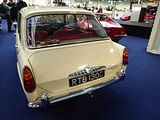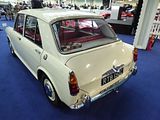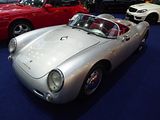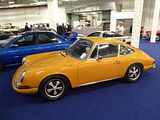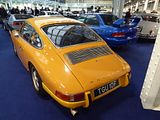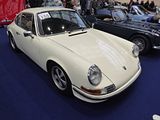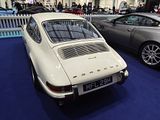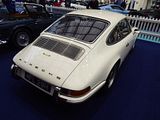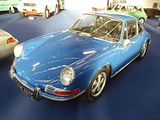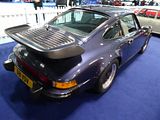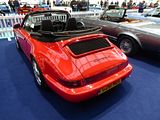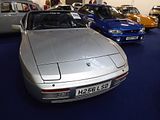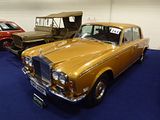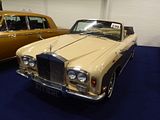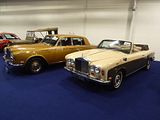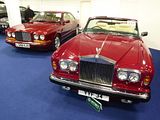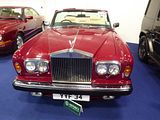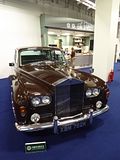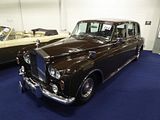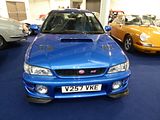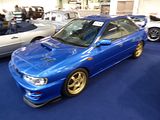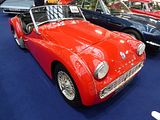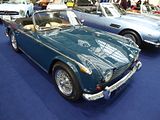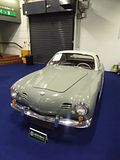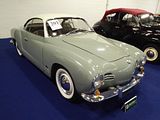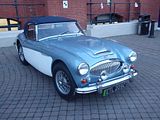In 2020, and somewhat to the surprise of most people, the London Classic Car Show, which since conception had been taking place at the ExCel Exhibition Centre was moved to Olympia. Whilst many would welcome the fact that this is a central location and therefore easier to get to than the Docklands location of those first few years, the move was not universally popular, with more limited availability in close proximity of hotels and car parking, and also it was hard to escape the conclusion that floor space had reduced a lot. I went along and felt I could see it all in not a lot more than a couple of hours whereas the previous location, whilst not as big as say the NEC events, held enough content to make for a full day out. I was interested to see if any heed would be taken of the rather negative feedback that seems to be all over the internet, but of course, the organisers had a more difficult problem to handle in 2021, which was the “ can we, can’t we” state of any public event early in the year with lockdown uncertainties. To their credit they managed to come up with something, which was held outdoors at Syon Park a bit later in the year, but like most people, I did not go, so cannot really comment on what was delivered. In 2022, with lockdown restrictions only fully released at the start of the year, it was too late to do anything, so there was no event at all. That meant that 2023 would see the first “proper” London Classic Car Show for 3 years. Like lots of people, I was eager to see what it would be like and planned to go on the Friday, meeting up with a friend who also wanted a day out in London in February. Slightly oddly, the event did not open til mid-day, so when I got there a few minutes before this there was a massive queue of people waiting for the gates to open. Once they were, people were admitted very quickly but the show felt busy from the outset and the photographer me struggled. It soon became apparent that this was an even smaller show than the 2020 edition had been, and after a couple of hours, the crowds reduced somewhat, presumably as lots of people had seen everything there was there. We had, too, but with fewer people were then able to get the camera to work to produce the photos you see here, so we did actually stay nearer to 4 hours. I did bump into a couple of other people I know, but others had been there, as I would find out when I saw their photos online after, but the comments they all made was that they did not need to stay long to see it all. Presented here are the photos of what we did see:
AC
Original Cobra models from the 1960s are very rare indeed, as there were not that many produced and a lot of those which were made are still in the US. But there have been lots and lots of replicas, recreations and continuation models and there were several examples of these here.
ALFA ROMEO
One of my favourite cars o the day was this rather fabulous 1929 6C 1750 Super Sport Zagato Spider. In the mid-1920s, Alfa’s RL was considered too large and heavy, so a new development began. The 2-litre formula that had led to Alfa Romeo winning the Automobile World Championship in 1925, changed to 1.5-litre for the 1926 season. The 6C 1500 was introduced in 1925 at the Milan Motor Show and production started in 1927, with the P2 Grand Prix car as starting point. Engine capacity was now 1487 cc, against the P2’s 1987 cc, while supercharging was dropped. The first versions were bodied by James Young and Touring. In 1928, a 6C Sport was released, with a dual overhead camshafts engine. Its sport version won many races, including the 1928 Mille Miglia. Total production was 3000 (200 with DOHC engine). Ten copies of a supercharged (compressore) Super Sport variant were also made. The more powerful 6C 1750 was introduced in 1929 in Rome. The car had a top speed of 95 mph, a chassis designed to flex and undulate over wavy surfaces, as well as sensitive geared-up steering. It was produced in six series between 1929 and 1933. The base model had a single overhead cam; Super Sport and Gran Sport versions had double overhead cam engines. Again, a supercharger was available. Most of the cars were sold as rolling chassis and bodied by coachbuilders such as Zagato, and Touring. Additionally, there were 3 examples built with James Young bodywork. In 1929, the 6C 1750 won every major racing event it was entered, including the Grands Prix of Belgium, Spain, Tunis and Monza, as well as the Mille Miglia was won with Giuseppe Campari and Giulio Ramponi, the Brooklands Double Twelve and the Ulster TT was won also, in 1930 it won again the Mille Miglia and Spa 24 Hours. Total production was 2635.
There’s a complex history to this much-loved classic. The first car was called the Alfa Romeo Giulia Sprint GT, and was revealed at a press event held at the then newly opened Arese plant on 9 September 1963, and displayed later the same month at the Frankfurt Motor Show. In its original form the Bertone body is known as scalino (step) or “step front”, because of the leading edge of the engine compartment lid which sat 1/4 an inch above the nose of the car. The Giulia Sprint GT can be distinguished from the later models by a number of features including: Exterior badging: Alfa Romeo logo on the front grille, a chrome script reading “Giulia Sprint GT” on the boot lid, and rectangular “Disegno di Bertone” badges aft of the front wheel arches; flat, chrome grille in plain, wide rectangular mesh without additional chrome bars; single-piece chrome bumpers; no overriders. Inside the cabin the padded vinyl dashboard was characterised by a concave horizontal fascia, finished in grey anti-glare crackle-effect paint. Four round instruments were inset in the fascia in front of the driver. The steering wheel was non-dished, with three aluminium spokes, a thin bakelite rim and a centre horn button. Vinyl-covered seats with cloth centres and a fully carpeted floor were standard, while leather upholstery was an extra-cost option. After initially marketing it as a four-seater, Alfa Romeo soon changed its definition of the car to a more realistic 2+2. The Giulia Sprint GT was fitted with the 1,570 cc version of Alfa Romeo’s all-aluminium twin cam inline four (78 mm bore × 82 mm stroke), which had first debuted on the 1962 Giulia Berlina. Breathing through two twin-choke Weber 40 DCOE 4 carburettors, on the Sprint GT this engine produced 105 hp at 6,000 rpm. Like all subsequent models, the Sprint GT was equipped with an all-synchromesh 5-speed manual transmission. The braking system comprised four Dunlop disc brakes and a vacuum servo. The rear brakes featured an unusual arrangement with the slave cylinders mounted on the axle tubes, operating the calipers by a system of levers and cranks. According to Alfa Romeo the car could reach a top speed of “over 180 km/h (112 mph)”. In total 21,902 Giulia Sprint GT were produced from 1963 to 1965, when the model was superceded by the Giulia Sprint GT Veloce. Of these 2,274 were right hand drive: 1,354 cars fully finished in Arese, and 920 shipped in complete knock-down kit form for foreign assembly. For 1966, the Giulia Sprint GT was replaced by the Alfa Romeo Giulia Sprint GT Veloce, which was very similar but featuring a number of improvements: a revised engine—slightly more powerful and with more torque—better interior fittings and changes to the exterior trim. Alongside the brand new 1750 Spider Veloce which shared its updated engine the Sprint GT Veloce was introduced at the 36th Geneva Motor Show in March 1966, and then tested by the international specialist press in Gardone on the Garda Lake. Production had began in 1965 and ended in 1968. The Giulia Sprint GT Veloce can be most easily distinguished from other models by the following features: badging as per Giulia Sprint GT, with the addition of round enamel badges on the C-pillar—a green Quadrifoglio (four-leaf clover) on an ivory background—and a chrome “Veloce” script on the tail panel; black mesh grille with three horizontal chrome bars; the grille heart has 7 bars instead of 6; stainless steel bumpers, as opposed to the chromed mild steel bumpers on the Giulia Sprint GT. The bumpers are the same shape, but are made in two pieces (front) and three pieces (rear) with small covers hiding the joining rivets. Inside the main changes from the Giulia Sprint GT were imitation wood dashboard fascia instead of the previous anti-glare grey finish, front seats revised to a mild “bucket” design, and a dished three aluminium spoke steering wheel, with a black rim and horn buttons through the spokes. The Veloce’s type 00536 engine, identical to the Spider 1600 Duetto’s, featured modifications compared to the Giulia Sprint GT’s type 00502—such as larger diameter exhaust valves. As a result it produced 108 hp at 6,000 rpm, an increase of 3 hp over the previous model, and significantly more torque. The top speed now exceeded 185 km/h (115 mph). Early Giulia Sprint GT Veloces featured the same Dunlop disc brake system as the Giulia Sprint GT, while later cars substituted ATE disc brakes as pioneered on the GT 1300 Junior in 1966. The ATE brakes featured an handbrake system entirely separate from the pedal brakes, using drum brakes incorporated in the rear disc castings. Though the Sprint GT Veloce’s replacement—the 1750 GT Veloce—was introduced in 1967, production continued throughout the year and thirty final cars were completed in 1968. By then total Giulia Sprint GT Veloce production amounted to 14,240 examples. 1,407 of these were right hand drive cars, and 332 right hand drive complete knock-down kits. The Alfa Romeo 1750 GT Veloce (also known as 1750 GTV) appeared in 1967 along with the 1750 Berlina sedan and 1750 Spider. The same type of engine was used to power all three versions; this rationalisation was a first for Alfa Romeo. The 1750 GTV replaced the Giulia Sprint GT Veloce and introduced many updates and modifications. Most significantly, the engine capacity was increased to 1779 cc displacement. Peak power from the engine was increased to 120 hp at 5500 rpm. The stroke was lengthened from 82 to 88.5 mm over the 1600 engine, and a reduced rev limit from 7000 rpm to 6000 rpm. Maximum torque was increased to 137 lb·ft at 3000 rpm. A higher ratio final drive was fitted (10/41 instead of 9/41) but the same gearbox ratios were retained. The result was that, on paper, the car had only slightly improved performance compared to the Giulia Sprint GT Veloce, but on the road it was much more flexible to drive and it was easier to maintain higher average speeds for fast touring. For the United States market, the 1779 cc engine was fitted with a fuel injection system made by Alfa Romeo subsidiary SPICA, to meet emission control laws that were coming into effect at the time. Fuel injection was also featured on Canadian market cars after 1971. Carburettors were retained for other markets. The chassis was also significantly modified. Tyre size went to 165/14 from 155/15 and wheel size to 5 1/2J x 14 instead of 5J x 15, giving a wider section and slightly smaller rolling diameter. The suspension geometry was also revised, and an anti-roll bar was fitted to the rear suspension. ATE disc brakes were fitted from the outset, but with bigger front discs and calipers than the ones fitted to GT 1300 Juniors and late Giulia Sprint GT Veloces. The changes resulted in significant improvements to the handling and braking, which once again made it easier for the driver to maintain high average speeds for fast touring. The 1750 GTV also departed significantly from the earlier cars externally. New nose styling eliminated the “stepped” bonnet of the Giulia Sprint GT, GTC, GTA and early GT 1300 Juniors and incorporated four headlamps. For the 1971 model year, United States market 1750 GTV’s also featured larger rear light clusters (there were no 1970 model year Alfas on the US market). Besides the chrome “1750” badge on the bootlid, there was also a round Alfa Romeo badge. Similar Quadrofoglio badges to those on the Giulia Sprint GT Veloce were fitted on C pillars, but the Quadrofoglio was coloured gold instead of green. The car also adopted the higher rear wheelarches first seen on the GT 1300 Junior. The interior was also much modified over that of earlier cars. There was a new dashboard with large speedometer and tachometer instruments in twin binnacles closer to the driver’s line of sight. The instruments were mounted at a more conventional angle, avoiding the reflections caused by the upward angled flat dash of earlier cars. Conversely, auxiliary instruments were moved to angled bezels in the centre console, further from the driver’s line of sight than before. The new seats introduced adjustable headrests which merged with the top of the seat when fully down. The window winder levers, the door release levers and the quarterlight vent knobs were also restyled. The remote release for the boot lid, located on the inside of the door opening on the B-post just under the door lock striker, was moved from the right hand side of the car to the left hand side. The location of this item was always independent of whether the car was left hand drive or right hand drive. Early (Series 1) 1750 GTV’s featured the same bumpers as the Giulia Sprint GT Veloce, with the front bumper modified to mount the indicator / sidelight units on the top of its corners, or under the bumper on US market cars. The Series 2 1750 GTV of 1970 introduced other mechanical changes, including a dual circuit braking system (split front and rear, with separate servos). The brake and clutch pedals on left hand drive cars were also of an improved pendant design, instead of the earlier floor-hinged type. On right hand drive cars the floor-hinged pedals were retained, as there was no space for the pedal box behind the carburettors. Externally, the series 2 1750 GTV is identified by new, slimmer bumpers with front and rear overriders. The combined front indicator and sidelight units were now mounted to the front panel instead of the front bumper, except again on the 1971-72 US/Canadian market cars. The interior was slightly modified, with the seats retaining the same basic outline but following a simpler design. 44,269 1750 GTVs were made before their replacement came along. That car was the 2000GTV. Introduced in 1971, together with the 2000 Berlina sedan and 2000 Spider, the 2 litre cars were replacements for the 1750 range. The engine displacement was increased to 1962 cc. The North American market cars had fuel injection, but everyone else retained carburettors. Officially, both versions generated the same power, 130 hp at 5500 rpm. The interior trim was changed, with the most notable differences being the introduction of a separate instrument cluster, instead of the gauges installed in the dash panel in earlier cars. Externally the 2000 GTV is most easily distinguished by its grille with horizontal chrome bars, featuring protruding blocks forming the familiar Alfa heart in outline, smaller hubcaps with exposed wheel nuts, optional aluminium alloy wheels of the same size as the standard 5. 1/2J × 14 steel items, styled to the “turbina” design first seen on the alloy wheels of the Alfa Romeo Montreal, and the larger rear light clusters first fitted to United States market 1750 GTV’s were standard for all markets. From 1974 on, the 105 Series coupé models were rationalised and these external features became common to post-1974 GT 1300 Junior and GT 1600 Junior models, with only few distinguishing features marking the difference between models. 37,459 2000 GTVs were made before production ended and these days they are very sought after with prices having sky-rocketed in recent years.
Alfa replaced the Giulia-based Spider model with an all-new design which finally made its debut in 1966 together with the Giulia Sprint GT Veloce at an event organised in Gardone Riviera. With its boat tailed styling, it quickly found favour, even before taking a starring role in the film “The Graduate”. The original 1600cc engine was replaced by a more powerful 1750cc unit at the same time as the change was made to the rest of the range, and the car continued like this until 1970, when the first significant change to the exterior styling was introduced on the 1750 Spider Veloce, with the original’s distinctive elongated round tail changed to a more conventional cut-off tail, called the “Kamm tail”, as well as improving the luggage space. Numerous other small changes took place both inside and out, such as a slightly different grille, new doorhandles, a more raked windscreen, top-hinged pedals and improved interior trim. 1971 saw the Spider Veloce get a new, larger powerplant—a 1962 cc, 132 hp unit—and consequently the name was changed from 1750 Spider Veloce to 2000 Spider Veloce. The 1600 Spider restarted production a year later as the Spider 1600 Junior, and was visually identical to the 1300. 1974 saw the introduction of the rare, factory request, Spider-Targa. Based upon the Spider, it featured a Porsche style solid rear window and lift out roof panels, all made out of black GRP type material. Less than 2,000 models of such type were ever made and was the only part solid roof Spider until the introduction of the factory crafted hard top. The 1300 and 2000 cars were modified in 1974 and 1975 respectively to include two small seats behind the front seats, becoming a “two plus two” four seater. The 1300 model was discontinued in 1977. Also, between 1974 and 1976, the early-style stainless-steel bumpers were discontinued and replaced with black, rubber-clad units to meet increasingly stringent North American crash requirements. 4,557 examples of the 1300 Junior were made and 4,848 of the 1600 Junior as well as 16,320 2000 Spider Veloces and 22,059 of 2000 Spider Veloce US version. There were also 4,027 1750 Spider Veloces produced.
ALVIS
Conceived in 1956, this design was launched as the TD21, and it was quite a departure from the lovely, but rather “post-war” TC21. However, on its arrival in dealer’s showrooms, it quickly set about changing established views of the Alvis. Following the loss of coachbuilders Mulliner and Tickford (who were now tied to other companies), Alvis turned to the Swiss coachbuilder, Graber whose tradition of producing sleek, modern and very elegant saloons and dropheads proved a good fit in terms of the way Alvis saw their future. Graber first presented this new style to the Alvis board in late 1957 who were very impressed with the Swiss company’s flowing design and commissioned the body to be built on the new TD chassis. To ease logistical problems, Park Ward of London, built the Graber designed bodies in the UK. The Alvis Three Litre TD21 Series I was produced between the end of 1958 and April 1962, and was powered by the TC’s 2993 cc engine, uprated by 15bhp to 115 as a result of an improved cylinder head design and an increased compression ratio. A new four-speed gearbox from the Austin-Healey 100 was incorporated, while the suspension remained similar to the cars predecessor, independent at the front using coil springs and leaf springs at the rear, but the track was increased slightly and a front anti-roll bar added. From 1959 the all drum brake set up was changed to discs at the front retaining drums at the rear. In April 1962, the car was upgraded with four wheel Dunlop disc brakes in place of the disc/drum combination, aluminium doors, a five-speed ZF gearbox and pretty recessed spotlights either side of the grille, these improvements coming together to create the TD21 Series II. The car would be updated in 1963 to create the TE21, with its distinctive dual headlights proving a recognition point, and the later TF21, continuing in production until 1967 at which point Alvis ceased car manufacture.
ASTON MARTIN
Although not the first in the DB series, this is undoubtedly the best-known, and needs little in the way of an introduction, as this model is famous for being the most recognised cinematic James Bond car, first appearing in the James Bond film Goldfinger The DB5 was a follow-on to the DB4, designed by the Italian coachbuilder Carrozzeria Touring Superleggera. Released in 1963, it was an evolution of the final series of DB4. The principal differences between the DB4 Series V and the DB5 are the all-aluminium engine, enlarged from 3.7 L to 4.0 L; a new robust ZF five-speed transmission (except for some of the very first DB5s); and three SU carburettors. This engine, producing 282 bhp, which propelled the car to 145 mph, available on the Vantage (high powered) version of the DB4 since March 1962, became the standard Aston Martin power unit with the launch in September 1963 of the DB5. Standard equipment on the DB5 included reclining seats, wool pile carpets, electric windows, twin fuel tanks, chrome wire wheels, oil cooler, magnesium-alloy body built to superleggera patent technique, full leather trim in the cabin and even a fire extinguisher. All models have two doors and are of a 2+2 configuration. Like the DB4, the DB5 used a live rear axle At the beginning, the original four-speed manual (with optional overdrive) was standard fitment, but it was soon dropped in favour of the ZF five-speed. A three-speed Borg-Warner DG automatic transmission was available as well. The automatic option was then changed to the Borg-Warner Model 8 shortly before the DB6 replaced the DB5. The high-performance DB5 Vantage was introduced in 1964 featuring three Weber twin-choke 45DCOE side-draft carburettors and revised camshaft profiles, delivering greater top-end performance at the expense of overall flexibility, especially as legendary Webers are renowned as ‘full-throttle’ devices. This engine produced 315 hp. Only 65 DB5 Vantage coupés were built. Just 123 convertible DB5s were produced (also with bodies by Touring), though they did not use the typical “Volante” name until 1965. The convertible model was offered from 1963 through to 1965. Originally only 19 of the 123 DB5 Convertibles made were left-hand drive. 12 cars were originally fitted with a factory Vantage engine, and at least one further convertible was subsequently factory fitted with a DB6 specification Vantage engine. A rare factory option (actually fitted by Works Service prior to customer delivery) was a steel removable hard top. From October 1965 to October 1966, Aston Martin used the last 37 of the Aston Martin DB5 chassis’ to make another convertible model. These 37 cars were known as “Short Chassis” Volantes and were the first Aston Martins to hold the “Volante” name. Although calling it a “Short Chassis” is a bit of a misnomer as the “short” comes from comparing it to the subsequent DB6, which has a longer chassis. When compared to the DB5, it is not “short” but rather the same size, however these cars differ to the DB5 convertible models as they feature DB6 split front and rear bumpers and rear TR4 lights, as also used on the DB6.
This version of the Vanquish started life as the Project AM310 Concept that was unveiled at the 2012 Concorso D’Eleganza at Villa D’Este on the shores of Lake Como, Italy. The concept car was based on the fourth generation VH platform. It included a tweaked version of Aston Martin’s familiar grille and headlight design and a more pronounced bulge in the bonnet – with the real One-77-inspired flourishes saved for the sides and the rear, the side vents run almost to the door handles (from One-77), new rear light design from One-77, and a 5.9-litre V12 engine that produced 550 PS. Aston Martin later announced that the concept would be put into production as the all new Aston Martin Vanquish. The exterior styling of the Vanquish is an evolution of the DBS with many styling cues such as the elongated side strakes being inspired by the Aston Martin One-77. The boot lid included an integrated rear spoiler designed to look as if it is impossible to make; this was done on the orders of Aston Martin Chief Executive, Dr. Ulrich Bez. The car has an exposed carbon fibre side skirt showing its all carbon fibre body. The Vanquish uses the new VH Generation IV platform which is lighter and uses more carbon fibre components than the VH Generation II platform used in the DBS. The car featured an all new interior based on the one found in the exclusive One-77. The standard interior was trimmed in hand stitched leather and alcantara and was available in a range of colours. The centre console features an revised infotainment system over the one found in the DBS. The car was available as either a 2-seater or 2+2. The Vanquish used an upgraded version of Aston Martin’s flagship 5.9-litre AM11 V12 engine called the AM28 with a power output of 565 bhp at 6,750 rpm and torque of 457 lb/ft at 5,500 rpm. The Vanquish can accelerate from 0 to 100 km/h (62 mph) in 4.1 seconds, and has a top speed of 295 km/h (183 mph). Like most Aston Martins, the engine is front mid-mounted for better weight distribution, with the power going to the rear wheels. The Vanquish has 51/49 front/rear weight distribution, and a kerb weight of 1,739 kg (3,834 lb). It uses a fully catalysed stainless steel exhaust system with active bypass valves. The Vanquish uses an updated Touchtronic II six-speed automatic gearbox. It was the first Aston Martin model to be available with launch control. The combined space of cabin and a boot that, at 368 litres, is more than 60% larger than that of the DBS. The brakes are ventilated carbon ceramic discs, 398 mm (15.7 in) six-piston callipers in the front and 360 mm (14.2 in) four-piston callipers in the rear. The suspension is a lightweight aluminium front subframe with hollow castings with independent double wishbones incorporating anti-dive geometry, coil springs, anti-roll bar, and monotube adaptive dampers in the front and independent double wishbones with anti-squat and anti-lift geometry, coil springs, anti-roll bar, and monotube adaptive dampers in the rear. It has a three-stage adjustable adaptive damping system including normal, sport and track modes. The tyres are Pirelli P Zeros, 255/ZR20 in the front and 305/30 ZR20 in the rear. The vehicle was unveiled in the London Film Museum, Covent Garden, followed by 2012 Monterey Car Week. Deliveries to UK and Continental Europe began in late 2012. In August 2014, Aston Martin revealed technical modifications to the Vanquish. The changes include a new eight-speed Touchtronic III gearbox and upgraded AM29 V12 engine that produces 568 bhp and torque of 465 lb/ft. The changes greatly enhanced performance, with an acceleration of 0 to 100 km/h (62 mph) in 3.6 seconds, and a top speed of 324 km/h (201 mph). In 2013, Aston Martin unveiled a convertible version of the Vanquish, called Volante. The Volante includes a full carbon fibre body, triple-skin lightweight fabric roof, 50% larger boot than its predecessor and the third generation Brembo 398 mm × 36 mm front and 360 mm × 32 mm CCM rear Carbon Ceramic Matrix (CCM) brake discs with six-piston front and four-piston rear brake callipers (from the One-77). The Vanquish Volante is 13% torsionally stiffer than the outgoing DBS Volante. The carbon fibre-skin of the Vanquish Volante was created by the engineering team at Aston Martin. The vehicle was unveiled at the 2013 Pebble Beach Concours d’Elegance. Deliveries to Europe began in late 2013. On 16 November 2016, Aston Martin announced the new Vanquish S model. The Vanquish S features the same AM29 V12 engine, with power now increased to 595 bhp, and a new aerodynamic package. The Vanquish S can accelerate from 0 to 100 km/h (62 mph) in 3.5 seconds, and the top speed remains unchanged at 201 mph (324 km/h). The starting price at launch was £199,950 and deliveries started in December 2016. Aston Martin also unveiled a convertible version of the Vanquish S called the Vanquish S Volante in 2017.
AUSTIN
“A British car to beat the world”. So read the billboards when the Austin Metro was revealed in October 1980. We had waited a long time for this car. There were many false starts, with thoughts first turning to how to replace the Mini going back to the late 1960s, but for various reasons, every effort had been cancelled. Fortunately, that extended to the ADO88 prototype which got to quite an advanced state of development in 1978, but which received less than favourable feedback at customer clinics. A hasty redesign was conducted. Despite carrying over the A Series engines, albeit in modified A+ guise, as BL had nothing else suitable an no money to develop an alternative, and that meant the 4 speed in-sump gearbox came with it, the little Metro has an immediate hit. It looked good, with pert, modern looks, and with a large hatchback, and some innovative ideas on how to maximise the use of space, this was a roomy car that Britain could indeed be proud of. That a young lady who came to prominence in the months following launch, the future Princess Diana, could be seen driving around in one probably helped still further. Five models were available at launch: 1.0, 1.0L, the economy-oriented 1.0 HLE, 1.3S and 1.3 HLS, and the cars were available in a wide range of bright and attractive colours, including a greater percentage of metallic paints than were typically offered to buyers of cars in this class. My parents bought a 1.0L in the summer of 1983, as a replacement for our Mini, and the car was a massive improvement in just about every respect. Unlike previous BL cars, this model was not dogged with build quality and reliability issues, though, sadly it did have the same propensity to rust as they did, but it took several years before that would become obvious. Before that happened, the range was expanded with the introduction of cheaper City and City X models, a top spec Vanden Plas and then the sporting MG version. There was a lot of angst about this last one, as the purists all bemoaned the fact that it was not a “real” MG, as it was a family hatchback not a sports car (conveniently ignoring the MG 1100/1300 saloons of the 1960s), but ti soon became apparent that this little car was a blast to drive, and something quite special with its red trim, including red seat belts and a liberal splashing of octagon logos around the car. A wilder Turbo model followed at the end of 1982, reflecting the craze for every manufacturer to bolt one on to every car that they could find to create a series of often rather unruly and lag-prone but fast machines. Although a lot of work was done in the mid 80s on developing what should have been another world class replacement (the AR6, the prototype for which is also hidden away at Gaydon), a lack of funds meant that for the next 7 years, all that happened was a lot of tweaking of the trim, and specification and the incorporation of a pair of rear doors to create a 5 door model. This was at a time when the competition stood far from still, with the Fiat Uno and Peugeot 205 upping the ante in early 1983, Vauxhall joining the fray with the Nova mid year, a facelifted Fiesta with a five speed gearbox arriving later that year, a new Renault R5 the following year, along with several Japanese rivals coming out every 4 years. It all made the Metro look increasingly elderly, and also small, compared to all its rivals.
AUSTIN-HEALEY
Donald Healey had been producing a range of expensive sports cars from the 1940s, cars such as the Silverstone, the Abbott and the Farnham. For the 1952 London Motor Show, he produced a new design, which was called the Healey Hundred, based on Austin A90 mechanicals, which he intended to produce in-house at his small car company in Warwick. It was one of the stars of the 1952 Show, and it so impressed Leonard Lord, the Managing Director of Austin, who was looking for a replacement to the unsuccessful A90. that Lord struck a deal with Healey on the spot, to build it in quantity. Bodies made by Jensen Motors would be given Austin mechanical components at Austin’s Longbridge factory. The car was renamed the Austin-Healey 100, in reference to the fact that the car had a top speed of 100 mph. Production got under way in 1953, with Austin-Healey 100s being finished at Austin’s Longbridge plant alongside the A90 and based on fully trimmed and painted body/chassis units produced by Jensen in West Bromwich—in an arrangement the two companies previously had explored with the Austin A40 Sports. By early 1956, production was running at 200 cars a month, 150 of which were being sold in California. Between 1953 and 1956, 14,634 Austin-Healey 100s were produced, the vast majority of them, as was the case for most cars in this post war era, going for export. The car was replaced by an updated model in 1956, called the 100-6. It had a longer wheelbase, redesigned bodywork with an oval shaped grille, a fixed windscreen and two occasional seats added (which in 1958 became an option with the introduction of the two-seat BN6 produced in parallel with the 2+2 BN4), and the engine was replaced by one based on the six-cylinder BMC C-Series engine. In 1959, the engine capacity was increased from 2.6 to 2.9 litres and the car renamed the Austin-Healey 3000. Both 2-seat and 2+2 variants were offered. It continued in this form until production ceased in late 1967. The Big Healey, as the car became known after the 1958 launch of the much smaller Austin-Healey Sprite, is a popular classic now. You come across the 3000 models more frequently than the 100s, as they accounted for more than 60% of all Big Healey production
BENTLEY
Bentley replaced the 3 Litre with a more powerful car by increasing its engine displacement to 4.5 litres. As before, Bentley supplied an engine and chassis and it was up to the buyer to arrange for their new chassis to be fitted with one of a number of body styles, most of which were saloons or tourers. Very few have survived with their four-seater coachwork intact. WO Bentley had found that success in motorsport was great publicity for the brand, and he was particularly attracted to the 2 Hours of Le Mans endurance race, the inaugural running of which took place 26–27 May 1923, attracting many drivers, mostly French. There were two foreign competitors in the first race, Frank Clement and Canadian John Duff, the latter winning the 1924 competition in his personal car, a Bentley 3 Litre. This success helped Bentley sell cars, but was not repeated, so ater two years without success, Bentley convened a group of wealthy British men, “united by their love of insouciance, elegant tailoring, and a need for speed,” to renew Bentley’s success. Both drivers and mechanics, these men, later nicknamed the “Bentley Boys”, drove Bentley automobiles to victory in several races between 1927 and 1931, including four consecutive wins at the 24 Hours of Le Mans, and forged the brands reputation. It was within this context that, in 1927, Bentley developed the Bentley 4½ Litre. Two cylinders were removed from the 6½ Litre model, reducing the displacement to 4.4 litres. At the time, the 3 Litre and the 6½ Litre were already available, but the 3 Litre was an outdated, under-powered model and the 6½ Litre’s image was tarnished by poor tyre performance. Sir Henry “Tim” Birkin, described as “the greatest British driver of his day” by W. O. Bentley, was one of the Bentley Boys. He refused to adhere strictly to Bentley’s assertion that increasing displacement is always preferable to forced induction. Birkin, aided by a former Bentley mechanic, decided to produce a series of five supercharged models for the competition at the 24 Hours of Le Mans; thus the 4½ litre Blower Bentley was born. The first supercharged Bentley had been a 3-litre FR5189 which had been supercharged at the Cricklewood factory in the winter of 1926/7. The Bentley Blower No.1 was officially presented in 1929 at the British International Motor Show at Olympia, London. The 55 copies were built to comply with 24 Hours of Le Mans regulations. Birkin arranged for the construction of the supercharged cars having received approval from Bentley chairman and majority shareholder Woolf Barnato and financing from wealthy horse racing enthusiast Dorothy Paget. Development and construction of the supercharged Bentleys was done in a workshop in Welwyn by Amherst Villiers, who also provided the superchargers. W.O. Bentley was hostile to forced induction and believed that “to supercharge a Bentley engine was to pervert its design and corrupt its performance.” However, having lost control of the company he founded to Barnato, he could not halt Birkin’s project. Although the Bentley 4½ Litre was heavy, weighing 1,625 kg (3,583 lb), and spacious, with a length of 172 in and a wheelbase of 130.0 in, it remained well-balanced and steered nimbly. The manual transmission, however, required skill, as its four gears were unsynchronised. The robustness of the 4½ Litre’s latticed chassis, made of steel and reinforced with ties, was needed to support the heavy cast iron inline-four engine. The engine was “resolutely modern” for the time. The displacement was 4,398 cc. Two SU carburettors and dual ignition with Bosch magnetos were fitted. The engine produced 110 hp for the touring model and 130 hp for the racing model. The engine speed was limited to 4,000 rpm. A single overhead camshaft actuated four valves per cylinder, inclined at 30 degrees. This was a technically advanced design at a time where most cars used only two valves per cylinder. The camshaft was driven by bevel gears on a vertical shaft at the front of the engine, as on the 3 Litre engine. The essential difference between the Bentley 4½ Litre and the Blower was the addition of a Roots-type supercharger to the Blower engine by engineer Amherst Villiers, who had also produced the supercharger. W. O. Bentley, as chief engineer of the company he had founded, refused to allow the engine to be modified to incorporate the supercharger. As a result, the supercharger was placed at the end of the crankshaft, in front of the radiator. This gave the Blower Bentley an easily recognisable appearance and also increased the car’s understeer due to the additional weight at the front. A guard protected the two carburettors located at the compressor intake. Similar protection was used, both in the 4½ Litre and the Blower, for the fuel tank at the rear, because a flying stone punctured the 3 Litre of Frank Clement and John Duff during the first 24 Hours of Le Mans, which contributed to their defeat. The crankshaft, pistons and lubrication system were special to the Blower engine. It produced 175 hp at 3,500 rpm for the touring model and 240 hp at 4,200 rpm for the racing version, which was more power than the Bentley 6½ Litre developed. Between 1927 and 1931 the Bentley 4½ Litre competed in several competitions, primarily the 24 Hours of Le Mans. The first was the Old Mother Gun at the 1927 24 Hours of Le Mans, driven as a prototype before production. Favoured to win, it instead crashed and did not finish. Its performance was sufficient for Bentley to decide to start production and deliver the first models the same year. Far from being the most powerful in the competitions, the 4½ Litre of Woolf Barnato and Bernard Rubin, raced neck and neck against Charles Weymann’s Stutz Blackhawk DV16, setting a new record average speed of 69 mph; Tim Birkin and Jean Chassagne finished fifth. The next year, three 4½ Litres finished second, third, and fourth behind another Bentley, the Speed Six, which possessed two more cylinders.The naturally aspirated 4½ Litre was noted for its good reliability. The supercharged models were not; the two Blower models entered in the 1930 24 Hours of Le Mans by Dorothy Paget, one of which was co-driven by Tim Birkin, did not complete the race. In 1930, Birkin finished second in the French Grand Prix at the Circuit de Pau behind a Bugatti Type 35. Ettore Bugatti, annoyed by the performance of Bentley, called the 4½ Litre the “fastest lorry in the world.” The Type 35 is much lighter and consumes much less petrol. Blower Bentleys consume 4 litres per minute at full speed. In November 1931, after selling 720 copies of the 4½ Litre – 655 naturally aspirated and 55 supercharged – in three different models (Tourer, Drophead Coupé and Sporting Four Seater, Bentley was forced to sell his company to Rolls-Royce for £125,175, a victim of the recession that hit Europe following the Wall Street Crash of 1929.
This is a La Sarthe, a modern recreation by BenSport Ltd. Manufactured to customer’s specific requirements, La Sarthe is an opportunity to own a beautifully built, bespoke classic car. BenSport have made some careful and sympathetic improvements to the car’s original 1950s engineering, making La Sarthe a pleasure in modern traffic. The aluminium body is truly hand built, using traditional techniques, by the finest craftsmen. All work is carried out in-house at their works in rural Somerset, England . Sitting on its unmodified MkIV or R-Type chassis, La Sarthe is a true 1950s grand tourer, and can be placed alongside the most elegant coach built cars ever created.
Also here was an example of the latest version of the Continental GTC.
BMW
One of a number of “barn find” cars here was this example of the E9 coupe. These two-door coupés were built for BMW by Karmann from 1968 to 1975 and were developed from the New Class-based BMW 2000 CS coupé. The first of the E9 coupés, the 2800 CS, replaced the 2000 C and 2000 CS in 1968. The wheelbase and length were increased to allow the engine bay to be long enough to accommodate the new straight-six engine code-named M30, and the front of the car was restyled to resemble the E3 saloon. The rear axle, however, remained the same as that used in the lesser “Neue Klasse” models and the rear brakes were initially drums – meaning that the 2800 saloon was a better performing car, as it was also lighter. The CS’ advantages were thus strictly optical to begin with The 2800 CS used the 2,788 cc version of the engine used in the E3 2800 saloon. The engine produced 170 hp. The 2800CS was replaced by the 3.0 CS and 3.0 CSi in 1971. The engine had been bored out to give a displacement of 2,986 cc, and was offered with a 9.0:1 compression ratio, twin carburettors, and 180 hp in the 3.0 CS or a 9.5:1 compression ratio, Bosch D-Jetronic fuel injection, and 200 hp in the 3.0 CSi. There was a 4 speed manual and an automatic transmission variant. Introduced in May 1972, the 3.0 CSL was a homologation special built to make the car eligible for racing in the European Touring Car Championship. 1,265 were built. The “L” in the designation meant leicht (light), unlike in other BMW designations, where it meant lang (long). The lightness was achieved by using thinner steel to build the unit body, deleting the trim and soundproofing, using aluminium alloy doors, bonnet, and boot lid, and using Perspex side windows. The five hundred 3.0 CSLs exported to the United Kingdom were not quite as light as the others, as the importer had insisted on retaining the soundproofing, electric windows, and stock E9 bumpers on these cars. Initially using the same engine as the 3.0 CS, the 3.0 CSL was given a very small increase in displacement to 3,003 cc by increasing the engine bore by one quarter of a millimetre. This was done in August 1972 to allow the CSL to be raced in the “over three litre” racing category, allowing for some increase in displacement in the racing cars. In 1973,the engine in the 3.0 CSL was given another, more substantial increase in displacement to 3,153 cc by increasing the stroke to 84 mm. This final version of the 3.0 CSL was homologated in July 1973 along with an aerodynamic package including a large air dam, short fins running along the front fenders, a spoiler above and behind the trailing edge of the roof, and a tall rear wing. The rear wings were not installed at the factory, but were left in the boot for installation after purchase. This was done because the wings were illegal for use on German roads. The full aero package earned the racing CSLs the nickname “Batmobile”. In 1973, Toine Hezemans won the European Touring Car Championship in a 3.0 CSL and co-drove a 3.0 CSL with Dieter Quester to a class victory at Le Mans. Hezemans and Quester had driven to second place at the 1973 German Touring Car Grand Prix at Nürburgring, being beaten only by Chris Amon and Hans-Joachim Stuck in another 3.0 CSL 3.0 CSLs would win the European Touring Car Championship again in every year from 1975 to 1979. The 3.0 CSL was raced in the IMSA GT Championship in 1975, with Sam Posey, Brian Redman, and Ronnie Peterson winning races during the season. The first two BMW Art Cars were 3.0 CSLs; the first was painted by Alexander Calder and the second by Frank Stella.
Produced initially purely as a homologation special, the E30 generation M3 achieved far greater levels of interest than ever imagined, and the rest, as they say, is history. Based on the 1986 model year E30 3 Series, the car was initially available with the 2 door body and was later offered as a convertible bodies. The E30 M3 used the BMW S14 engine. The first iteration of the road car engine produced 195 PS with a catalytic converter and 200 PS without a catalytic converter in September 1989 power was increased to 215 PS with a catalytic converter. The “Evolution” model (also called “EVO2”) produced 220 PS. Other Evolution model changes included larger wheels (16 X 7.5 inches), thinner rear and side window glass, a lighter bootlid, a deeper front splitter and additional rear spoiler. Later the “Sport Evolution” model production run of 600 (sometimes referred as “EVO3”) increased engine displacement to 2.5 litres and produced 238 PS. Sport Evolution models have enlarged front bumper openings and an adjustable multi-position front splitter and rear wing. Brake cooling ducts were installed in place of front foglights. An additional 786 convertibles were also produced. The E30 M3 differed from the rest of the E30 line-up in many other ways. Although using the same basic unit-body shell as the standard E30, the M3 was equipped with 12 different and unique body panels for the purposes of improving aerodynamics, as well as “box flared” wheel-arches in the front and rear to accommodate a wider track with wider and taller wheels and tyres. The only exterior body panels the standard model 3 Series and the M3 shared were the bonnet, roof panel, sunroof, and door panels. The E30 M3 differed from the standard E30 by having a 5×120 wheel bolt pattern. The E30 M3 had increased caster angle through major front suspension changes. The M3 had specific solid rubber offset control arm bushings. It used aluminium control arms and the front strut tubes were changed to a design similar (bolt on kingpins and swaybar mounted to strut tube) to the E28 5 Series. This included carrying over the 5 series front wheel bearings and brake caliper bolt spacing. The rear suspension was a carry over from the E30. The E30 M3 had special front and rear brake calipers and rotors. It also has a special brake master cylinder. The E30 M3 had one of two Getrag 265 5-speed gearboxes. US models received an overdrive transmission while European models were outfitted with a dogleg version, with first gear being down and to the left, and fifth gear being a direct 1:1 ratio. Rear differentials installed included a 4.10:1 final-drive ratio for US models. European versions were equipped with a 3.15:1 final drive ratio. All versions were clutch-type limited-slip differentials with 25% lockup. To keep the car competitive in racing following year-to-year homologation rules changes, homologation specials were produced. These include the Evo 1, Evo 2, and Sport Evolution, some of which featured less weight, improved aerodynamics, taller front wheel arches (Sport Evolution; to further facilitate 18-inch wheels in DTM), brake ducting, and more power. Other limited-production models (based on evolution models but featuring special paintwork and/or unique interior schemes commemorating championship wins) include the Europa, Ravaglia, Cecotto, and Europameister. Production of the original E30 M3 ended in early 1992.
BOND
The Bond Bug was built from 1970 to 1974. Following the purchase of Bond Cars Ltd., Reliant commissioned Tom Karen of Ogle Design to design a fun car. The Bond Bug was based on chief engineer John Crosthwaite’s newly designed chassis and some Reliant Regal running gear. The original concept was explored by chopping down a production Regal vehicle, the rear of the car being shortened to end over the rear axle. The engine is the front-mounted 700 cc (later uprated to 750 cc) Reliant light-alloy four-cylinder unit, developed from the Austin 7, and which protruded into the passenger cabin. At launch 29 bhp was claimed for the less expensive 700 and 700E models. The more up-market 700ES incorporates a redesigned cylinder head which permitted the compression ratio to be increased from 7.35:1 to 8.4:1. This provided a power increase to 31 bhp as well as improved torque for the then range-topping 700ES. The Bond Bug 700ES also offers more supportive seats as well as more padding over the engine cowl, twin mudflaps, an ashtray, a rubber front bumper and a spare wheel. The car enjoyed an upbeat launch, at which Reliant’s Ray Wiggin stated: “The fact it has three wheels is quite incidental. It’s a new form of transport. So now, in fact, we think it’s going to appeal to a much wider section of the market than we originally envisaged.” The Bug was available in a bright orange tangerine colour, although six white Bugs were produced for a Rothmans cigarette promotion – one of which was also used in an advertisement for Cape Fruit. Only three Rothmans bugs are known to exist. In contrast to the image of three-wheeled Reliants as being slow, the Bond Bug was capable of 76 mph, in excess of the UK 70 mph national speed limit, and comparable to small saloon cars such as the basic 850 cc Mini (72 mph) and the Hillman Imp (80 mph). However, it could not match the speed of the Mini Cooper S (96 mph) or larger saloons such as the Ford Cortina Mark III (104 mph). The Bond Bug was sold as being fun to drive, with the low seating position giving a similar exaggerated impression of speed as in a go-kart, while the actual speed was similar to that reached by high performance cars only a few years earlier (indeed, earlier versions of the Lotus 7 had a top speed of 76 mph/122 km/h right up until 1968, and their trim level, e.g. side curtains instead of windows, was also similar). The Bug was, however, no cheaper than more practical cars. It cost £629, while a basic 850 cc Mini, a four-seater much faster round corners but with considerably inferior acceleration, cost £620. Production ceased in 1974, after 2270 had been built. The car’s fame was helped by a distinctive Corgi Toys die-cast toy car, and it has a dedicated following today.
BRISTOL
The Bristol Fighter is a sports car produced by Bristol Cars in small numbers from 2004 until the company suspended manufacturing in 2011. It is generally classed as a supercar. The coupé body, which features gullwing doors, was designed by former Brabham Formula One engineer Max Boxstrom and gives the car a Cd of 0.28. The car uses a front-mounted 7,996 cc V10 engine, based on the engine in the Dodge Viper and the Dodge Ram SRT-10 pick up (it was originally based on the Chrysler LA engine), but modified by Bristol to produce 525 bhp at 5,600 rpm and 525 lb⋅ft (712 N⋅m) of torque at 4,200 rpm. This is in keeping with Bristol’s use of Chrysler engines since 1961. In the more powerful Fighter S, the engine is tuned to produce 628 hp (660 hp at high speed using the ram air effect). The car’s weight is 1,600 kg (3,527 lb). The car has a six-speed manual or four-speed automatic transmission, and is rear-wheel drive. It can achieve the 0–60 mph (0–97 km/h) sprint in 4.0 seconds (claimed), and enjoys a power-to-weight ratio of 359.1 bhp/t. The car has a claimed top speed of 210 mph (340 km/h) and the driver can be 6 ft 7 in (2.0 m) tall at maximum. Although sketches and models had been publicised some time before, a complete car was first shown to the press in May 2003. The first drive by a car magazine appears to be that in the April 2005 issue of Evo magazine. It is not known exactly how many Bristol Fighters were manufactured, but the number is between 9 and 14.
BUGATTI
Although visually, rom a difference, this looked like a Veyron, as we got closer to it, it was very clear that it is not!
CADILLAC
Cadillac was restyled and re-engineered for 1961. The new grille slanted back towards both the bumper and the hood lip, along the horizontal plan, and sat between dual headlamps. New forward slanting front pillars with non-wraparound windshield glass were seen. The revised backlight treatment had crisp angular lines with thin pillars on some models and heavier semi-blind quarter roof posts on others. Standard equipment power brakes, power steering, automatic transmission, dual reverse lights, windshield washer, dual speed wipers, wheel discs, plain fender skirts, outside rearview mirror, vanity mirror and oil filter. Rubberized front and rear coil springs replaced the trouble prone air suspension system. Four-barrel induction systems were now the sole power choice and dual exhaust were no longer available. A mild face lift characterized Cadillac styling trends for 1962. A flatter grille with a thicker horizontal centre bar and more delicate cross-hatched insert appeared. Ribbed chrome trim panel, seen ahead of the front wheel housings for 1961, were now replaced with standard cornering lamps and front fender model and series identification badges were eliminated. More massive front bumper end pieces appeared and housed rectangular parking lamps. At the rear tail lamps were now housed in vertical nacelles designed with an angled peak at the centre. A vertically ribbed rear beauty panel appeared on the deck lid latch panel. Cadillac script also appeared on the lower left side of the radiator grille. The short-deck hardtop Town Sedan was moved from the Series 6300 to the Series 6200, being replaced by a short-deck Sedan de Ville Park Avenue in the Series 6300. In addition all short deck Cadillac models went from being 6-window sedans for 1961 to 4-window sedans for 1962 and 1963. The Town Sedan would disappear for 1963, with only 4,900 sold (of 134,572 Series 62s in all), though the Sedan de Ville Park Avenue sold even fewer, 4,175 (out of 150,882 De Villes). Standard equipment included all of last year’s equipment plus remote controlled outside rearview mirror, five tubeless black wall tyres, heater and defroster and front cornering lamps. Cadillac refined the ride and quietness, with more insulation in the floor and behind the firewall. 1963 brought another restyle. Exterior changes imparted a bolder and longer look. Hoods and deck lids were redesigned. The front fenders projected 4.625″ further forward than for 1962 while the tailfins were trimmed down somewhat to provide a lower profile. Body side sculpturing was eliminated. The slightly V-shaped radiator grille was taller and now incorporated outer extensions that swept below the flush-fender dual headlamps. Smaller circular front parking lamps were mounted in those extensions. A total of 143 options including bucket seats with wool, leather or nylon upholstery fabrics and wood veneer facings on dash, doors and seatbacks, set an all-time record for interior appointment choices. Standard equipment was the same as the previous year. Convertibles were equipped with additional features. The engine displacement and output remained the same, 390 cu in (6.4 L) and 325 hp. A minor facelift for 1964 featured a new bi-angular grille that formed a V-shape along both its vertical and horizontal planes. The main horizontal grille bar was now carried around the body sides. Outer grille extension panels again housed the parking and cornering lamps. It was the 17th consecutive year for the Cadillac tailfins with a new fine-blade design carrying on the tradition. Performance improvements including a larger V-8 were the dominant changes for the model run. Equipment features were same as in 1963 for the most part. Comfort Control, a completely automatic heating and air conditioning system controlled by a dial thermostat on the instrument panel, was introduced as an industry first. The engine was bumped to 429 cu in (7 L), with 340 hp available. In its final year only 35,079 Series 62s were sold, the smallest number since 1946 and little more than a quarter of their all-time sales record in 1956. The 62 convertible was dropped for 1964. The Series 62 (née 6200) designation was dropped after 1964. Cadillac’s entry level car was renamed Calais for 1965–1976.
CHEVROLET
This was definitely the show to come to for fans of the Corvette, as there were two separate displays, one by the Owners Club and the other a special display to mark 70 years of Americas longest running sports car. All 8 series of Chevrolet’s sports car were represented here.
The first generation of Corvette was introduced late in the 1953 model year. Originally designed as a show car for the 1953 Motorama display at the New York Auto Show, it generated enough interest to induce GM to make a production version to sell to the public. First production was on June 30, 1953. This generation was often referred to as the “solid-axle” models (the independent rear suspension was not introduced until the second generation).Three hundred hand-built polo white Corvette convertibles were produced for the 1953 model year. The 1954 model year vehicles could be ordered in Pennant Blue, Sportsman Red, Black, or Polo White. 3,640 were built, and sold slowly. The 1955 model offered a 265 cu in (4.34 litre) V8 engine as an option. With a large inventory of unsold 1954 models, GM limited production to 700 for 1955. With the new V8, the 0-60 mph time improved by 1.5 seconds. A new body was introduced for the 1956 model featuring a new “face” and side coves; the taillamp fins were also gone. An optional fuel injection system was made available in the middle of the 1957 model year. It was one of the first mass-produced engines in history to reach 1 bhp per cubic inch (16.4 cc) and Chevrolet’s advertising agency used a “one hp per cubic inch” slogan for advertising the 283 bhp 283 cu in (4.64 litre) Small-Block engine. Other options included power windows (1956), hydraulically operated power convertible top (1956), heavy duty brakes and suspension (1957), and four speed manual transmission (late 1957). Delco Radio transistorised signal-seeking “hybrid” car radio, which used both vacuum tubes and transistors in its radio’s circuitry (1956 option). The 1958 Corvette received a body and interior freshening which included a longer front end with quad headlamps, bumper exiting exhaust tips, a new steering wheel, and a dashboard with all gauges mounted directly in front of the driver. Exclusive to the 1958 model were bonnet louvres and twin trunk spears. The 1959–60 model years had few changes except a decreased amount of body chrome and more powerful engine offerings. In 1961, the rear of the car was completely redesigned with the addition of a “duck tail” with four round lights. The light treatment would continue for all following model year Corvettes until 2014. In 1962, the Chevrolet 283 cu in (4.64 litre) Small-Block was enlarged to 327 cu in (5.36 litre). In standard form it produced 250 bhp. For an extra 12% over list price, the fuel-injected version produced 360 bhp, making it the fastest of the C1 generation. 1962 was also the last year for the wrap around windshield, solid rear axle, and convertible-only body style. The boot lid and exposed headlamps did not reappear for many decades.
The C2 generation was launched in 1963. This model introduced us to the name Sting Ray. It continued with fibreglass body panels, and overall, was smaller than the first generation. The car was designed by Larry Shinoda with major inspiration from a previous concept design called the “Q Corvette,” which was created by Peter Brock and Chuck Pohlmann under the styling direction of Bill Mitchell. Earlier, Mitchell had sponsored a car known as the “Mitchell Sting Ray” in 1959 because Chevrolet no longer participated in factory racing. This vehicle had the largest impact on the styling of this generation, although it had no top and did not give away what the final version of the C2 would look like. The third inspiration was a Mako Shark Mitchell had caught while deep-sea fishing. Production started for the 1963 model year and ended in 1967. The 1963 model was the first year for a Corvette coupé and it featured a distinctive tapering rear deck (a feature that later reappeared on the 1971 “Boattail” Buick Riviera) with, for 1963 only, a split rear window. The Sting Ray featured hidden headlamps, non-functional bonnet vents, and an independent rear suspension. Corvette chief engineer Zora Arkus-Duntov never liked the split rear window because it blocked rear vision, but Mitchell thought it to be a key part of the entire design. Maximum power for 1963 was 360 bhp, raised to 375 bhp in 1964. Options included electronic ignition, the breakerless magnetic pulse-triggered Delcotronic first offered on some 1963 Pontiac models. On 1964 models the decorative bonnet vents were eliminated and Duntov, the Corvette’s chief engineer, got his way with the split rear window changed to a full width window. Four-wheel disc brakes were introduced in 1965, as was a “big block” engine option: the 396 cu in (6.49 litre) V8. Side exhaust pipes were also optionally available in 1965, and continued to be offered through 1967. The introduction of the 425 bhp 396 cu in big block in 1965 spelled the beginning of the end for the Rochester fuel injection system. The 396 cu in option cost $292.70 while the fuel injected 327 cu in (5.36 litre) engine cost $538.00. Few people could justify spending $245.00 more for 50 bhp less, even though FI could deliver over 20 mpg on the highway and would keep delivering fuel despite high G-loading in corners taken at racing speeds. Another rare ’63 and ’64 option was the Z06 competition package, which offered stiffer suspension, bigger, multi-segment lined brakes with finned drums and more, only a couple hundred coupes and ONE convertible were factory-equipped this way in 1963. With only 771 fuel-injected cars built in 1965, Chevrolet discontinued the option at the end of the ’65 production, having introduced a less-expensive big block 396 engine rated at 425 hp in the middle of the production year and selling over 2,000 in just a few months. For 1966, Chevrolet introduced an even larger 427 cu in 7 litre Big Block version. Other options available on the C2 included the Wonderbar auto-tuning AM radio, AM-FM radio (mid-1963), air conditioning (late-1963), a telescopic steering wheel (1965), and headrests (1966). The Sting Ray’s independent rear suspension was successfully adapted for the new-for-1965 Chevrolet Corvair, which solved the quirky handling problems of that unique rear-engine compact. 1967 was the final year for the C2 generation. The 1967 model featured restyled bumper vents, less ornamentation, and back-up lamps which were on the inboard in 1966 were now rectangular and centrally located. The first use of all four taillights in red started in 1961 and was continued thru the C-2 line-up except for the 1966. The 1967 and subsequent models continuing on all Corvettes since. 1967 had the first L88 engine option which was rated at 430 bhp, but unofficial estimates place the actual output at 560 bhp or more. Only twenty such engines were installed at the factory. From 1967 (to 1969), the Holley triple two-barrel carburettor, or Tri-Power, was available on the 427 L89 (a $368 option, on top of the cost for the high-performance 427). Despite these changes, sales slipped over 15%, to 22,940 – 8,504 coupes and 14,436 convertibles.
The third generation Corvette, patterned after the Mako Shark II concept car, was introduced for the 1968 model year and was in production until 1982. C3 coupes featured the first use of T-top removable roof panels. The C3 introduced monikers that were later revived, such as LT-1, ZR-1, Z07 and Collector Edition. In 1978, the Corvette’s 25th anniversary was celebrated with a two-tone Silver Anniversary Edition and an Indy Pace Car replica edition of the C3. This was also the first time that a Corvette was used as a Pace Car for the Indianapolis 500. Engines and chassis components were mostly carried over from the C2, but the body and interior were new. The 350 cu in (5.7 litre) engine replaced the old 327 cu in (5.36 litre) as the base engine in 1969, but power remained at 300 bhp. 1969 was the only year for a C3 to optionally offer either a factory installed side exhaust or normal rear exit with chrome tips. The all-aluminium ZL1 engine was also new for 1969; the special big-block engine was listed at 430-hp , but was reported to produce 560 hp and propelled a ZL1 through the 1/4 mile in 10.89 seconds. There was an extended production run for the 1969 model year due a lengthy labour strike, which meant sales were down on the 1970 models, to 17,316. 1970 small-block power peaked with the optional high compression, high-revving LT-1 that produced 370 bhp. The 427 big-block was enlarged to 454 cu in (7.44 litre) with a 390 bhp rating. The ZR-1 special package was an option available on the 1970 through 1972 model years, and included the LT-1 engine combined with special racing equipment. Only 53 ZR-1’s were built. In 1971, to accommodate regular low-lead fuel with lower anti-knock properties, the engine compression ratios were lowered which resulted in reduced power ratings. The power rating for the 350 cu in (5.7 litre) L48 base engine decreased from 300 to 270 hp and the optional special high performance LT1 engine decreased from 370 to 330 hp. The big-block LS6 454 was reduced from 450 to 425 bhp, though it was not used in Corvettes for 1970; it was used in the Chevelle SS. For the 1972 model year, GM moved to the SAE Net measurement which resulted in further reduced, but more realistic, power ratings than the previous SAE Gross standard. Although the 1972 model’s 350 cu in horsepower was actually the same as that for the 1971 model year, the lower net horsepower numbers were used instead of gross horsepower. The L48 base engine was now rated at 200 bhp and the optional LT1 engine was now rated at 270 bhp. 1974 models had the last true dual exhaust system that was dropped on the 1975 models with the introduction of catalytic converters requiring the use of no-lead fuel. Engine power decreased with the base ZQ3 engine producing 165 bhp), the optional L82’s output 250 bhp, while the 454 big-block engine was discontinued. Gradual power increases after 1975 peaked with the 1980 model’s optional L82 producing 230 bhp. Styling changed subtly throughout the generation until 1978 for the car’s 25th anniversary. The Sting Ray nameplate was not used on the 1968 model, but Chevrolet still referred to the Corvette as a Sting Ray; however, the 1969 (through 1976) models used the “Stingray” name as one word, without the space. In 1970, the body design was updated including fender flares, and interiors were refined, which included redesigned seats, and indication lights near the gear shift that were an early use of fibre optics . Due to government regulation, the 1973 Corvette’s chrome front bumper was changed to a 5-mile-per-hour (8 km/h)system with a urethane bumper cover. 1973 Corvettes are unique in that sense, as they are the only year where the front bumper was polyurethane and the rear retained the chrome two-piece bumper set. 1973 was also the last year chrome bumpers were used. The optional wire-spoked wheel covers (left) were offered for the last time in 1973. Only 45 Z07 were built in 1973. From 1974 onwards both the front and rear bumpers were polyurethane. In 1974, a 5-mph rear bumper system with a two-piece, tapering urethane bumper cover replaced the Kamm-tail and chrome bumper blades, and matched the new front design from the previous year. 1975 was the last year for the convertible, (which did not return for 11 years). For the 1976 models the fibreglass floor was replaced with steel panels to provide protection from the catalytic converter’s high operating temperature. 1977 was last year the tunnelled roof treatment with vertical back window was used, in addition leather seats were available at no additional cost for the first time. The 1978 25th Anniversary model introduced the fastback glass rear window and featured a new interior and dashboard. Corvette’s 25th anniversary was celebrated with the Indy 500 Pace Car limited edition and a Silver Anniversary model featuring silver over gray lower body paint. All 1979 models featured the previous year’s pace car seats and offered the front and rear spoilers as optional equipment. 53,807 were produced for the model year, making 1979 the peak production year for all versions of the Corvette. Sales have trended downward since then. In 1980, the Corvette received an integrated aerodynamic redesign that resulted in a significant reduction in drag. After several years of weight increases, 1980 Corvettes were lighter as engineers trimmed both body and chassis weight. In mid-1981, production shifted from St. Louis, Missouri to Bowling Green, Kentucky, and several two-tone paint options were offered. The 1981 models were the last available with a manual transmission until well into the 1984 production run. In 1982, a fuel-injected engine returned, and a final C3 tribute Collectors Edition featured an exclusive, opening rear window hatch.
Next up chronologically was this C4 Corvette, the fourth generation to near the name. It was the first complete redesign of the Corvette since 1963. Production was to begin for the 1983 model year but quality issues and part delays resulted in only 43 prototypes for the 1983 model year being produced that were never sold. All of the 1983 prototypes were destroyed or serialised to 1984 except one with a white exterior, medium blue interior, L83 350 ci, 205 bhp V8, and 4-speed automatic transmission. After extensive testing and modifications were completed, it was initially retired as a display sitting in an external wall over the Bowling Green Assembly Plant’s employee entrance. Later this only surviving 1983 prototype was removed, restored and is now on public display at the National Corvette Museum in Bowling Green, Kentucky. It is still owned by GM. On February 12, 2014, it was nearly lost to a sinkhole which opened up under the museum. Regular fourth generation production began on January 3, 1983; the 1984 model year and delivery to customers began in March 1983. The 1984 model carried over the 350 cu in (5.7 litre) L83 slightly more powerful (5 bhp) “Crossfire” V8 engine from the final 1982 third generation model. New chassis features were aluminium brake calipers and an all-aluminium suspension for weight savings and rigidity. The new one piece targa top had no centre reinforcement. A new electronic dashboard with digital liquid crystal displays for the speedometer and tachometer was standard. Beginning in 1985, the 230 bhp L98 engine with tuned port fuel injection became the standard engine. September 1984 through 1988 Corvettes offered a Doug Nash designed “4+3” transmission – a 4-speed manual coupled to an automatic overdrive on the top three gears. It was designed to help the Corvette meet U.S. fuel economy standards. Since 1981, when it was last offered, a manual transmission returned to the Corvette starting with production in late-1984. The transmission proved to be problematic and was replaced by a modern ZF 6-speed manual transmission in 1989. In 1986, the second Corvette Indy Pace Car was released. It was the first convertible Corvette since 1975. A Centre High Mounted Signal Light – a third centre brake light – was added in 1986 to comply with safety regulations. While the colour of the pace car used in the race was yellow, all 1986 convertibles also had an Indy 500 emblem mounted on the console, making any colour a “pace car edition”. In 1987, the B2K twin-turbo option became available from the factory. The Callaway Corvette was a Regular Production Option (RPO B2K). The B2K option coexisted from 1990 to 1991 with the ZR-1 option, which then replaced it. Early B2Ks produced 345 bhp and 450 lb·ft later versions boasted 450 bhp and 613 lb·ft .1988 saw the 35th Anniversary Edition of the Corvette. Each of these featured a special badge with an identification number mounted next to the gear selector, and were finished with a white exterior, wheels, and interior. In 1991, all Corvettes received updates to the body, interior, and wheels. The convex rear fascia that set the 1990 ZR-1 apart from the base model was now included on L98 Corvettes, making the styling of the expensive ZR-1 even closer to that of the base cars. The most obvious difference remaining between the base and ZR-1 models besides the wider rear wheels was the location of the CHMSL, which was integrated into the new rear fascia used on the base model, but remained at the top of the rear-hatch on the ZR-1’s. For the 1992 model year, the 300 bhp LT1 engine was introduced, an increase of 50 bhp over 1991’s L98 engine. This engine featured reverse-flow cooling (the heads were cooled before the block), which allowed for a higher compression ratio of 10.5:1. A new distributor was also debuted. Called “Optispark”, the distributor was driven directly off the front of the camshaft and mounted in front of the timing cover, just above the crankshaft and harmonic balancer. Also new for 1992 was Acceleration Slip Regulation (ASR), a form of traction control which utilised the Corvette’s brakes, spark retard, and throttle close-down to prevent excessive rear wheel spin and possible loss of control. The traction control device could be switched off if desired. A special 40th Anniversary Edition was released in 1993, which featured a commemorative Ruby Red colour, 40th anniversary badges, and embroidered seat backs. The 1993 Corvette also marked the introduction of the Passive Keyless Entry System, making it the first GM car to feature it. Production of the ZR-1 ended in 1995, after 6,939 cars had been built. 1996 was the final year of C4 production, and featured special models and options, including the Grand Sport and Collector Edition, OBD II (On-Board Diagnostics), run flat tyres, and the LT4 engine. The 330 bhp LT4 V8 was available only with a manual transmission, while all 300 bhp LT1 Corvettes used automatic transmissions. Chevrolet released the Grand Sport (GS) version in 1996 to mark the end of production of the C4 Corvette. The Grand Sport moniker was a nod to the original Grand Sport model produced in 1963. A total of 1,000 GS Corvettes were produced, 810 as coupes and 190 as convertibles. The 1996 GS came with the high-performance LT4 V8 engine, producing 330 bhp and 340 lb·ft . The Grand Sport came only in Admiral Blue with a white stripe down the middle, and black wheels and two red stripes on the front left wheel arch Seen here was an early C4 coupe and one of the 40th anniversary convertible cars.
The C5 Corvette was redesigned from the ground up after sales from the previous generation began to decline. Production of the C5 Corvette actually began in 1996 but quality/manufacturing issues saw its release to the public in mass delayed until 1997, and continuing through the 2004 model year. The C5 was a completely new design that featured many new concepts and manufacturing breakthroughs that would be carried forward to the C6 & C7. It had a top speed of 176 mph (283 km/h) and was judged by the automotive press as a breakthrough with vastly improved dynamics in nearly every area over the previous C4 design. Innovations included a 0.29 drag coefficient, near 50/50 weight distribution, active handling (the first stability control for a Corvette). It also weighed less than the C4. It was the first time the platform was badge engineered as the Cadillac XLR with limited sales. An all new LS1 aluminium engine (Gen III small block) featured individual ignition coils for each cylinder, and aluminium block and pistons. It was initially rated at 345 bhp and 350 lb/ft (470 Nm), but was increased to 350 bhp in the 2001 edition. The new engine, combined with the new body, was able to achieve up to 28 mpg on the highway. For its first year, the C5 was available only as a coupe, although the new platform was designed from the ground up to be a convertible, which returned in 1998, followed by the fixed-roof coupe (FRC) in 1999. One concept for the FRC was for it to be a stripped-down model with a possible V6 engine (nicknamed in-house as the “Billy Bob”). By 2000, FRC plans laid the groundwork for the return in 2001 of the Z06, an RPO option not seen since Zora’s 1963 race-ready Corvette. The Z06 model replaced the FRC model as the highest performance C5 Corvette. Instead of a heavier double-overhead cam engine like the ZR-1 of the C4 generation, the Z06 used an LS6, a 385 bhp derivative of the standard LS1 engine. Using the much more rigid fixed roof design allowed the Z06 unprecedented handling thanks to upgraded brakes and less body flex. Those characteristics, along with the use of materials such as a titanium exhaust system and a carbon fiber hood in the 2004 model year, led to further weight savings and performance gains for the C5 Z06. The LS6 was later upgraded to 405 bhp for 2002–2004. Although the Z06’s rated power output equal to that of the C4 ZR-1, the improved rigidity, suspension, brakes, and reduced weight of the C5 produced a car quicker than C4 ZR-1. A sixth generation model arrived for the 2005 model year.
The C6 Corvette retained the front engine and rear transmission design of the C5, but was otherwise all-new, including new bodywork with exposed headlamps (for the first time since 1962), a larger passenger compartment, a new 6.0 litre engine and a reworked suspension geometry. It had a longer wheelbase than the C5, but its overall vehicle length and width were less than the C5, allegedly to widen appeal to the European market.The 6.0 litre LS2 V8 produced 400 bhp at 6000 rpm and 400 lb·ft at 4400 rpm, giving the vehicle a 0–60 time of under 4.2 seconds.Its top speed was 190 mph. The C6 generation did not match the previous generation’s relatively good fuel economy, despite its relatively low 0.28 drag coefficient and low curb weight, achieving 16/26 mpg (city/highway) equipped with automatic or manual transmissions; like all manual transmission Corvettes since 1989, it is fitted with Computer Aided Gear Selection (CAGS) to improve fuel economy by requiring drivers to shift from 1st gear directly to 4th in low-speed/low-throttle conditions. This feature helps the C6 avoid the Gas Guzzler Tax by achieving better fuel economy. The new Z06 arrived as a 2006 model in the third quarter of 2005. It has a 7.0 litre version of the small block engine codenamed LS7. At 427.6 cubic inches, the Z06 was the largest small block ever offered from General Motors. Because of the Corvette’s former use of 427 cubic-inch big blocks in the late-1960s and early 1970s, the LS7’s size was rounded down to 427 cubic inches. Official output was 505 bhp and has a 0-60 mph time of 3.7 seconds. Top speed is 198 mph. For 2008, the Corvette received a mild freshening: a new LS3 engine with displacement increased to 6.2 litres resulting in 430 bhp and 424 lb·ft. The 6-speed manual transmission also has improved shift linkage and a 0–60 time of 4.0 seconds, while the automatic is set up for quicker shifts giving the C6 automatic a 0–60 time of 4.0 seconds, faster than any other production automatic Corvette. The interior was slightly updated and a new 4LT leather-wrap interior package was added. The wheels were also updated to a new five-spoke design. ZR1 was formally announced in a December 2007 press statement by General Motors, where it was revealed that their target of 100 bhp per litre had been reached by a new “LS9″ engine with an Eaton-supercharged 6.2-litre engine producing 638 bhp and 604 lb·ft. The LS9 engine was the most powerful to be put into a GM production sports car. Its top speed was 205 mph. The historical name Grand Sport returned to the Corvette lineup in 2010 as an entirely new model series that replaced the Z51 option. The new model was basically an LS3 equipped Z06 with a steel frame instead of aluminium. It retained many of the features of the Z06 including a wide body with 18×9.5 and 19×12 inch wheels, dry sump oiling (manual transmission coupes only), 6-piston 14” front brakes and 4-piston rear, improved suspension, and front carbon fibre fenders. Manual power train equipped G/S coupe models receive a tweaked LS3 with a forged crank, are built in Z06 fashion by hand, and utilise a dry-sump oil system. The first three gears were also made shorter for better throttle response and faster acceleration. A new launch control system was introduced for all models that allows for sub 4 second 0-60. Beginning with the 2011 model year, buyers of the Corvette Z06 and ZR1 were offered the opportunity to assist in the build of their engine. Titled the “Corvette Engine Build Experience,” buyers paid extra to be flown to the Wixom, Michigan Performance Build Center.Participants helped the assembly line workers build the V8 engine, then took delivery of the car at the National Corvette Museum in Bowling Green, KY, near the Corvette final assembly point. The last C6 Corvette was manufactured in February 2013.
The next-generation (C7) Corvette had been in development since 2007. Originally set to be introduced for the 2011 model year, its introduction was delayed for 3 years. It was finally released for the 2014 model year. Mid-engine and rear-engine layouts had been considered, but the front-engine, rear-wheel drive platform was chosen to keep production costs lower. To GM’s product planners and marketers, the fact that the Corvette had become known as an “old man’s toy” became a prime factor in developing the next generation. Studies showed that about 46 percent of Corvette buyers in 2012, through October, were 55 or older, compared with 22 percent of Audi R8 and 30 percent of Porsche 911 customers. The head of Chevy marketing, Chris Perry, acknowledges that too many people saw it as the car of “the successful plumber.” John Fitzpatrick, Corvette’s marketing manager said “It’s the old saying, ‘Nobody wants to be seen driving an old man’s car, but everybody wants to be seen driving a young man’s car. ” To counter that perception GM planned to make the new generation C7 more aspirational to younger people. Towards that end, a camouflaged version of the car was made available in the popular video game Gran Turismo 5 in November 2012. As part of the marketing effort associated with the introduction of the new generation, the 2013 Indianapolis 500 utilised a Corvette for the 12th time as its pace car. Pace car editions are planned. Sales success of the new Corvette is important to GM. The Motley Fool reports that the Corvette could be earning GM $10,000 or more in gross profit for every Corvette it sells.The 2014 Chevrolet Corvette uses an LT1 6.2 litre V8 making 455 bhp. The LT1 engine is in the Gen 5 family of small block engines, which will be used in GM vehicles as the new small V8 option. It features three technologies new to the GM V8, though widely available on other engines in the marketplace: direct injection, variable valve timing, and an active fuel management system. Fuel injectors are located under the intake manifold. The Corvette remains rear-wheel drive with the transaxle located in the rear. Transmission choices include a 7-speed manual or a 8-speed automatic with paddle shifters. The new interior includes wide-bottom seats as standard, with sportier versions with high side bolsters optional. The Corvette’s flag logo has been revised for the new car and a small casting of a stingray has been added to the car’s ornamentation. Features of the new generation’s structure include a carbon fibre bonnet and removable roof panel. The fenders, doors and rear quarter panels remain composite. At the rear of the car, the trademark round taillights have changed to a more squarish form. The underbody panels are made of “carbon-nano” composite and it makes use of a new aluminium frame which locates the four wheels an inch farther apart, front to rear and side to side. Luggage space decreased by 33% from the previous generation’s. The overall weight of the car was not announced by General Motors for many months after its first showing in January 2013. Despite the increased use of aluminium and other light weight materials, numerous publications reported that the weight would remain essentially unchanged from that of the previous generation’s. In August, 2013, the weight of the new Corvette was reported to be 3,444 lb meaning it would weigh more than the previous generation’s C6 ZR1 model (3,324 lb (1,508 kg)). The ZR1 C6 weight included a supercharger and intercooler on its 6.2 litre engine. Chevrolet announced the C7 Z06 at the 2014 Detroit Auto Show. The 2015 Z06 Corvette has 650 bhp from the supercharged LT4 aluminium 6.2L V-8 engine. The final C7 generation cars were produced in 2019.
The latest model, the C8, is mid-engined, and is also available here in right hand drive form. Not quite the bargain that it is in the US, only a handful have been sold here.
CHITTY CHITTY BANG BANG
DODGE
Representing the “muscle car” era of the late 1960s and early 1970s, was this Charger R/T. The Charger had first been seen in mid 1966, as Dodge’s answer to the Rambler Marlin and Ford Mustang. Based on the Coronet, there was huge demand for personal two door sporty cars like this, and sales were strong. That led to Dodge introducing a new version in 1968, when the entire B-body lineup in the range was redesigned. The Charger moved further away from the Coronet models thanks to its new styling, which featured a double-diamond coke bottle profile with curves around the front bumpers and rear quarter panels. The rear end featured a “kick up” spoiler appearance, inspired by Group 7 racing vehicles. On the roof, a “flying buttress” was added to give the rear window area a look similar to that of the 1966-67 Pontiac GTO. The Charger retained its full-width hidden headlight grille, but a vacuum operated cover replaced the electric motor rotating headlights. The previous full-width taillights were replaced with dual circular units at the direction of Styling Vice President, Elwood P. Engel. Dual scallops were added to the doors and hood. Inside, the interior was new with a conventional fixed rear seat replacing the folding bucket seat design. The conventional boot area included a vinyl mat, rather than the previous model’s carpeted cargo area. The centre console in the front remained, but there was no centre armrest. The tachometer was now optional instead of standard and the electroluminescent gauges disappeared in favour of a conventional design. The standard engine was the 318 cu in, 5.2 litre 2-bbl V8, until it was replaced in mid-year with a 225 cu in 3.7 litre slant-six. The 383-2 and 383-4 remained unchanged. A new high-performance package was added, the R/T (“Road/Track” with no ‘and’ between Road and Track). The R/T came standard with the previous year’s 440 “Magnum” and the 426 Hemi was optional. In 1968, the Chrysler Corporation began an ad campaign featuring a cartoon bee with an engine on its back featuring models called the “Scat Pack”. The Coronet R/T, Super Bee, Dart GTS, and Charger R/T received bumble-bee stripes (two thin stripes framing two thick stripes). The stripes were standard on the R/Ts and came in red, white, or black, but could be deleted at no extra cost. The 1968 model year Charger sales increased to 96,100, including over 17,000 Charger R/Ts. The car was little changed for model years 1969 and 1970 before an all new third generation car premiered for 1971.
FERRARI
Still seen by many as the most beautiful Ferrari ever built was the 246 GT Dino and this time there was just one example here. The Ferrari Dino was created to honour Alfredo ‘Dino’ Ferrari, Enzo Ferrari’s only legitimate son, who sadly died of muscular dystrophy in 1956. Unlike any previous road-going Ferrari, the Dino utilised a V6 engine, the Tipo 156, which Alfredo himself had helped develop and strongly advocated during his working life. Following continued motor racing success and in order to homologate Ferrari’s 1966 Formula Two campaign, a new line of mid-engined production V6 coupés with Fiat running gear went on sale in 1967 in two litre 206 GT form. However, in 1969 a larger 2.4 litre Dino was introduced, named the 246 GT or GTS in the case of the Spider. Only 3,913 definitive Dinos were built before the introduction of the completely restyled V8 engined 308 in 1973. The voluptuous bodywork of the 246, which many regard as the prettiest ever to grace a road-going Ferrari, was designed by Pininfarina and built by Scaglietti. It clothed a tubular chassis which carried wishbone independent suspension at each corner. The compact four-cam, 190bhp. engine was mounted transversely above the five-speed gearbox and just ahead of the rear axle, allowing for both a comfortable cockpit and some usable boot space.
Top of the Ferrari range from the mid 70s for 10 years was the Berlinetta Boxer, object of many a small child’s intense desire, as I can attest from my own childhood! Production of the Berlinetta Boxer was a major step for Enzo Ferrari. He felt that a mid-engined road car would be too difficult for his buyers to handle, and it took many years for his engineers to convince him to adopt the layout. This attitude began to change as the marque lost its racing dominance in the late 1950s to mid-engined competitors. The mid-engined 6- and 8-cylinder Dino racing cars were the result, and Ferrari later allowed for the production Dino road cars to use the layout as well. The company also moved its V12 engines to the rear with its P and LM racing cars, but the Daytona was launched with its engine in front. It was not until 1970 that a mid-engined 12-cylinder road car would appear. The first “Boxer” was the 365 GT4 BB shown at the 1971 Turin Motor Show. Designed to rival the Lamborghini Miura and the newly developed Lamborghini Countach, it was finally released for sale in 1973 at the Paris Motor Show. 387 were built, of which 88 were right-hand drive (of which 58 were for the UK market), making it the rarest of all Berlinetta Boxers. The Pininfarina-designed body followed the P6 show car with popup headlights. Though it shared its numerical designation with the Daytona, the Boxer was radically different. It was a mid-engined car like the Dino, and the now flat-12 engine was mounted longitudinally rather than transversely. Although referred to as a Boxer, the 180° V12 was not a true boxer engine, but rather a flat engine. It had 380 hp, slightly more than the Daytona. The 365 GT4 BB was updated as the BB 512 in 1976, resurrecting the name of the earlier Ferrari 512 racer. The name 512 referred to the car’s 5 litre, 12 cylinder engine; a deviation from Ferrari’s established practice of naming 12-cylinder road cars (as the 365 BB) after their cylinder displacement. The engine was enlarged to 4943.04 cc, with an increased compression ratio of 9.2:1. Power was slightly down to 360 hp, while a dual plate clutch handled the added torque and eased the pedal effort. Dry sump lubrication prevented oil starvation in hard cornering. The chassis remained unaltered, but wider rear tyres (in place of the 365’s equally sized on all four corners) meant the rear track grew 63 mm. External differentiators included a new chin spoiler upfront, incorporated in the bumper. A NACA duct on the side provided cooling for the exhaust system. At the rear there were now twin tail lights and exhaust pipes each side, instead of triple units as on the 365 GT4 BB. 929 BB 512 models were produced. The Bosch K-Jetronic CIS fuel injected BB 512i introduced in 1981 was the last of the series. The fuel injected motor produced cleaner emissions and offered a better balance of performance and daily-driver temperament. External differentiators from the BB 512 besides badging include a change to metric sized wheels and the Michelin TRX metric tyre system, small white running lights in the nose, and red rear fog lamps outboard of the exhaust pipes in the rear valance. 1,007 BB 512i models were produced.
Object of many a poster on a young enthusiast’s bedroom wall when the car was new was the Testarossa. A replacement for the BB512i, the final iteration of Ferrari’s first ever mid-engined road car, the Testarossa was launched at the Paris Show in October 1984. The Pininfarina-designed car was produced until 1991, with the same basic design then going through two model revisions, with the 512 TR and later F512 M which were produced from 1992 to 1996 before the model was replaced by the front-engined 550 Maranello. Almost 10,000 Testarossas, 512 TRs, and F512 Ms were produced, making it one of the most-produced Ferrari models, despite its high price and exotic design. The Testarossa followed the same concept as the BB512, but was intended to fix some of the criticisms of the earlier car, such as a cabin that got increasingly hot from the indoor plumbing that ran between the front-mounted radiator and the midships-mounted engine and a lack of luggage space. This resulted in a car that was larger, and at 1,976 millimetres (78 in) wide the Testarossa was half a foot wider than the Boxer and immediately condemned for being too wide, though these days it does not appear anything like as wide as it did when new. This resulted in an increased wheelbase that stretched about 64 mm (2.5 in) to 2,550 mm (100 in) which was used to accommodate luggage in a carpeted storage space under the front forward-opening lid. The increase in length created extra storage space behind the seats in the cabin. Headroom was also increased with a roofline half an inch taller than the Boxer. The design came from Pininfarina with a team of designers led by design chief Leonardo Fioravanti, the designer of many contemporary Ferraris. The design was originated by Nicosia, but the guidance of Fioravanti was equally important. Being a trained aerodynamicist, Fioravanti applied his know-how to set the aerodynamics layout of the car. This meant the large side intakes were not only a statement of style but actually functional – they drew clean air to cool the side radiators and then went upward and left the car through the ventilation holes located at the engine lid and the tail. As a result, the Testarossa did not need a rear spoiler like Lamborghini’s Countach yet produced zero lift at its rear axle. The aerodynamic drag coefficient of 0.36 was also significantly better than the Lamborghini’s 0.42. Pininfarina’s body was a departure from the curvaceous boxer—one which caused some controversy. The side strakes sometimes referred to as “cheese graters” or “egg slicers,” that spanned from the doors to the rear wings were needed for rules in several countries outlawing large openings on cars. The Testarossa had twin radiators in the back with the engine instead of a single radiator up-front. In conjunction the strakes provided cool air to the rear-mounted side radiators, thus keeping the engine from overheating. The strakes also made the Testarossa wider at the rear than in the front, thus increasing stability and handling. One last unique addition to the new design was a single high mounted rear view mirror on the driver’s side. On US based cars, the mirror was lowered to a more normal placement in 1987 and quickly joined by a passenger side rear view mirror for the driver to be able to make safe easy lane changes. Like its predecessor, the Testarossa used double wishbone front and rear suspension systems. Ferrari improved traction by adding 10-inch-wide alloy rear wheels. The Testarossa drivetrain was also an evolution of the BB 512i. Its engine used near identical displacement and compression ratio, but unlike the BB 512i had four-valve cylinder heads that were finished in red. The capacity was 4,943 cc, in a flat-12 engine mid mounted. Each cylinder had four valves, lubricated via a dry sump system, and a compression ratio of 9.20:1. These combined to provide a maximum torque of 490 Nm (361 lb/ft) at 4500 rpm and a maximum power of 390 hp at 6300 rpm. That was enough to allow the Testarossa to accelerate from 0–60 mph in 5.2 seconds and on to 100 mph. The original Testarossa was re-engineered for 1992 and released as the 512 TR, at the Los Angeles Auto Show, effectively as a completely new car, with an improved weight distribution of 41% front: 59% rear. The F512 M was introduced at the 1994 Paris Auto Show, with the M standing for “modificata”. That car is easy to spot as it lost the pop-up headlights and gained awkward glazed in units.
Produced alongside the 308/328 GTB and GTS models was the Mondial, and there were a couple of examples of the car on show. Produced by Ferrari from 1980 through 1993, it replaced the 208/308 GT4. The “Mondial” name came from Ferrari’s history — the 500 Mondial race car of the early 1950s. Despite its predecessor being Bertone styled, the Mondial saw Ferrari return to Pininfarina for styling. Sold as a mid-sized coupe and, eventually a cabriolet, it was conceived as a ‘usable’ model, offering the practicality of four seats and the performance of a Ferrari. The car had a slightly higher roofline than its stablemates, with a single long door either side, offering easy access and good interior space, reasonable rear legroom while all-round visibility was excellent. The cabriolets also hold the distinction of being the only production automobile in history that has four seats, is rear mid-engined, and is a full convertible. The car body was not built as a monocoque in the same way as a conventional car. The steel outer body produced by the famous Italian coachbuilder Carrozzeria Scaglietti, in nearby Modena, was built over a lightweight steel box-section space frame. The engine cover and rear luggage compartment lids are in light alloy. The seats and interior were trimmed in Connolly hide, contrasting with the body colour. Most cars were painted rosso red, but some were black or silver, and a few were dark blue. The Mondial was the first Ferrari car where the entire engine/gearbox/rear suspension assembly is on a detachable steel subframe. This design made engine removal for a major rebuild or cylinder head removal much easier than it was on previous models. Unusually, the handbrake is situated between the driver’s seat and the inner sill. Once the handbrake is set it drops down so as, not to impede egress and ingress. Instead of the conventional “H” shift pattern, the gearbox has 1st gear situated in a “dog leg” to the left and back, behind reverse. This pattern, otherwise known as a “reverse h-gate”, allows quicker gear shifts between 2nd and 3rd gear, and also between 4th and 5th. The Mondial underwent many updates throughout production. There were four distinct iterations (8, QV, 3.2, and t), with the latter 3 having two variations each. (coupe and cabriolet). The first car was introduced as the Mondial 8 at the 1980 Geneva Auto Salon. It was the first Ferrari to depart from the company’s simple 3-digit naming scheme, and some reviews found it relatively mild, compared to other Ferraris, regarding performance, drawing criticism from some in the motoring press. It used a mid/rear-mounted Bosch K-Jetronic fuel injection V8, shared with the 308 GTBi/GTSi, mounted transversely. The engine used in the 1973 Dino 308 GT4. The K-Jetronic system is mechanical, with a high-pressure pump which streams fuel continuously to the injectors; it does not have a computer, just a few relays to handle the cold start sequence etc. The chassis was also based on the 308 GT4, but with a 3.9 inch longer wheelbase at 104.3 in. The suspension was the classic layout of unequal-length double wishbones and Koni dampers all around. Today, the Mondial 8 is considered one of the marque’s most “practical” vehicles, due to its 214 hp, proven drivetrain, four seats, and relatively low cost of maintenance (major services can be performed without removing the entire engine/transmission subframe). 703 examples were made. The first Mondial engine, although a DOHC design, used just two valves per cylinder. The 1982 Quattrovalvole or QV introduced a new four-valve head; the combustion chamber design purportedly based on the early eighties Formula 1 engine. Again, the engine was shared with the contemporary 308 GTB/GTS QV, and produced a much more respectable 240 hp. Appearance was largely as per the Mondial 8, although with red engine heads and prominent “quattrovalvole” script at the rear. 1,145 coupés built between 1982 and 1985. A new Cabriolet body style added for 1983. Body styling remained the same as the coupé variant, with the roof maintaining the ‘buttress’ design of the roof, though the Cabriolet required the rear seats to be mounted closer together laterally. The introduction of the Cabriolet saw the popularity of the Mondial rise, particularly in the American market, where the convertible body style was highly desirable. The Cabriolet has the added distinction of being the only four-seat, mid-rear engine, convertible automobile ever manufactured in regular production. 629 units were produced between 1983 and 1985, making this the rarest version of the Mondial. Like the Ferrari 328, the Mondial’s engine grew in both bore and stroke to 3,185 cc in 1985. Output was now 270 PS. The Mondial 3.2 was first presented at the 1985 Frankfurt Auto Show in September that year. Available in both Coupé and Cabriolet forms, styling refreshed with restyled and body-coloured bumpers, similar to the 328 with more integrated indicators and driving lamps, and new alloy wheels with a more rounded face. The 3.2 also boasted a major interior update, with a more ergonomic layout and a more rounded instrument binnacle. Later cars, from 1987 onwards, also sported ABS brakes. Fuel injection remained the primarily mechanical Bosch K-Jetronic (CIS) with an O2 sensor in the exhaust providing feedback to a simple computer for mixture trimming via a pulse modulated frequency valve that regulated control fuel pressure. The ignition system was Marelli Microplex, with electronic advance control and one distributor per bank of the V8. The 1988 Mondial 3.2 would be the final model year that retained the relatively low maintenance costs of the 308/328 drivetrain, allowing major service items like timing belt and clutch replacement performed with the engine/transmission package still in the car. The final Mondial evolution was 1989’s Mondial t, which was a substantially changed model. It was visually different from preceding Mondial models, the most recognizable being the redesign of the air intakes to a smaller rectangular shape. Additionally, the door-handles were of a visually different design, as were the front and rear bumpers which became body coloured. New front and rear wings cover wider tracks and are re-profiled to a fuller shape compared to previous models, which feature a rolled lip. The ‘t’ called attention to the car’s new engine/transmission layout: the previously-transverse engine mounted longitudinally while the gearbox remained transverse, thus forming a ‘t’. By adopting this layout, a longer engine could be mounted lower in the chassis, improving handling dramatically. The ‘t’ configuration was used by Ferrari’s Formula One cars of the 1980s, and would be the standard for the marque’s future mid-engined V8 cars, beginning with the 348, introduced later in the year. The transverse manual gearbox fitted with a Limited Slip Differential with a twin-plate clutch design with bevel gears driving the wheels. Later in production, a Semi-automatic transmission termed “Valeo” was available as an option; while shifting was using a traditional gear lever, the clutch was actuated automatically without a clutch pedal. The engine was up to 3405 cc and 300 hp, controlled by Bosch Motronic DME 2.5 (later DME 2.7) electronic engine management that integrated EFI and ignition control into a single computer unit. Two of these used in the car: one for each bank of the engine. Engine lubrication upgraded to a dry-sump system. The Mondial’s chassis would underpin a new generation of 2-seat Ferraris, right up to the 360, but the 2+2 Mondial would end production just four and a half years later in 1993. However, the “t” layout of the engine and transaxle, adapted from Ferrari’s Formula One cars, continues to be used in mid-engined V8 model Ferraris to date, albeit with a more sophisticated chassis. The new layout saw the engine and transmission mounted on a removable subframe; the assembly removed from the underside of the vehicle for maintenance. This process is necessary for timing belt replacement, making this a costly procedure for the owner who does not have a lift. On the other hand, the clutch was now located at the very rear of the drive train. This arrangement makes clutch replacement and service a simple, inexpensive, and readily owner-do-able proposition. The “t” was home to other Ferrari firsts: It used power assisted steering for the first time and had a 3-position electronically controlled suspension for a variable trade-off between ride quality and road holding. It also had standard ABS. Total production of the t Coupe was 858 (45 Right Hand Drive), and the t Cabriolet of 1,017 (51 Right Hand Drive, meaning that around 6000 Mondial cars were produced over those 13 years, making it one of the most commercially significant Ferraris to date.
The GTO was built to compete in the new Group B Race series and a minimum of 200 cars were required for homologation. However, after the death of Henri Toivonen and his co-driver Sergio Cresto in the 1986 Tour de Corse, the FIA disestablished the class, leaving just the Group A Rally championship. As a result, the GTO never raced and all 272 cars built remained purely road cars. Some of the GTO’s styling features were first displayed on a 308 GTB design exercise by Pininfarina shown at the 1977 Geneva Salon. The 288 GTO started out as a modified version of the 308/328 to hold down costs and to build the car quickly, but little of the 308/328 was left when the 288 GTO was finished. Easily noticeable differences were the GTOs bulging wing flares, larger front/rear spoilers, large “flag-style” outside mirrors and four driving lights at the far sides of the grille. Retained from the original 250 GTO were slanted air vents, put in the GTO’s rear wings to cool the brakes. The GTO also had wider body panels than the 308’s because they had to cover much larger Goodyear tyres mounted on racing wheels. The suspension’s height could be set higher for road use and lower for racing on tracks. Bodywork material was new and lighter for better acceleration and handing. The GTO’s weight was only 2,555 pounds, compared to 3,085-3,350 for the 308/328. Steel was used just for the doors because major body panels were made from moulded fibreglass. Kevlar was used for the engine cover, and the roof was made from Kevlar and carbon fibre. The “288” refers to the GTO’s 2.8 litre V8 engine as it used a de-bored (by 1 mm) V8 with twin IHI turbochargers, intercoolers, and Weber-Marelli fuel injection. The 2855 cc engine capacity was dictated by the FIA’s requirement for a Turbocharged engine’s capacity to be multiplied by 1.4. This gave the GTO a theoretical engine capacity of 3997 cc, just under the Group B limit of 4.0 litres. Unlike the 308’s 2926 cc engine, the GTO’s 2855 cc engine was mounted longitudinally, using the 308’s rear boot space. This was necessary to make room for the twin turbochargers and intercoolers. The racing transmission was mounted to the rear of the longitudinal engine, moving the rear differential and wheels aft. The arrangement also let the GTO use a more conventional race-car engine/transmission layout for such things as quick gear ratio changes for various tracks. As a result, the wheelbase was 110 mm (4.3 in) longer at 2,450 mm (96 in). The track was also widened to accommodate wider wheels and tyres to provide increased cornering and braking performance and the ability to apply 400 hp and 366 lb·ft of torque to the ground. The GTO was an impressive performer, with 0-60 mph times around 5 seconds. Ferrari claimed 0-125 mph (201 km/h) in 15 seconds flat and a top speed of 189 mph (304 km/h), making it the first street-legal production car to reach 300 km/h.
Launched in 1987, the F40 was the successor to the 288 GTO. It was designed to celebrate Ferrari’s 40th anniversary and was the last Ferrari automobile personally approved by Enzo Ferrari. At the time it was Ferrari’s fastest, most powerful, and most expensive car for sale. As soon as the 288 GTO was launched, Ferrari started the development of an evolution model, intended to compete against the Porsche 959 in FIA Group B. However, when the FIA brought an end to the Group B category for the 1986 season, Enzo Ferrari was left with five 288 GTO Evoluzione development cars, and no series in which to campaign them. Enzo’s desire to leave a legacy in his final supercar allowed the Evoluzione program to be further developed to produce a car exclusively for road use. In response to the quite simple, but very expensive car with relatively little out of the ordinary being called a “cynical money-making exercise” aimed at speculators, a figure from the Ferrari marketing department was quoted as saying “We wanted it to be very fast, sporting in the extreme and Spartan,” “Customers had been saying our cars were becoming too plush and comfortable.” “The F40 is for the most enthusiastic of our owners who want nothing but sheer performance. It isn’t a laboratory for the future, as the 959 is. It is not Star Wars. And it wasn’t created because Porsche built the 959. It would have happened anyway.” Power came from an enlarged, 2936 cc version of the GTO’s twin IHI turbocharged V8 developing 478 bhp. The F40 did without a catalytic converter until 1990 when US regulations made them a requirement for emissions control reasons. The flanking exhaust pipes guide exhaust gases from each bank of cylinders while the central pipe guides gases released from the wastegate of the turbochargers. Engines with catalytic converters bear F120D code. The suspension was similar to the GTO’s double wishbone setup, though many parts were upgraded and settings were changed; the unusually low ground clearance prompted Ferrari to include the ability to raise the vehicle’s ground clearance when necessary. The body was an entirely new design by Pininfarina featuring panels made of Kevlar, carbon fibre, and aluminium for strength and low weight, and intense aerodynamic testing was employed. Weight was further minimised through the use of a plastic windscreen and windows. The cars did have air conditioning, but had no sound system, door handles, glove box, leather trim, carpets, or door panels. The first 50 cars produced had sliding Lexan windows, while later cars were fitted with wind down windows. The F40 was designed with aerodynamics in mind. For speed the car relied more on its shape than its power. Frontal area was reduced, and airflow greatly smoothed, but stability rather than terminal velocity was a primary concern. So too was cooling as the forced induction engine generated a great deal of heat. In consequence, the car was somewhat like an open-wheel racing car with a body. It had a partial undertray to smooth airflow beneath the radiator, front section, and the cabin, and a second one with diffusers behind the motor, but the engine bay was not sealed. Nonetheless, the F40 had an impressively low Cd of 0.34 with lift controlled by its spoilers and wing. The factory never intended to race the F40, but the car saw competition as early as 1989 when it debuted in the Laguna Seca Raceway round of the IMSA, appearing in the GTO category, with a LM evolution model driven by Jean Alesi, finishing third to the two faster space-framed four wheel drive Audi 90 and beating a host of other factory backed spaceframe specials that dominated the races. Despite lack of factory backing, the car would soon have another successful season there under a host of guest drivers such as Jean-Pierre Jabouille, Jacques Laffite and Hurley Haywood taking a total of three second places and one third. It would later be a popular choice by privateers to compete in numerous domestic GT series. Although the original plan was to build just 400 cars, such was the demand that in the end, 1311 were built over a 4 year period.
Launched in May 1994 as an evolution of the Ferrari 348, just about everything was changed, and improved for the F355, seen here in Berlinetta and Targa formats. Design emphasis for the F355 was placed on significantly improved performance, but driveability across a wider range of speeds and in different environments such as low-speed city traffic was also addressed, as the Honda NS-X had proved that you could make a supercar that could be lived with every day. Apart from the displacement increase from 3.4 to 3.5 litres, the major difference between the V8 engine in the 348 and F355 was the introduction of a 5-valve cylinder head. This new head design allowed for better intake permeability and resulted in an engine that was considerably more powerful, producing 375 hp. The longitudinal 90° V8 engine was bored 2mm over the 348’s engine, resulting in the small increase in displacement. The F355 had a Motronic system controlling the electronic fuel injection and ignition systems, with a single spark plug per cylinder, resulting in an unusual 5 valves per cylinder configuration. This was reflected in the name, which did not follow the formula from the previous decades of engine capacity in litres followed by number of cylinders such as the 246 = 2.4 litres and 6 cylinders and the 308 of 3.0 litres and 8 cylinders. For the F355, Ferrari used engine capacity followed by the number of valves per cylinder (355 = 3.5 litres engine capacity and 5 valves per cylinder) to bring the performance advances introduced by a 5 valve per cylinder configuration into the forefront. 5. The frame was a steel monocoque with tubular steel rear sub-frame with front and rear suspensions using independent, unequal-length wishbones, coil springs over gas-filled telescopic shock absorbers with electronic control servos and anti-roll bars. The car allows selection between two damper settings, “Comfort” and “Sport”. Ferrari fitted all road-going F355 models with Pirelli tires, size 225/40ZR 18 in front and 265/40 ZR 18 in the rear. Although the F355 was equipped with power-assisted steering (intended to improve low-speed driveability relative to the outgoing 348), this could optionally be replaced with a manual steering rack setup by special order. Aerodynamic designs for the car included over 1,300 hours of wind tunnel analysis. The car incorporates a Nolder profile on the upper portion of the tail, and a fairing on the underbody that generates downforce when the car is at speed. These changes not only made the car faster but also much better to drive, restoring Ferrari to the top of the tree among its rivals. At launch, two models were available: the coupe Berlinetta and the targa topped GTS, which was identical to the Berlinetta apart from the fact that the removable “targa-style” hard top roof could be stored behind the seats. The F355 would prove to be last in the series of mid-engined Ferraris with the Flying Buttress rear window, a lineage going back to the 1965 Dino 206 GT, unveiled at the Paris Auto Show. The Spider (convertible) version came later in the year. In 1997 the Formula One style paddle gear shift electrohydraulic manual transmission was introduced with the Ferrari 355 F1 adding £6,000 to the dealer asking price. This system promised faster gearchanges and allowed the driver to keep both hands on the steering wheel, It proved to be very popular and was the beginning of the end for the manual-transmission Ferrari. Ferrari produced 4,871 road-going Berlinetta models, of which 3,829 were 6-speed and 1,042 were F1 transmissions. The Spider proved to be the second-most popular F355 model, with a total production of 3,717 units, of which 2,664 were produced with the 6-speed transmission and another 1,053 produced with the F1 transmission. A total of 2,577 GTS models were produced, with 2,048 delivered with the 6-speed transmission and another 529 with the F1 transmission. This was the last GTS targa style model produced by Ferrari. This made a total production run of 11,273 units making the F355 the most-produced Ferrari at the time, though this sales record would be surpassed by the next generation 360 and later, the F430. All three body styles were here.
Fans who wanted to see what Ferrari would do next did not have too long to wait, as the next hypercar, the F50 appeared 4 years later, in 1995. This could almost be seen as a Formula 1 car for the road, as this mid-engined two seat roadster with a removable hardtop had a 4.7 litre naturally aspirated 60-valve V12 engine that was developed from the 3.5 litre V12 used in the 1990 Ferrari 641 Formula One car. Only 349 cars were made, of which 301 were red. Just 4 of them were black, making it, along with silver the least produced colour of the limited palate offered. The last F50 was produced in July 1997. These days this is the rarest of the quintet.
It was with the 360 Modena that sales of Ferrari models really took off, with unprecedented volumes of the car being sold. The 360 Modena was launched in 1999, named after the town of Modena, the birthplace of Enzo Ferrari. A major innovation in this all new model came from Ferrari’s partnership with Alcoa which resulted in an entirely new all-aluminium space-frame chassis that was 40% stiffer than the F355 which had utilised steel. The design was 28% lighter despite a 10% increase in overall dimensions. Along with a lightweight frame the new Pininfarina body styling deviated from traditions of the previous decade’s sharp angles and flip-up headlights. The new V8 engine, common to all versions, was of 3.6 litre capacity with a flat plane crankshaft, titanium connecting rods and generates 400 bhp Despite what looks like on paper modest gains in reality the power to weight ratio was significantly improved on over the F355, this was due to the combination of both a lighter car and more power. The 0 to 100 km/h acceleration performance improved from 4.6 to 4.3 seconds. The first model to be rolled out was the 360 Modena, available as a manual, or an F1 electrohydraulic manual. Next up was an open car. The 360 was designed with a Spider variant in mind; since removing the roof of a coupe reduces the torsional rigidity, the 360 was built for strength in other areas. Ferrari designers strengthened the sills, stiffened the front of the floorpan and redesigned the windscreen frame. The rear bulkhead had to be stiffened to cut out engine noise from the cabin. The convertible’s necessary dynamic rigidity is provided by additional side reinforcements and a cross brace in front of the engine. Passenger safety is ensured by a strengthened windscreen frame and roll bars. The 360 Spider displays a curvilinear waistline. The fairings imply the start of a roof, and stable roll bars are embedded in these elevations. Due to use of light aluminium construction throughout, the Spider weighs in only 60 kg heavier than the coupé. As with the Modena version, its 3.6 litre V8 with 400 bhp is on display under a glass cover. The engine — confined in space by the convertible’s top’s storage area — acquires additional air supply through especially large side grills. The intake manifolds were moved toward the center of the engine between the air supply conduits in the Spider engine compartment, as opposed to lying apart as with the Modena. In terms of performance, the 0-60 mph time was slightly slower at 4.4 seconds due to the slight weight increase, and the top speed was reduced from 189 to 180 mph. Despite the car’s mid-mounted V8 engine, the electrically operated top is able to stow into the compartment when not in use. The convertible top was available in black, blue, grey and beige. The transformation from a closed top to an open-air convertible is a two-stage folding-action that has been dubbed “a stunning 20 second mechanical symphony”. The interior of the Spider is identical to that of the coupé.
Effectively a mid-life update to the 360 Modena, the F430 debuted at the 2004 Paris Motor Show. Designed by Pininfarina, under the guidance of Frank Stephenson, the body styling of the F430 was revised from the 360 Modena, to improve its aerodynamic efficiency. Although the drag coefficient remained the same, downforce was greatly enhanced. Despite sharing the same basic Alcoa Aluminium chassis, roof line, doors and glass, the car looked significantly different from the 360. A great deal of Ferrari heritage was included in the exterior design. At the rear, the Enzo’s tail lights and interior vents were added. The car’s name was etched into the Testarossa-styled driver’s side mirror. The large oval openings in the front bumper are reminiscent of Ferrari racing models from the 60s, specifically the 156 “sharknose” Formula One car and 250 TR61 Le Mans cars of Phil Hill. Designed with soft-top-convertible. The F430 featured a 4.3 litre V8 petrol engine of the “Ferrari-Maserati” F136 family. This new power plant was a significant departure for Ferrari, as all previous Ferrari V8’s were descendants of the Dino racing program of the 1950s. This fifty-year development cycle came to an end with the entirely new unit. The engine’s output was 490 hp at 8500 rpm and 343 lb/ft of torque at 5250 rpm, 80% of which was available below 3500rpm. Despite a 20% increase in displacement, engine weight grew by only 4 kg and engine dimensions were decreased, for easier packaging. The connecting rods, pistons and crankshaft were all entirely new, while the four-valve cylinder head, valves and intake trumpets were copied directly from Formula 1 engines, for ideal volumetric efficiency. The F430 has a top speed in excess of 196 mph and could accelerate from 0 to 100 km/h in 3.9 seconds, 0.6 seconds quicker than the old model. The brakes on the F430 were designed in close cooperation with Brembo (who did the calipers and discs) and Bosch (who did the electronics package),resulting in a new cast-iron alloy for the discs. The new alloy includes molybdenum which has better heat dissipation performance. The F430 was also available with the optional Carbon fibre-reinforced Silicon Carbide (C/SiC) ceramic composite brake package. Ferrari claims the carbon ceramic brakes will not fade even after 300-360 laps at their test track. The F430 featured the E-Diff, a computer-controlled limited slip active differential which can vary the distribution of torque based on inputs such as steering angle and lateral acceleration. Other notable features include the first application of Ferrari’s manettino steering wheel-mounted control knob. Drivers can select from five different settings which modify the vehicle’s ESC system, “Skyhook” electronic suspension, transmission behaviour, throttle response, and E-Diff. The feature is similar to Land Rover’s “Terrain Response” system. The Ferrari F430 was also released with exclusive Goodyear Eagle F1 GSD3 EMT tyres, which have a V-shaped tread design, run-flat capability, and OneTRED technology. The F430 Spider, Ferrari’s 21st road going convertible, made its world premiere at the 2005 Geneva Motor Show. The car was designed by Pininfarina with aerodynamic simulation programs also used for Formula 1 cars. The roof panel automatically folds away inside a space above the engine bay. The conversion from a closed top to an open-air convertible is a two-stage folding-action. The interior of the Spider is identical to that of the coupé. Serving as the successor to the Challenge Stradale, the 430 Scuderia was unveiled by Michael Schumacher at the 2007 Frankfurt Auto Show. Aimed to compete with cars like the Porsche RS-models and the Lamborghini Gallardo Superleggera it was lighter by 100 kg/220 lb and more powerful (510 PS) than the standard F430. Increased power came from a revised intake, exhaust, and an ion-sensing knock-detection system that allows for a higher compression ratio. Thus the weight-to-power ratio was reduced from 2.96 kg/hp to 2.5 kg/hp. In addition to the weight saving measures, the Scuderia semi-automatic transmission gained improved “Superfast”, known as “Superfast2”, software for faster 60 millisecond shift-times. A new traction control system combined the F1-Trac traction and stability control with the E-Diff electronic differential. The Ferrari 430 Scuderia accelerates from 0-100 km/h in 3.6 seconds, with a top speed of 202 miles per hour. Ferrari claimed that around their test track, Fiorano Circuit, it matched the Ferrari Enzo, and the Ferrari F430’s successor, the Ferrari 458. To commemorate Ferrari’s 16th victory in the Formula 1 Constructor’s World Championship in 2008, Ferrari unveiled the Scuderia Spider 16M at World Finals in Mugello. It is effectively a convertible version of the 430 Scuderia. The engine produces 510 PS at 8500 rpm. The car has a dry weight of 1,340 kg, making it 80 kg lighter than the F430 Spider, at a curb weight of 1,440 kg (3,175 lb). The chassis was stiffened to cope with the extra performance available and the car featured many carbon fibre parts as standard. Specially lightened front and rear bumpers (compared to the 430 Scuderia) were a further sign of the efforts Ferrari was putting into this convertible track car for the road. Unique 5-spoke forged wheels were produced for the 16M’s launch and helped to considerably reduce unsprung weight with larger front brakes and callipers added for extra stopping power (also featured on 430 Scuderia). It accelerates from 0-100 km/h in 3.7 seconds, with a top speed of 315 km/h (196 mph). 499 vehicles were released beginning early 2009 and all were pre-sold to select clients.
On 8 April 2010, Ferrari announced official details of the 599 GTO (for Gran Turismo Omologata). The car was a road-legal version of the 599XX track day car and at the time Ferrari claimed that the 599 GTO was their fastest ever road car, able to lap the Fiorano test circuit in 1 minute 24 seconds, one second faster than the Ferrari Enzo Ferrari. Its engine generated a power output of 670 PS at 8,250 rpm and 620 Nm (457 lb/ft) of torque at 6,500 rpm. The car has the multiple shift program for the gearbox from the 599XX along with the exhaust system. Ferrari claimed that the 599 GTO could accelerate from 0–100 km/h (0–62 mph) in under 3.3 seconds and has a top speed of over 335 km/h (208 mph). At 1,605 kg (3,538 lb), the 599 GTO weighs almost 100 kg (220 lb) less than the standard GTB. Production was limited to 599 cars. Of these, approximately 125 were produced for the United States market. Ferrari has produced only two other models that used the GTO designation: the 1962 250 GTO and the 1984 288 GTO with the third being the 599 GTO. Unlike the previous GTOs however, the 599 GTO was not designed for homologation in any racing series.
The F12 TdF was unveiled in October 2015, as a faster, lighter and more powerful special edition of the regular F12 Berlinetta. The accompanying press releases informed us that the the car was created in homage to the legendary Tour de France road races, which it dominated in the 1950s and 1960s with the likes of the 1956 250 GT Berlinetta. However, the full Tour de France name cannot be used, as this is registered to the famous annual cycle race held in France, and even the might of Ferrari’s often belligerent and bullying legal department clearly had not managed to get past that obstacle. The F12 TdF, described by its maker as “the ultimate expression of the concept of an extreme road car that is equally at home on the track”, keeps the same 6.3-litre naturally aspirated V12 engine as the regular F12 Berlinetta, but power has been boosted from 730bhp to 770bhp at 8500rpm, while torque has increased from 509lb ft to 520lb ft at 6750rpm. Ferrari says 80% of the car’s torque is available from 2500rpm. By comparison, McLaren’s 675LT features a 3.8-litre twin-turbocharged V8 engine and produces 660bhp and 516lb ft – enough to give it a 0-62mph sprint time of 2.9 seconds. The older Ferrari 458 Speciale, meanwhile, made 597bhp from its 4.5-litre naturally aspirated V8. The car is capable of reaching 62mph in 2.9sec and has a top speed of more than 211mph. Official fuel consumption is rated at 18.3mpg, with CO2 emissions of 360g/km. Ferrari says it has has used various modifications derived from its F1 cars to boost the engine’s efficiency. The F12 TdF uses a new version of the firm’s dual-clutch automatic transmission, which features shorter gear ratios. New one-piece brake calipers – the same as those used on the LaFerrari supercar – are said to provide “outstanding” stopping distances, allowing the F12 TdF to brake from 62-0mph in 30.5 metres. Ferrari says the car’s performance is “second to none”, but that it has also been conceived to be “an extremely agile and powerful car which could also be driven by less expert drivers”. The F12 TdF has lapped Ferrari’s Fiorano test track in 1min 21sec. The regular F12 Berlinetta completed the lap in 1min 23sec – the same as the new 488. The LaFerrari currently holds the fastest time on the course, with a time of 1min 19.70sec. Among the other changes made to the F12 TdF are larger front tyres, allowing greater lateral acceleration through corners. Ferrari says the car’s “natural tendency” to oversteer has been compensated for by the use of a new rear-wheel steering system. Dubbed Virtual Short Wheelbase, the system – which automatically adjusts the rear wheels for the optimum steering angle – is said to increase stability at high speeds while guaranteeing “the steering wheel response times and turn-in of a competition car”. The F12 TdF’s aggressive bodywork includes a longer and higher rear spoiler, larger air vents to channel air flow along the sides of the car, a redesigned rear diffuser and new wheel arch louvres. It sits on 20in alloy wheels. Overall, the changes combine to give the F12 TdF 30% more downforce compared to the F12. Ferrari says the redesigned bodywork has almost doubled the aerodynamic efficiency of the car compared to the standard F12, while the use of lightweight carbonfibre inside and out has reduced the F12 TdFf’s kerb weight by 110kg over the standard car, which weighs 1630kg. The cabin is deliberately stripped out. The door panels feature carbonfibre trim, while knee padding replaces the traditional glovebox. The majority of the cabin is trimmed with Alcantara instead of real leather. Aluminium plates feature on the floor instead of mats, again hinting at the car’s track-focused nature. Just 799 examples were built, around 20 of which came to the UK, with an asking price of £339,000, around £100,000 more than the regular F12 Berlinetta.
The 458 Speciale is part of a now long line of specially engineered cars added to complement the “regular” V8 models that started with the 100 units of the 348 Speciale produced in 1992, and followed up by the 360 Challenge Stradale, the 430 Scuderia and the 16M. In essence they are all about adding power and shedding weight. In simplistic terms, the road to the Speciale can be summed up in four words: more power, less weight. There are other, more detailed changes, too, obviously, but those are the cornerstones around which everything else is shaped. The normally aspirated, flat-plane crank V8 retains its 4497cc swept capacity but receives new cam geometry with higher valve lift, shorter inlet manifolds and different pistons providing a higher compression ratio. Internal friction is reduced, through the use of uprated materials and the upshot is 597bhp (up from 562bhp) generated at the engine’s 9000rpm limit. Torque is the same, at 398lb ft, still delivered at 6000rpm. The engine is mated to a seven-speed, dual-clutch gearbox whose upshifts, we were told at the launch of such gearboxes, are all but instant. That’s still true, but Ferrari has improved the response time to a pull on the lever and made the engine rev-match more quickly on downshifts to reduce the time that those take. The engine’s changes shave 8kg from the car’s overall weight – the exhaust is all aluminium and the intake is carbonfibre. Those 8kg form part of a claimed 90kg total saving at 1395kg now, versus 1485kg for a 458 Italia. Of this 90kg, 12kg is contributed by lighter, forged wheels, 13kg comes from bodywork and window changes (lighter glass all round and Lexan for the engine cover), and 20kg comes from the cabin. There are two flaps on the Speciale’s front valance, one either side of the prancing horse badge in its centre. Below 106mph these flaps remain closed, which diverts air towards the radiators. Above that speed, the radiators get quite enough cool air, thanks very much, so the flaps open, which reduces drag. Then, above 137mph, they move again, lowering to shift downforce to the rear of the car, in turn adjusting the balance 20 per cent rearward in order to promote high-speed cornering stability. At the rear, meanwhile, there is a new diffuser (the exhausts have been rerouted to make the most of its central section). Movable flaps in the diffuser adjust, but this time they are dependent not only on speed but also on steering angle and throttle or brake position. When lowered, the flaps stall the path of air into the diffuser and improve the Cd by 0.03. When raised, the diffuser adds downforce as it should. Bodywork changes, though, also bring some aerodynamic improvements, you’ll not be surprised to hear, with lessons applied from the LaFerrari and FXX programmes. In the front valance and under the rear diffuser, there are flaps that open at speed to reduce drag and improve downforce. Finally, there are new Michelin Pilot Sport Cup 2 tyres in a unique compound – rather a sticky one, we suspect – plus new calibration for the adaptive dampers. The carbon-ceramic brake discs also use a new compound. 499 of them were built and they sold out very quickly.
FIAT
Known as project 110, the brief for the Nuova 500 was to create a micro-car that would not only carry on the tradition of the earlier Topolino, but which would also take sales away from the ever popular Lambretta and Vespa scooters of the day. It clearly needed to be smaller than the 600 which had been released with a conventional 4 cylinder engine. Not an easy task, but development started in 1953 and by August 1954, two designs were ready to be shown to Fiat management. They selected one, and serious development began. At first the car was referred to as the 400, as it was going to have a 400cc engine, but it was soon realised that this was just too small, so a larger 500cc air-cooled engine was developed. It was signed off in January 1956, with production starting in March 1957 in advance of a June launch. Fiat’s marketing department got busy, with hundreds of the new car taking to the streets of Turin, each with a pretty girl standing through the open sunroof that was a feature of all the early cars. The press loved it. 50 units were shipped to Britain, where the car made its debut at Brands Hatch, and again the reception was enthusiastic. But the orders just did not come in. Fiat went for a hasty rethink, relaunching the car at the Turin Show later that year. power was increased from 13 to 15 bhp, and the poverty spec was lessened a little, with headlight bezels, brightwork on the side and chrome hubcaps, a Nuova500 badge on the engine cover, winding side windows (the launch cars just had opening quarterlights) and the option of a heater fan. It was enough to get sales moving. The original car was still offered, at a lower price, called the Economy. In the first year of production, 28,452 Fiat 500s were made. Over the next 19 years, the car changed little in overall appearance, but there were a number of updates with more power and equipment added. A 500 Sport was launched in August 1958, with a more powerful version of the 499cc engine. It lost the soft top, having a ridged steel roof, to increase strength of the body. It was only available in grey with a red side flash. The first major changes came in 1960 with the 500D. This looks very similar to the Nuova, but with two key differences. One is the engine size: the D features an uprated 499 cc engine producing 17 bhp as standard, an engine which would be used right through until the end of the L in 1973; and the other is the roof: the standard D roof does not fold back as far as the roof on the Nuova, though it was also available as the “Transformable” with the same roof as the Nuova. The D still featured “suicide doors”. There were larger rear light clusters, more space in the front boot thanks to a redesign of the fuel tank and new indicators under the headlights. A year later, Fiat added a light on the rear-view mirrors and a windscreen washer, but the car still lacked a fuel gauge. Sales increased from 20,900 in 1960 to 87.000 in 1961, 132,000 in 1962 and by 1964, the last year of production, they hit 194,000 units. The D was replaced in 1965 by the 500F, which finally moved the door hinges from back to the front, owing to changes in Italian safety laws. There was a deeper windscreen and thinner door pillars, which increased the height of the car by 10mm, improving visibility for the driver. The 500F ran through to 1975, from 1968 alongside the more luxurious 500L which was added to the range in 1968. The L is easy to tell apart, with its bumper overriders. The final updates created the 500R, which incorporated many changes from the 126 under the skin of the classic shape, and in this form production continued alongside the newer 126 until 1976
Seen often at Italian car gatherings, especially in the South East is Carlo Caccaviello’s car. Although this amazing machine has the form of a classic Nuova 500, don’t be too taken in by that. The car is actually built on a chassis that has its origins in the Abarth Osella 2000SP sports racing car, with double wishbone suspension and disc brakes front and rear. Sitting in the back is a fuel injected 1.5 litre Alfa Romeo “boxer” engine of the type originally found in the front of the Alfa Romeo ‘Sud, Sprint 33 and even the Nissan Arna GTi. It is coupled to an Alfa 5-speed gearbox. Carlo’s coachwork company built the special extra wide body, which is all steel. The car was first registered in the UK on the 28th July 2000 and it has been seen at a great variety of events ever since. It never fails to pull the crowds wherever it is taken.
This is not an original Abarth, but rather a modern creation based on an Autobianchi 500 Fuorgoncino (van). It is definitely an attention-grabber.
FORD
The Mark I Ford Escort was introduced in the UK at the end of 1967, making its show debut at Brussels Motor Show in January 1968, replacing the successful, long-running Anglia. The car was presented in continental Europe as a product of Ford’s European operation. Escort production commenced at the Halewood plant in England during the closing months of 1967, and for left hand drive markets during September 1968 at the Ford plant in Genk. Initially the continental Escorts differed slightly from the UK built ones under the skin. The front suspension and steering gear were differently configured and the brakes were fitted with dual hydraulic circuits; also the wheels fitted on the Genk-built Escorts had wider rims. At the beginning of 1970, continental European production transferred to a new plant on the edge of Saarlouis, West Germany. The Escort was a commercial success in several parts of western Europe, but nowhere more than in the UK, where the national best seller of the 1960s, BMC’s Austin/Morris 1100 was beginning to show its age while Ford’s own Cortina had grown, both in dimensions and in price, beyond the market niche at which it had originally been pitched. In June 1974, six years into the car’s UK introduction, Ford announced the completion of the two millionth Ford Escort, a milestone hitherto unmatched by any Ford model outside the US. It was also stated that 60% of the two million Escorts had been built in Britain. In West Germany cars were built at a slower rate of around 150,000 cars per year, slumping to 78,604 in 1974 which was the last year for the Escort Mark I. Many of the German built Escorts were exported, notably to Benelux and Italy; from the West German domestic market perspective the car was cramped and uncomfortable when compared with the well-established and comparably priced Opel Kadett, and it was technically primitive when set against the successful imported Fiat 128 and Renault 12. Subsequent generations of the Escort made up some of the ground foregone by the original model, but in Europe’s largest auto-market the Escort sales volumes always came in well behind those of the General Motors Kadett and its Astra successor. The Escort had conventional rear-wheel drive and a four-speed manual gearbox, or three-speed automatic transmission. The suspension consisted of MacPherson strut front suspension and a simple live axle mounted on leaf springs. The Escort was the first small Ford to use rack-and-pinion steering. The Mark I featured contemporary styling cues in tune with its time: a subtle Detroit-inspired “Coke bottle” waistline and the “dogbone” shaped front grille – arguably the car’s main stylistic feature. Similar Coke bottle styling featured in the larger Cortina Mark III (also built in West Germany as the Taunus) launched in 1970. Initially, the Escort was sold as a two-door saloon (with circular front headlights and rubber flooring on the “De Luxe” model). The “Super” model featured rectangular headlights, carpets, a cigar lighter and a water temperature gauge. A two-door estate was introduced at the end of March 1968 which, with the back seat folded down, provided a 40% increase in maximum load space over the old Anglia 105E estate, according to the manufacturer. The estate featured the same engine options as the saloon, but it also included a larger, 7 1⁄2-inch-diameter clutch, stiffer rear springs and in most configurations slightly larger brake drums or discs than the saloon. A panel van appeared in April 1968 and the 4-door saloon (a bodystyle the Anglia was never available in for UK market) in 1969. Underneath the bonnet was the Kent Crossflow engine in 1.1 and 1.3 litre versions. A 940 cc engine was also available in some export markets such as Italy and France. This tiny engine remained popular in Italy, where it was carried over for the Escort Mark II, but in France it was discontinued during 1972. There was a 1300GT performance version, with a tuned 1.3 L Crossflow (OHV) engine with a Weber carburettor and uprated suspension. This version featured additional instrumentation with a tachometer, battery charge indicator, and oil pressure gauge. The same tuned 1.3 L engine was also used in a variation sold as the Escort Sport, that used the flared front wings from the AVO range of cars, but featured trim from the more basic models. Later, an “executive” version of the Escort was produced known as the “1300E”. This featured the same 13″ road wheels and flared wings of the Sport, but was trimmed in an upmarket, for that time, fashion with wood trim on the dashboard and door cappings. A higher performance version for rallies and racing was available, the Escort Twin Cam, built for Group 2 international rallying. It had an engine with a Lotus-made eight-valve twin camshaft head fitted to the 1.5 L non-crossflow block, which had a bigger bore than usual to give a capacity of 1,557 cc. This engine had originally been developed for the Lotus Elan. Production of the Twin Cam, which was originally produced at Halewood, was phased out as the Cosworth-engined RS1600 (RS denoting Rallye Sport) production began. The most famous edition of the Twin Cam was raced on behalf of Ford by Alan Mann Racing in the British Saloon Car Championship in 1968 and 1969, sporting a full Formula 2 Ford FVC 16-valve engine producing over 200 hp. The Escort, driven by Australian driver Frank Gardner went on to comfortably win the 1968 championship. The Mark I Escorts became successful as a rally car, and they eventually went on to become one of the most successful rally cars of all time. The Ford works team was practically unbeatable in the late 1960s / early 1970s, and arguably the Escort’s greatest victory was in the 1970 London to Mexico World Cup Rally, co-driven by Finnish legend Hannu Mikkola and Swedish co-driver Gunnar Palm. This gave rise to the Escort Mexico (1598cc “crossflow”-engined) special edition road versions in honour of the rally car. Introduced in November 1970, 10,352 Mexico Mark I’s were built. In addition to the Mexico, the RS1600 was developed with 1,601 cc Cosworth BDA which used a Crossflow block with a 16-valve Cosworth cylinder head, named for “Belt Drive A Series”. Both the Mexico and RS1600 were built at Ford’s Advanced Vehicle Operations (AVO) facility located at the Aveley Plant in South Essex. As well as higher performance engines and sports suspension, these models featured strengthened bodyshells utilising seam welding in places of spot welding, making them more suitable for competition. After updating the factory team cars with a larger 1701 cc Cosworth BDB engine in 1972 and then with fuel injected BDC, Ford also produced an RS2000 model as an alternative to the somewhat temperamental RS1600, featuring a 2.0 litre Pinto (OHC) engine. This also clocked up some rally and racing victories; and pre-empted the hot hatch market as a desirable but affordable performance road car. Like the Mexico and RS1600, this car was produced at the Aveley plant.
This hot rod is based on a 1929 Ford Model A. Since the 1920s bootleggers and car enthusiasts have been customising and enhancing their vehicles, a custom car culture which eventually morphed into the first hot-rodders and gained wide acceptance and popularity up until the 1960s. All shapes and sizes, there’s no fixed formula for the perfect Hot Rod, but if you asked a designer to draw one, they’d be hard-pressed to come up with better than this. It really is a well-proportioned and good-looking car made complete with the Coker Classic corded tyres sporting contrasting red wire wheels. Neat features such as the period Ford Moto-Meter radiator cap, the nicely-trimmed black leather seats with red centre stripe, the dished four-spoke steering wheel and external claxon give it an authentic feel. Add to that the 3.3-litre Ford Model A ‘Flathead’ inline-four with a manual gearbox and more than sufficient performance given the overall light weight of the vehicle, and it’s a pretty formidable formula. This is a UK registered vehicle imported from the East Coast of the USA in 2018 which appeared at the Silverstone Auction at the NEC Classic Car Show in Nov 2020, where it did not find a buyer
The Mustang found further fame when it had a starring role in the Bullitt movie in 1968 and many recreations of the car, in Highland Green have been made. This is one.
The development of the second generation GT at Ford was a very secretive operation–according to design director Chris Svensson, “a handful of twelve people, including some key engineers, had access to the [design studio]”. This secrecy was maintained inside Ford and to the press until its 2015 unveiling at the North American Auto Show. The design of the new GT began with its aerodynamics package, which was closely related to the ultimate focus of the design team of creating a successful Le Mans race car. Low downforce and aerodynamic efficiency were of primary importance in the development of the exterior of the car, and this drove designers to pursue a ‘teardrop profile’ as often seen in LMP1 cars. The powertrain of the new GT, therefore, became a secondary criterion to the external design and aerodynamic performance of the car. Although a V8 and even a V12 engine were both considered, it was ultimately decided to use Ford’s EcoBoost V6 engine due to the degrees of freedom that the compact engine gave designers. The intent behind the design was for the overall look of the second generation GT to be recognizable as a part of the GT line, which meant, for example, a cut back front nose piece, circular tail lights, and raised twin exhaust pipes. There was no explicit requirement for luxury or practicality in the design of the road car, which is the reason behind the car’s negligible cargo space and spartan interior. The interior seating position was fixed to provide additional space for the bodywork and teardrop exterior shape. Like its predecessor, the new Ford GT is only offered as a 2-door coupe with the mid-rear layout, for the purpose of improved stability by keeping the centre of gravity near the middle. The new GT’s weight distribution is 43% front and 57% rear. Unlike the first generation car, the new GT has butterfly doors that no longer include a piece integrated into the roof. The car is powered by a 3,496 cc twin-turbocharged Ford EcoBoost V6 engine rated at 647 bhp (656 PS) and 550 lb/ft (746 Nm) of torque. For the 2020 model year and beyond, this power output rating was increased to 660 bhp (669 PS). The engine shares many components with the F-150’s 3.5 L V6 engine including the cylinder heads, block and dual fuel system. Notable differences include larger turbochargers, an aluminium intake manifold, a custom dry sump lubrication system, unique camshafts and higher strength rotating and timing drive components. The engine is paired to a Getrag 7DCL750 7-speed dual-clutch transmission. Underpinning the new GT is a carbon fiber monocoque bolted to aluminium front and rear subframes covered in carbon fibre body panels. The windshield of the vehicle is made of Gorilla Glass manufactured by Corning, which is also used for manufacturing smartphone screens. The Gorilla Glass is used to reduce the weight of the vehicle by allowing for a thinner windscreen with the same strength as a normal glass windscreen. The GT employs a four-stage external dry sump oil pump and has an oil capacity of 15.3 US quarts (14.5 L). The new GT uses a pushrod suspension system, which move the primary components of the suspension inboard and provide space for the large aerodynamic elements in the bodywork of the car. The suspension is hydraulically adjustable, and the ride height can drop from 4.7 inches (120 mm) in comfort mode to 2.8 inches (70 mm) in Track or Vmax modes. These drive modes also dynamically adjust the dampening component of the suspension, which consists of two springs stacked in series. In Track and Vmax modes, one of these springs is completely locked to increase the overall spring rate of the system. The car also has a front-axle lifting system for clearing road obstacles and steep entry angles. The new GT is the second Ford vehicle to feature optional carbon fibre wheels, after the Shelby Mustang GT350R. In addition to improved strength and rigidity, these wheels weigh 2 lb (1 kg) less than their forged aluminium counterparts. The wheels have a diameter of 20 inches at the front and rear and come equipped with Michelin Pilot Sport Cup 2 tyres with codes of 245/35 R 20 for the front and 325/30 R 20 for the rear. The brakes are ventilated carbon-ceramic discs made by Brembo, with six-piston calipers at the front and four-piston calipers at the rear. The most prominent exterior features of the new GT are the open airflow tunnels built into the rear fenders of the car, referred to as the ‘flying buttresses’. These large aerodynamic elements, enabled by the compact V6 engine and pushrod suspension design, channel air around the teardrop-shaped cockpit over the rear spoiler for increased downforce. The front end of the GT features a GT40-inspired cutaway nose and vents in the hood that pass oncoming air over the top of the car. The rear features a large diffuser and hollow circular tail lights that expel air taken in by vents built into the flying buttresses. The active rear spoiler of the GT can adjust and adapt to different driving conditions and modes depending on how much downforce is needed. In Track mode, a gurney flap will extend from the trailing edge of the wing to further increase downforce, and the wing will flip vertical to help stop the car under heavy braking. The new GT has a claimed top speed of 216 mph (348 km/h), and has a power to weight ratio of 0.43 hp per kilogram. In steady-state cornering on a skidpad, the GT can achieve 1.11 g of lateral acceleration, and the car is capable of braking from 70 mph (113 km/h) to a stop in 145 ft (44 m). Production began in December 2016 and is scheduled to continue through 2022, with a planned production rate of one car per day at Multimatic’s low-volume assembly facility in Markham, Ontario, Canada. Approximately two hundred 2017 and 2018 year production cars were recalled to fix potential hydraulic leaking and fire risk. The cars produced for the 2017 and 2018 model years are allocated through Ford Performance’s vehicle allocation process. The cars produced for the 2019 model year were primarily for buyers unsuccessful in the initial selection process, and the cars produced for the 2020 model year are for new customers.
GMC
This is a customised version of the 1940 GMC AF Series “Cabover”.
GORDON KEEBLE
The Gordon-Keeble came about when John Gordon, formerly of the struggling Peerless company, and Jim Keeble got together in 1959 to make the Gordon GT car, initially by fitting a Chevrolet Corvette V8 engine, into a chassis by Peerless, for a USAF pilot named Nielsen. Impressed with the concept, a 4.6 litre Chevrolet V8 was fitted into a specially designed square-tube steel spaceframe chassis, with independent front suspension and all-round disc brakes. The complete chassis was then taken to Turin, Italy, where a body made of steel panels designed by Giugiaro was built by Bertone. The car’s four headlights were in the rare, slightly angled “Chinese eye” arrangement also used by a few other European marques, generally for high-speed cars such as Lagonda Rapide, Lancia Flaminia and Triumphs, as well as Rolls-Royce. The interior had an old luxury jet feel, with white on black gauges, toggle switches, and quilted aircraft PVC. The car was displayed on the Bertone stand at the Geneva Show in March 1960, branded simply as a Gordon. At that time problems with component deliveries had delayed construction of the prototype, which had accordingly been built at breakneck speed by Bertone in precisely 27 days. After extensive road testing the car was shipped to Detroit and shown to Chevrolet management, who agreed to supply Corvette engines and gearboxes for a production run of the car. Further development then took place, to ready for production with some alterations, the main ones being a larger 5.4 litre engine and a change from steel to a glass fibre body made by Williams & Pritchard Limited. “Production” started in 1964, but problems with suppliers occurred and before many cars were made the money ran out and the company went into liquidation. About 90 cars had been sold at what turned out to be an unrealistic price of £2798. In 1965 the company was bought by Harold Smith and Geoffrey West and was re-registered as Keeble Cars Ltd. Production resumed, but only for a short time, the last car of the main manufacturing run being made in 1966. A final example was actually produced in 1967 from spares, bringing the total made to exactly 100. The Gordon-Keeble Owners’ Club claim that over 90 examples still exist – an incredible survival rate.
HONDA
The S2000 was first alluded to at the 1995 Tokyo Motor Show, with the Honda Sport Study Model (SSM) concept car, a rear-wheel-drive roadster powered by a 2.0 litre inline 4-cylinder engine and featuring a rigid ‘high X-bone frame’ which Honda claimed improved the vehicle’s rigidity and collision safety. The concept car was constructed with aluminium body panels and featured a 50:50 weight distribution. The SSM appeared at many automotive shows for several years afterwards, hinting at the possibility of a production version, which Honda finally announced in 1999. It featured a front mid-engine, rear-wheel-drive layout with power being delivered by a 1,997 cc inline 4-cylinder DOHC-VTEC engine. The engine produced outputs of 237–247 hp, and 153–161 lb/ft depending on the target market., and it was mated to a six-speed manual transmission and Torsen limited slip differential. The S2000 achieved what Honda claimed as “the world’s top level, high performance 4-cylinder naturally aspirated engine”. Features included independent double wishbone suspension, electrically assisted steering and integrated roll hoops. The compact and lightweight engine, mounted entirely behind the front axle, allowed the S2000 to achieve a 50:50 front/rear weight distribution and lower rotational inertia. An electrically powered vinyl top with internal cloth lining was standard, with an aluminium hardtop available as an optional extra. Although the S2000 changed little visually during its production run, there were some alterations, especially in 2004, at which point production of the S2000 moved to Suzuka. The facelifted car introduced 17 in wheels and Bridgestone RE-050 tyres along with a retuned suspension to reduce oversteer. The spring rates and shock absorber damping were altered and the suspension geometry modified to improve stability by reducing toe-in changes under cornering loads. The subframe has also received a revision in design to achieve a high rigidity. In the gearbox the brass synchronisers were replaced with carbon fibre. In addition, cosmetic changes were made to the exterior with new front and rear bumpers, revised headlight assemblies, new LED tail-lights, and oval-tipped exhausts. Although all the cosmetic, suspension and most drivetrain upgrades were included on the Japanese and European S2000s, they retained the 2.0l F20C engine and remained designated as an AP1. A number of special editions were made, such as the more track-oriented Club Racer version offered in the US in 2007/8 and the Type S for Japan in 2008/9. The UK received a GT for 2009, which featured a removable hard-top and an outside temperature gauge. The S2000 Ultimate Edition (continental Europe) and GT Edition 100 (UK) were limited versions of the S2000 released to commemorate the end of production. Both included Grand Prix White body colour, removable hard top, graphite-coloured alloy wheels, red leather interior with red colouring for stitching on the gear lever gaiter. The Ultimate Edition was unveiled at the 2009 Geneva Motor Show and went on sale in March 2009. The GT Edition 100 was a limited run of 100 units released for the UK market. In addition to the Ultimate Edition’s specification, it featured a black S2000 badge and a numbered plaque on the kick-plate indicating which vehicle in the series it was. The car was never replaced, as Honda decided to head off in the same direction as Toyota, producing a series of very dull appliance-like cars that focused on low emissions and dependability but of no appeal to the sort of enthusiast who bought (and probably kept!) an S2000.
It is more than a quarter of a century since Honda stunned the world with a true Ferrari-beater. Its origins go back all the way to 1984, when Honda commissioned the Italian car designer Pininfarina to design the HP-X (Honda Pininfarina eXperimental), which had a mid-mounted C20A 2.0 L V6 configuration. After Honda committed to the project, management informed the engineers that the new car would have to be as fast as anything coming from Italy and Germany .The HP-X concept car evolved into a prototype called the NS-X, which stood for “New”, “Sportscar” and “eXperimental”. The NS-X prototype and eventual production model were designed by a team led by Chief Designer Ken Okuyama and Executive Chief Engineer Shigeru Uehara, who subsequently were placed in charge of the S2000 project. The original performance target for the NS-X was the Ferrari 328, and later the 348 as the design neared completion. Honda intended the NS-X to meet or exceed the performance of the Ferrari, while offering targeted reliability and a lower price point. For this reason, the 2.0L V6 of the HP-X was abandoned and replaced with a more powerful 3.0L VTEC V6 engine. The bodywork design had been specifically researched by Okuyama and Uehara after studying the 360 degree visibility inside an F-16 fighter jet cockpit. Thematically the F-16 came into play in the exterior design as well as establishing the conceptual goals of the NSX. In the F-16 and other high performance craft such as unlimited hydroplanes, single seat race cars etc. the cockpit is located far forward on the body and in front of the power plant. This “cab-forward” layout was chosen early in the NSX’s design to optimise visibility while the long tail design enhanced high speed directional stability. The NS-X was designed to showcase several Honda automotive technologies, many derived from its F1 motor-sports program. The NS-X was the first production car to feature an all-aluminium monocoque body, incorporating a revolutionary extruded aluminium alloy frame, and suspension. The use of aluminium in the body alone saved nearly 200 kg in weight over the steel equivalent, while the aluminium suspension saved an additional 20 kg; a suspension compliance pivot helped maintain wheel alignment changes at a near zero value. Other notable features included an independent, 4-channel anti-lock brake system; titanium connecting rods in the engine to permit reliable high-rpm operation; an electric power steering system; Honda’s proprietary VTEC variable valve timing system (a first in the US) and, in 1995, the first electronic throttle control fitted to a Honda. With a robust motorsports division, Honda had significant development resources at its disposal and made extensive use of them. Respected Japanese Formula One driver Satoru Nakajima, for example, was involved with Honda in the NS-X’s early on track development at Suzuka race circuit, where he performed many endurance distance duties related to chassis tuning. Brazilian Formula One World Champion Ayrton Senna, for whom Honda had powered all three of his world championship-winning Formula One race cars before his death in 1994, was considered Honda’s main innovator in convincing the company to stiffen the NSX chassis further after initially testing the car at Honda’s Suzuka GP circuit in Japan. Senna further helped refine the original NSX’s suspension tuning and handling spending a whole day test driving prototypes and reporting his findings to Honda engineers after each of the day’s five testing sessions. Senna also tested the NSX at the Nurburgring and other tracks. The suspension development program was far-ranging and took place at the Tochigi Proving Grounds, the Suzuka circuit, the 179-turn Nurburgring Course in Germany, HPCC, and Hondas newest test track in Takasu, Hokkaido. Honda automobile dealer Bobby Rahal (two-time CART PPG Cup and 1986 Indianapolis 500 champion) also participated in the car’s development. The production car made its first public appearances as the NS-X at the Chicago Auto Show in February 1989, and at the Tokyo Motor Show in October 1989 to positive reviews. Honda revised the vehicle’s name from NS-X to NSX before final production and sale. The NSX went on sale in Japan in 1990 at Honda Verno dealership sales channels, supplanting the Honda Prelude as the flagship model. The NSX was marketed under Honda’s flagship Acura luxury brand starting in 1991 in North America and Hong Kong. It sent shockwaves through the industry, as the car was considerably better than the Ferrari 348 in just about every respect. But that was not the end of the story, of course. While the NSX always was intended to be a world-class sports car, engineers had made some compromises in order to strike a suitable balance between raw performance and daily driveability. For those NSX customers seeking a no-compromise racing experience, Honda decided in 1992 to produce a version of the NSX specifically modified for superior on-track performance at the expense of customary creature comforts. Thus, the NSX Type R (or NSX-R) was born. Honda chose to use its moniker of Type R to designate the NSX-R’s race-oriented design. In 1995, a Targa model was released, the NSX-T, which allowed customers to experience fresh air thanks to two removable targa top panels. The original NSX body design received only minor modifications from Honda in the new millennium when in 2002 the original pop-up headlamps were replaced with fixed xenon HID headlamp units. There was a really impressive collection of the model here, with examples showing the evolution of the car from the original to the later ones with fixed lights.
ICON
With less than 60 of them ever built, your chances of seeing a Porsche 917 on the road, let alone actually driving one are next to nil. Enter Icon Engineering. The British outfit has spent the past few years developing exacting replicas of the 917 starting with nothing but an original 917 shell acquired by co-founder Dave Eaton, and the attention to detail that has gone into the car is simply breathtaking. It’s so good that organizers of the Goodwood Festival of Speed used one of the company’s replicas for 2018’s Central Feature sculpture. Icon Engineering’s 917 replica is being developed for road use and so is now ready to start accepting orders and will build the cars at a rate of no more than five per year. It means the wait time on one might stretch out a while, especially if demand picks up. There’s a good chance of that happening considering the asking price. Icon Engineering’s 917 replica starts at a very reasonable £200,000 (approximately $241,200) for cars equipped with air-cooled 3.6-litre flat-6 engines originally designed for the 964-generation Porsche 911. Buyers with deeper pockets can opt for a water-cooled engine from a later 911, as well as turbocharged units. The standard transmission is a Porsche 5-speed transaxle. The company has also previously said that the engine bay is big enough to fit the flat-12 engines used in some of the original 917s, so theoretically it could fit most engines. Icon Engineering is even investigating the potential of a battery-electric powertrain to help future proof the car. Each car features a steel tubular structure with a fibreglass body shell. Should demand be sufficient, Icon Engineering is prepared to develop a carbon fibre body. Just imagine that in unpainted form. According to the company, the design is 95 percent true to the original. The main changes were to make the car street-legal, such as developing front crash structures, as well as an interior with all the necessary gauges and warning lights. The company also used steel for the structure instead of aluminium like the original, but an aluminum setup can be installed should the buyer desire. As mentioned above, you’d be lucky to find an original Porsche 917 for sale, and if you did it would cost millions. Icon Engineering’s replica is an interesting, reasonably priced alternative, especially for anyone with a longing for nostalgia or perhaps jaded by modern supercars.
JAGUAR
One of the most loved Jaguars of all time, both when it was new, and still now, is the Mark 2 saloon. Many will tell you that it is not the 3 Series BMW that “invented” the “compact sports saloon” car class, but this model, which dates back to 1959. A thorough revision of the small Jaguar saloon that had joined the range in 1955, the Mark 2 was notable in that it was the first car to use the Arabic numeral in its name, as opposed to the Roman numerals of the larger Jaguar models. At launch, the earlier model which had hitherto been known by its engine size was christened the Mark 1. Although clearly based on that car, the updated car looked significantly different, with an increase of 18% in cabin glass area greatly improving visibility. The car was re-engineered above the waistline. Slender front pillars allowed a wider windscreen and the rear window almost wrapped around to the enlarged side windows now with the familiar Jaguar D-shape above the back door and fully chromed frames for all the side windows. The radiator grille was amended and larger side, tail and fog lamps repositioned. Inside a new heating system was fitted and ducted to the rear compartment (although still notoriously ineffective). There was an improved instrument layout that became standard for all Jaguar cars until the XJ Series II of 1973. As well as the familiar 2.4 and 3.4 litre engines, what made this car particularly special was that it was also offered with the potent 220 bhp 3.8 litre unit that was fitted to the XK150 and which would later see service in the E Type. This gave the car a 0 – 60 time of around 8.5 seconds and a top speed of 125 mph. No wonder that the Mark 2 became popular as a get-away car for the criminal fraternity, and to keep up with and catch them, many police forces bought the car as well. With revised suspension and standard four wheel disc brakes, the car was effective on the track, taking plenty of class wins when new, and it is still popular in historic racing circles today. The quickest and most successful private entries came from John Coombs, a man with significant race experience who operated a large Jaguar dealership in Guildford. Coombs would undertake modifications to meet the demands of his customers, so not all the cars that he worked on are the same. Jaguar replaced the Mark 2 with simplified and slightly more cheaply finished 240 and 340 models, as an interim measure until an all-new model was ready to take over from them. The 3.8 litre disappeared from the range at this time, but in the 7 years it had been in production, it had been the best seller of the range, with around 30,000 cars produced, as compared to 28,666 of the 3.4 litre and 25,741 of the 2.4 litre model.
Although some of the older cars lived for a few months more, whilst production ramped up, the Jaguar XJ6 and Daimler Sovereign cars that were launched in 1968 were intended to replace all the saloon cars. Offered initially with a choice of 2.8 and 4.2 litre XK engines, these cars wowed the press and the public just as much as many of their predecessors had done, both for their excellence and the fact that they were priced well below their competitors. It was not long before there was a long waiting list. As if this was not enough, the new V12 engine which had first been seen in the Series 3 Jaguar E Type was slotted under the bonnet of the cars in Spring 1972, creating one of the fastest and most refined saloons available in the world. At the time, the fact that it would only average around 11 mpg was not an issue, but within 18 months, and the onset of the Yom Kippur war and the resultant fuel crisis of late 1973, suddenly these cars – desirable as they were – became rather harder to sell. A Series 2 model was launched in the autumn of 1973, with new front end styling and bumper height set to meet the requirements of the critical US market.
Successor to the E Type was the XJ-S, launched in September 1975, and to a not universally approving public. This was a very different sort of sporting Jaguar, more boulevard cruiser than sports car, even though the car had plenty of appeal with its smooth V12 engine which gave it genuine 150 mph performance. Press reports were favourable, but a thirsty V12 and a car with inconsistent build quality and styling that not everyone warmed to meant that sales were slow, and they got slower as the decade passed, leading questions to be asked as to whether the car should continue. As well as sorting the saloon models, Jaguar’s Chairman, John Egan, put in place a program to improve the XJ-S as well, which also benefitted from the HE engine in early 1981. A Cabrio model and the option of the new 3.6 litre 6 cylinder engine from 1984 widened the sales appeal, and the volumes of cars being bought started to go up. A fully open Convertible, launched in 1988 was the model many had been waiting for, and by this time, although the design was over 10 years old, it was now brimming with appeal to many. 1991 saw an extensive facelift which changed the styling details as well as incorporating the latest mechanical changes from the Jaguar parts bin, making the XJS (the hyphen had been dropped from the name in 1990) a truly desirable car.
The second generation of the XK debuted in 2005 at the Frankfurt Motor Show in Germany, styled by Jaguar’s chief designer Ian Callum. The X150’s grille was designed to recall the 1961 E-Type. The XK is an evolution of the Advanced Lightweight Coupé (ALC) introduced at the 2005 North American International Auto Show. The XK features a bonded and riveted aluminium chassis shared with the XJ and body panels, both a first for a Jaguar grand tourer. Compared to the XK (X100), the XK (X150) is 61.0 mm (2.4 in) wider and is 162.6 mm (6.4 in) longer. It is also 91 kg (200 lb) lighter resulting in performance and fuel consumption improvements. Unlike the X100, the X150 has no wood trim on the interior offered as standard equipment. The interior featured steering column mounted shift paddles. A more powerful XKR version having a supercharged variant of the engine was introduced in 2007. The XK received a facelift in 2009, with minor alterations to front and rear lights and bumper designs, together with the introduction of a new 5.0-litre V8 for both the naturally aspirated XK and the supercharged XKR. The interior also received some changes, in particular the introduction of the XF style rotary gear selector mated to the new ZF automatic transmission. The XK received a second and more minor facelift in 2011 with new front bumper and light design, which was presented at the New York Auto Show. A higher performance variant of the XKR, the XKR-S, was introduced at the Geneva Motor Show in 2012. The XKR-S gained an additional 40 bhp over the XKR bringing the 0-60 mph acceleration time down to 4.4 seconds and the top speed up to 300 km/h (186 mph). A convertible version of the XKR-S was introduced in 2012. Production of the XK ended in July 2014 without a replacement model.
This is from the X358 generation of XJ, a facelift of the X350, which debuted in February 2007 with a revised front grille and front bumper assembly featuring a prominent lower grille. A Jaguar emblem within the grille replaced the previous bonnet-mounted ornament. The front lights were revised and door mirrors incorporated side repeaters. The front fenders/wings had prominent faux side vents, and the side sills, rear bumper and tail lights were revised. The interior featured redesigned front seats. Short and long wheelbase versions were offered. Engines were carried forward with the diesel having assumed ever greater significance.
JENSEN
The Jensen S-type was a car built by Jensen Motors from 1936 until 1941 as both a saloon and a convertible. It was the firm’s first volume production car, based on Ford motors from the United States, and chassis parts from Ford of Britain sourced through M B K Motors. The car was built on a steel chassis and used aluminium for the body panels. The car was sold with either a 2,227 cc or a 3,622 cc, Ford Sidevalve V8 engine, equipped with two downdraft carburetors, Vertex ignition, and a Columbia overdrive rear axle. The cars were available in three body styles: 2-door convertible, 3-door tourer, and 4-door saloon. The very elegant 1938 S-Type Tourer is one of just 8 that were built.
LAMBORGHINI
There was no Lamborghini Owners Club stand, this year, but there were a couple of examples of the marque here. Older of the pair was a Miura, a car some will say was the first true supercar. For sure, this car, produced between 1966 and 1973, is widely considered to have instigated the trend of high performance, two-seater, mid-engined sports cars. When released, it was the fastest production road car available. The Miura was originally conceived by Lamborghini’s engineering team, Gian Paolo Dallara, Paolo Stanzani, and Bob Wallace who in 1965 put their own time into developing a prototype car known as the P400. The engineers envisioned a road car with racing pedigree – one which could win on the track and be driven on the road by enthusiasts. The three men worked on its design at night, hoping to convince Lamborghini such a vehicle would neither be too expensive nor distract from the company’s focus. When finally brought aboard, Lamborghini gave his engineers a free hand in the belief the P400 was a potentially valuable marketing tool, if nothing more. The car featured a transversely-mounted mid-engine layout, a departure from previous Lamborghini cars. The V12 was also unusual in that it was effectively merged with the transmission and differential, reflecting a lack of space in the tightly-wrapped design. The rolling chassis was displayed at the Turin Salon in 1965. Impressed showgoers placed orders for the car despite the lack of a body to go over the chassis. Bertone was placed in charge of styling the prototype, which was finished just days before its debut at the 1966 Geneva motor show. Curiously, none of the engineers had found time to check if the engine would fit inside its compartment. Committed to showing the car, they decided to fill the engine bay with ballast and keep the car locked throughout the show, as they had three years earlier for the début of the 350GTV. Sales head Sgarzi was forced to turn away members of the motoring press who wanted to see the P400’s power plant. Despite this setback, the car was the highlight of the show, immediately boosting stylist Marcello Gandini’s reputation. The favourable reaction at Geneva meant the P400 was to go into production by the following year. The name “Miura”, a famous type of fighting bull, was chosen, and featured in the company’s newly created badge. The car gained the worldwide attention of automotive enthusiasts when it was chosen for the opening sequence of the original 1969 version of The Italian Job. In press interviews of the time company founder Ferruccio Lamborghini was reticent about his precise birth date, but stressed that he was born under the star sign Taurus the bull. Early Miuras, known as P400s (for Posteriore 4 litri), were powered by a version of the 3.9 litre Lamborghini V12 engine used in the 400GT at the time, only mounted transversely and producing 350 hp. Exactly 275 P400 were produced between 1966 and 1969 – a success for Lamborghini despite its then-steep price. Taking a cue from the Morris Mini, Lamborghini formed the engine and gearbox in one casting. Its shared lubrication continued until the last 96 SVs, when the case was split to allow the correct oils to be used for each element. An unconfirmed claim holds the first 125 Miuras were built of 0.9 mm steel and are therefore lighter than later cars. All cars had steel frames and doors, with aluminium front and rear skinned body sections. When leaving the factory they were originally fitted with Pirelli Cinturato 205VR15 tyres (CN72). The P400S Miura, also known as the Miura S, made its introduction at the Turin Motorshow in November 1968, where the original chassis had been introduced three years earlier. It was slightly revised from the P400, with the addition of power windows, bright chrome trim around external windows and headlights, new overhead inline console with new rocker switches, engine intake manifolds made 2 mm larger, different camshaft profiles, and notched trunk end panels (allowing for slightly more luggage space). Engine changes were reportedly good for an additional 20 hp. Other revisions were limited to creature comforts, such as a locking glovebox lid, a reversed position of the cigarette lighter and windshield wiper switch, and single release handles for front and rear body sections. Other interior improvements included the addition of power windows and optional air conditioning, available for US$800. About 338 P400S Miura were produced between December 1968 and March 1971. One S #4407 was owned by Frank Sinatra. Miles Davis also owned one, which he crashed in October 1972 under the influence of cocaine, breaking both ankles. The last and most famous Miura, the P400SV or Miura SV featured different cam timing and altered carburettors. These gave the engine an additional 15 hp to a total of 380 hp. The last 96 SV engines had a split sump. The gearbox now had its lubrication system separate from the engine, which allowed the use of the appropriate types of oil for the gearbox and the engine. This also alleviated concerns that metal shavings from the gearbox could travel into the engine with disastrous and expensive results and made the application of an optional LSD far easier. The SV can be distinguished from its predecessors from its lack of “eyelashes” around the headlamps, wider rear wings to accommodate the new 9-inch-wide rear wheels and Pirelli Cinturato tyres, and different taillights. 150 SVs were produced.
The Espada, a 4-seat grand touring coupé, arrived in 1968. The car was designed by Marcello Gandini at Bertone. Gandini drew inspiration and cues from two of his Bertone show cars from 1967, the Lamborghini Marzal and the Jaguar Piraña. The name “Espada” means “sword” in Spanish, referring to the sword that the Torero uses to kill the bull in the Corrida. During its ten years in production the car underwent some changes, and three different series were produced. These were the S1 (1968–1970), the S2 (1970–1972) and the S3 (1972–1978). Each model featured interior redesigns, while only minor details were changed on the exterior. The Espada was launched at the 1968 Geneva Motor Show. The original design of the dashboard was inspired by the Marzal concept car, and featured octagonal housings for the main instruments, topped by an additional binnacle for the secondary gauges. Wheels were Campagnolo alloys on knock-off hubs, of the same design seen on the Miura. The tail lights were the same units mounted on the first series Fiat 124 Sport Coupé. 186 were made up until January 1970. At the 1970 Brussels Motor Show Lamborghini unveiled the Espada S2. Outside the only change was the deletion of the grille covering the vertical glass tail panel. Inside changes were more radical: all-new dashboard, centre console and steering wheel were installed. The instrument binnacle was of a more conventional rectangular shape, with round gauges. A wood-trimmed fascia extended along the entire width of the dashboard. Power output increased to 350 PS (345 bhp) due to a higher 10.7:1 compression ratio; the brakes were upgraded to vented Girling discs. Power steering was offered as an option. 575 Series II Espada were made, making it the most popular and desirable variant. The Espada S3 was launched in 1972. Its 3.9 litre V12 engine produced 325 PS (321 bhp) With the second redesign the dashboard changed to a aluminium-trimmed cockpit that kept all instruments and most controls (including the radio) within easy reach of the driver. Newly designed wheels on five-stud hubs replaces the earlier knock-off wider wheels fitted with Pirelli Cinturato 215/70WR15 CN12 tyres, making the Espada S3 instantly recognisable; other exterior changes included the square instead of hexagonal mesh grille and tail lights from the Alfa Romeo 2000 replacing the previous Fiat-sourced ones. In 1974 a Borg Warner automatic transmission became available. From 1975 large impact bumpers had to be installed to meet United States safety requirements; some people consider cars produced with them as a separate fourth series, but Lamborghini did not officially change the model designation. In total, 1217 Espadas were made, making it the most successful Lamborghini model until the expansion of Countach production in the mid-1980s.
Which small boy (and perhaps car loving girl) did not lust after a Countach back in the 1970s and 1980s. A dramatic looking car, this was the stuff of dreams that you would only ever see at the London or NEC Motor Shows. Countach first made an appearance, as a concept in 1971, but it was 1973 before the production car made its debut, and despite unfortunate timing with fuel shortages and a recession, and a number of financial problems for its maker, the car sold well throughout its production life. The Countach entered production as the LP400 with a 3929 cc engine delivering 370 hp. The first production Countach was delivered to an Australian in 1974. Externally, little had altered from the final form of the prototype except at the rear, where conventional lights replaced the futuristic light clusters of the prototype. The styling had become rather more aggressive than Gandini’s original conception, with the required large air scoops and vents to keep the car from overheating, but the overall shape was still very sleek. The original LP400 rode on the quite narrow tyres of the time, but their narrowness and the slick styling meant that this version had the lowest drag coefficient of any Countach model. The emblems at the rear simply read “Lamborghini” and “Countach”, with no engine displacement or valve arrangement markings as is found on later cars. By the end of 1977, the company had produced 158 Countach LP400s. In 1978, a new LP400 S model was introduced. Though the engine was slightly downgraded from the LP400 model (350 bhp), the most radical changes were in the exterior, where the tyres were replaced with 345/35R15 Pirelli P7 tyres; the widest tyres available on a production car at the time, and fibreglass wheel arch extensions were added, giving the car the fundamental look it kept until the end of its production run. An optional V-shaped spoiler was available over the rear deck, which, while improving high-speed stability, reduced the top speed by at least 16 km/h (10 mph). Most owners ordered the wing. The LP400 S handling was improved by the wider tyres, which made the car more stable in cornering. Aesthetically, some prefer the slick lines of the original, while others prefer the more aggressive lines of the later models, beginning with the LP400 S. The standard emblems (“Lamborghini” and “Countach”) were kept at the rear, but an angular “S” emblem was added after the “Countach” on the right side. 1982 saw another improvement, this time giving a bigger, more powerful 4754 cc engine. The bodywork was unaltered, however the interior was given a refresh. This version of the car is sometimes called the 5000 S, which may cause confusion with the later 5000 QV. 321 of these cars were built. Two prototypes of the 1984 Countach Turbo S were built by Lamborghini, of which one is known to exist. The Turbo S weighed 1,515 kg (3,340 lb), while its 4.8 litre twin-turbo V12 had a claimed maximum power output of 758 PS and a torque output of 876 N·m (646 lb·ft), giving the car an acceleration of 0–100 km/h (0–62 mph) in 3.7 seconds and a top speed of 335 km/h (208 mph). A turbo adjuster, located beneath the steering wheel, could be used to adjust the boost pressure from 0.7 bar to 1.5 bar at which the engine performed its maximum power output. The Turbo S has 15″ wheels with 255/45 tyres on the front and 345/35 on the rear. In 1985 the engine design evolved again, as it was bored and stroked to 5167 cc and given four valves per cylinder—quattrovalvole in Italian, hence the model’s name, Countach 5000 Quattrovalvole or 5000 QV in short. The carburettors were moved from the sides to the top of the engine for better breathing—unfortunately this created a hump on the engine deck, reducing the already poor rear visibility to almost nothing. Some body panels were also replaced by Kevlar. In later versions of the engine, the carburettors were replaced with fuel injection. Although this change was the most notable on the exterior, the most prominent change under the engine cover was the introduction of fuel injection, with the Bosch K-Jetronic fuel injection, providing 414 bhp, rather than the six Weber carburettors providing 455 bhp. As for other markets, 1987 and 1988 model Quattrovalvoles received straked sideskirts. 610 cars were built.
LANCIA
Replacing the Aurelia was the Flaminia, which although superficially similar to its illustrious predecessor and materially “better” in just about every respect, never managed to capture buyers’ imaginations in the same way when new, and even now, it has to play second fiddle to the older car. The first model in the range was the Berlina, which was launched at the 1957 Geneva Show. It had a Pininfarina styled body which took much inspiration from the Florida concept car that had been shown in the previous year. Much was new under the skin. Its larger 2.5 litre 100 bhp V6 engine was new in detail, and was designed to allow for further increases in capacity, which would come in time. I was smoother than the Aurelia engines and had more torque, and with better cylinder head design and revised cooling, it was more robust, as well. There was synchromesh on all four gears. Lancia’s famous sliding pillar suspension was banished in favour of unequal length wishbones and coil springs which required less maintenance and were more refined. But the car was heavy, and complex, and exceedingly expensive. Lancia thought that their customers would pay a premium for “the best”, but tastes were changing, and the Berlina was never a strong seller, with fewer than 3000 of them being constructed, most of them being the first series cars. Just 549 of the later second series model with 110 bhp and disc brakes were made between 1961 and 1963, hardly surprising when the car cost more than a Rolls Royce Silver Cloud, as it did in the UK. The later cars had a 2.8 litre engine and 125 bhp, and just 599 of these were made between 1963 and 1968. There was more success with the coachbuilt two door variants which joined the range. The most successful of these, the Pininfarina Coupe, was the first to appear. This was made between 1959 and 1967, during which time 5284 of these mostly steel-bodied cars were constructed. In many ways they were very like the Berlina, just a bit smaller, though there was a floor mounted gear lever, and the cars had more power. The first 3200 of them had a 119 bhp single carb engine with a sport camshaft. Later 3Bs had a triple choke Solex from 1962 and the power went up to 136 bhp. It was only a year after the Pininfarina car’s debut when Touring of Milan announced their Flaminia models. These aluminium bodied cars were sold in three distinct variants between 1960 and 1965. The single carburettor GT was followed by a Convertible in 1960, both of them uprated to 140 bhp triple Weber 3C spec in 1961. The 2.8 litre 3C took over in 1963 and were supplemented by a new 2+2 version called the GTL, with a taller roofline, front-hinged bonnet, longer doors and more substantial seats. It is the rarest of all Flaminia models, with just 300 made. The styling house to offer a car was Zagato, with their Sports and SuperSports. Only 526 were made and there is a complicated production history which probably shows the sort of chaotic thinking that was going on at Lancia and which would lead to is bankruptcy and take over by Fiat in 1969. The first 99 Sports had faired-in headlights and the 119 bhp engine. From 1960 another 100 cars were built with expose lights until the introduction of the Sport 3C with the 140 bhp triple carb. Zagato made 174 of those in 1962 and 1963, still with the exposed lights. The faired-in lights returned in 1964 on the SuperSport, which also had a Kamm tail, and with DCN Webers this one put out 150 bhp. 150 of these were made between 1964 and 1967. Many of the earlier cars were upgraded early in their life, so if you see one now, you cannot be totally sure of is true origin. Production of the car ceased in 1970, with fewer than 13,000 Flaminia of all types having been built. These days, the cost to restore them properly – and it is a huge job – exceeds the value of most of them, by some margin, as Berlina and Coupe models tend not to sell for more than £30k. The Zagato cars are a different matter, and when they come up for sale, routinely go for over £300k. The Touring cars – considered by most to be the prettiest tend to be around £100k for the GT and another 50 – 80k for a convertible – a long way from the value of an Aston Martin DB4 Volante, which cost roughly the same when new. There’s believed to be only one Berlina on the road in the UK, so that is going to remain a rare sighting, and it was not here
Named after the Via Flavia, the Roman road leading from Trieste (Tergeste) to Dalmatia, and launched at the 1960 Turin Motor Show, the Flavia was initially available only as a four-door saloon, featuring a 1.5 litre aluminium boxer engine, Dunlop disc brakes on all four wheels, front-wheel drive and front suspension by unequal-length wishbones. This model was soon joined by a two-door coupé, designed by Pininfarina on a shortened platform. Vignale built 1,601 two-door convertibles, while Zagato designed an outlandish-looking light weight two-door sport version. The sport version has twin carburettors for extra power (just over 100 hp); however, this version of the engine was notoriously difficult to keep in tune. Even the single-carburettor engine suffered from the problem of timing chain stretch. Sprockets with vernier adjusters were fitted to allow for chain wear, and the cam timing was supposed to be checked every 6000 miles. Early cars also suffered from corrosion of the cylinder heads caused by using copper gaskets on aluminium heads; nevertheless, the car was quite lively for its day, considering the cubic capacity. Later development of the engine included an enlargement to 1.8 litres, a mechanical injection version using the Kugelfischer system, and a five-speed manual gearbox. Towards the end of the 1960s, when Fiat took control of the company, the Vignale and Zagato versions were discontinued. The coupé and saloon versions received new bodywork, first presented in March 1969 at the Geneva Motor Show. The engine increased to 2.0 litres, available with carburettor or injection, and four- or five-speed gearbox. The 2.0 litre models were only made with revised Pininfarina Coupe and revised Berlina bodies. The model was updated further in 1971, with squared off styling, becoming the 2000 in which guise it was produced for a further 4 years.
Lancia replaced the long-running Appia with a new model in 1963, the Fulvia. Like the larger Flavia which had been shown 3 years earlier, it came with front wheel drive, and a host of exquisite engineering which ensure that even though it was expensive, it was actually not profitable for its maker, and was a direct contribution to the marque’s bankruptcy and take over by Fiat in 1969. It was not long before the initial Berlina saloon model was joined by a Coupe. First seen in 1965. the Coupe proved to be the longest lived of all Fulvia variants, surviving until 1976 when it was effectively replaced by the 1300cc version of the Beta Coupe. Before that, it had undergone a steady program of updates, with more powerful engines, including a capacity increase from the initial 1200cc of the narrow angle V4 to 1300 and then later 1600cc, and the car was developed into a successful rally machine for the late 60s. The Sport Zagato version was designed by Ercole Spada at Zagato and was intended to be the more sporting model of the range. It was also considerably more expensive. Early cars had an unusual side hinged bonnet, but this was changed on the Series 2 models which were launched in 1970, and which also switched to all-steel bodies. Seen here was a nice Fulvia Coupe.
037
Lancia launched the Delta in 1979, as what we would now think of as a “premium hatch”. Offered in 1300 and 1500cc engines, this car, which collected the prestigious “Car of the year” award a few months later, brought Italian style and an expensive feeling interior to a new and lower price point in the market than Lancia had occupied since the early days of the Fulvia some 15 years earlier. The range grew first when a model was offered using the 4 speed AP automatic transmission and then in late 1982, more powerful models started to appear, with first a 1600cc engine, and then one with fuel injection, before the introduction of the HF Turbo. All these cars kept the same appearance and were quite hard to tell apart. These were the volume models of the range, but now they are very definitely the rare ones, as it is the performance versions which have survived and are now much loved classics, even though relatively were sold when they were new, thanks to a combination of the fact that they were quite costly and that they only ever came with left hand drive. The Integrale evolved over several years, starting off as the HF Turbo 4WD that was launched in April 1986, to homologate a new rally car for Lancia who needed something to fill the void left by the cancellation of Group B from the end of 1986. The Delta HF 4X4 had a four-wheel drive system with an in-built torque-splitting action. Three differentials were used. Drive to the front wheels was linked through a free-floating differential; drive to the rear wheels was transmitted via a 56/44 front/rear torque-splitting Ferguson viscous-coupling-controlled epicyclic central differential. At the rear wheels was a Torsen (torque sensing) rear differential. It divided the torque between the wheels according to the available grip, with a maximum lockup of 70%. The basic suspension layout of the Delta 4WD remained the same as in the rest of the two-wheel drive Delta range: MacPherson strut–type independent suspension with dual-rate dampers and helicoidal springs, with the struts and springs set slightly off-centre. The suspension mounting provided more isolation by incorporating flexible rubber links. Progressive rebound bumpers were adopted, while the damper rates, front and rear toe-in and the relative angle between springs and dampers were all altered. The steering was power-assisted rack and pinion. The car looked little different from the front wheel drive models. In September 1987, Lancia showed a more sophisticated version of the car, the Lancia Delta HF Integrale 8V. This version incorporated some of the features of the Delta HF 4WD into a road car. The engine was an 8-valve 2 litre fuel injected 4-cylinder, with balancing shafts. The HF version featured new valves, valve seats and water pump, larger water and oil radiators, more powerful cooling fan and bigger air cleaner. A larger capacity Garrett T3 turbocharger with improved air flow and bigger inter-cooler, revised settings for the electronic injection/ignition control unit and a knock sensor, boosting power output to 185 bhp at 5300 rpm and maximum torque of 224 lb/ft at 3500 rpm. The HF Integrale had permanent 4-wheel drive, a front transversely mounted engine and five-speed gearbox. An epicyclic centre differential normally split the torque 56 per cent to the front axle, 44 per cent to the rear. A Ferguson viscous coupling balanced the torque split between front and rear axles depending on road conditions and tyre grip. The Torsen rear differential further divided the torque delivered to each rear wheel according to grip available. A shorter final drive ratio (3.111 instead of 2.944 on the HF 4WD) matched the larger 6.5×15 wheels to give 24 mph/1000 rpm in fifth gear. Braking and suspension were uprated to 284 mm ventilated front discs, a larger brake master cylinder and servo, as well as revised front springs, dampers, and front struts. Next update was to change the engine from 8 valves to 16. The 16v Integrale was introduced at the 1989 Geneva Motorshow, and made a winning debut on the 1989 San Remo Rally. It featured a raised centre of the bonnet to accommodate the new 16 valve engine, as well as wider wheels and tyres and new identity badges front and rear. The torque split was changed to 47% front and 53% rear. The turbocharged 2-litre Lancia 16v engine now produced 200 bhp at 5500 rpm, for a maximum speed of 137 mph and 0–100 km/h in 5.5 seconds. Changes included larger injectors, a more responsive Garrett T3 turbocharger, a more efficient intercooler, and the ability to run on unleaded fuel without modification. The first Evoluzione cars were built at the end of 1991 and through 1992. These were to be the final homologation cars for the Lancia Rally Team; the Catalytic Evoluzione II was never rallied by the factory. The Evoluzione I had a wider track front and rear than earlier Deltas. The bodyside arches were extended and became more rounded. The wings were now made in a single pressing. The front strut top mounts were also raised, which necessitated a front strut brace. The new Integrale retained the four wheel drive layout. The engine was modified to produce 210 bhp at 5750 rpm. External changes included: new grilles in the front bumper to improve the air intake for engine compartment cooling; a redesigned bonnet with new lateral air slats to further assist underbonnet ventilation; an adjustable roof spoiler above the tailgate; new five-bolt wheels with the same design of the rally cars; and a new single exhaust pipe. Interior trim was now grey Alcantara on the Recaro seats, as fitted to the earlier 16V cars; leather and air conditioning were offered as options, as well as a leather-covered Momo steering wheel. Presented in June 1993, the second Evolution version of the Delta HF Integrale featured an updated version of the 2-litre 16-valve turbo engine to produce more power, as well as a three-way catalyst and Lambda probe. A Marelli integrated engine control system with an 8 MHz clock frequency which incorporates: timed sequential multipoint injection; self-adapting injection times; automatic idling control; engine protection strategies depending on the temperature of intaken air; Mapped ignition with two double outlet coils; Three-way catalyst and pre-catalyst with lambda probe (oxygen sensor) on the turbine outlet link; anti-evaporation system with air line for canister flushing optimised for the turbo engine; new Garrett turbocharger: water-cooled with boost-drive management i.e. boost controlled by feedback from the central control unit on the basis of revs/throttle angle; Knock control by engine block sensor and new signal handling software for spark park advance, fuel quantity injected, and turbocharging. The engine now developed 215 PS as against 210 PS on the earlier uncatalysed version and marginally more torque. The 1993 Integrale received a cosmetic and functional facelift that included. new 16″ light alloy rims with 205/45 ZR 16 tyres; body colour roof moulding to underline the connection between the roof and the Solar control windows; aluminium fuel cap and air-intake grilles on the front mudguards; red-painted cylinder head; new leather-covered three-spoke MOMO steering wheel; standard Recaro seats upholstered in beige Alcantara with diagonal stitching. In its latter years the Delta HF gave birth to a number of limited and numbered editions, differing mainly in colour, trim and equipment; some were put on general sale, while others were reserved to specific markets, clubs or selected customers.
LAND ROVER
The classic Land Rover and later Defender have got a huge following these days, so no surprise to see some examples of the model here.
LINCOLN
Introduced on November 2, 1935, as a 1936 model, the Lincoln-Zephyr was extremely modern with a low raked windscreen, integrated fenders, and streamlined aerodynamic design, which influenced the name “zephyr”, derived from the Greek word zephyrus, or the god of the west wind. It was one of the first successful streamlined cars after the Chrysler Airflow’s market resistance, and the concept car Pierce Silver Arrow, which never went into production. In fact, the Lincoln-Zephyr actually had a lower coefficient of drag than the Airflow, due in part to the prow-like front grille on the Zephyr, reflecting the popularity of leisure speedboats like Chris-Craft. The Lincoln-Zephyr succeeded in reigniting sales at Lincoln dealerships in the late 1930s, and from 1941 model year, all Lincolns were Zephyr-based and the Lincoln-Zephyr marque was phased out. Annual production for any year model was not large, but accounted for a large portion of the Lincoln brand’s sales. In its first year, 15,000 were sold, accounting for 80% of Lincoln’s total sales. The Zephyr was offered as a sedan with either two or four doors, and was manufactured in right hand drive for export, and the only options listed were an electric clock, leather upholstery and a matched luggage set from Louis Vuitton. The two door sedan was listed at US$1,275 and the four door sedan was listed at US$1,320. Production of all American cars was halted by the Government in 1942 as the country entered World War II, with Lincoln producing the last Lincoln Zephyr on February 10. After the war, most makers restarted production of their prewar lines, and Lincoln was no exception. The Zephyr name, however, was no longer used after 1942, with the cars simply called Lincolns.
MASERATI
There were a couple of the very pretty Ghibli model – the first of three very different models to bear the name – on dealer stands. First unveiled in prototype form on the Maserati stand at the November 1966 Turin Motor Show, this grand tourer with an all steel body, characterised by a low, shark-shaped nose, was designed by a young Giorgetto Giugiaro, then working at Carrozzeria Ghia. Deliveries started in March of the following year. While the 1966 Ghia prototype was a two-seater, on the production car two emergency rear seats were added—consisting of nothing more than a cushion without backrest—and the Ghibli was marketed as a 2+2, though everyone tends to think of this car as a 2 seater, and the later Indy as the real 2+2 from the range. The first Ghibli cars were powered by a front placed quad-cam 4.7 litre dry sump V8 engine that prodiuced 306 bhp, mated to a five-speed manual or, on request, to a three-speed automatic transmission. It had a 0-60 mph time of 6.8 seconds, a top speed of 250 km/h (155 mph). The car also featured pop-up headlamps, leather sport seats and alloy wheels. A convertible version, the Ghibli Spyder, went into production in 1969. Its convertible top folded away under a flush fitting body-colour tonneau cover behind the front seats; thus the Spyder eschewed any vestigial rear passenger accommodation, and was a strict two-seater. A removable hard top was available as an option. The 4.9-litre Ghibli SS was released later in 1969. Its V8 engine was stroked 4 mm to displace 4930 cc, and put out 330 bhp; its top speed of 280 km/h (174 mph) made it the fastest Maserati road car ever produced. In all, 1,170 coupés and 125 Spyders (including 25 Spyder SS) were produced.
MERCEDES-BENZ
Produced between May 1955 and February 1963, having first been seen in prototype at the 1954 New York Auto Show, the 190SL was designed as a more affordable sports car than the exclusive and rather pricey 300SL, sharing its basic styling, engineering, detailing, and fully independent suspension. While both cars had double wishbones in front and swing axles at the rear, the 190 SL did not use the 300 SL’s purpose-built W198 tubular spaceframe. Instead, it was built on a shortened monocoque R121 platform modified from the W120 saloon. The 190 SL was powered by a new, slightly oversquare 105 PS Type M121 1.9 litre four cylinder engine. Based on the 300 SL’s straight six, it had an unchanged 85 mm bore and 4.3 mm reduced 83.6 mm stroke, was fitted with twin-choke dual Solex carburettors, and produced 120 gross hp. In detuned form, it was later used in the W120 180 and W121 190 models. Both the 190 SL and the 300 SL were replaced by the Mercedes-Benz 230SL in 1963.
With prices of the classic Pagoda model having risen to unaffordable for most people attention has started to switch to it successor, the R107 SL range, which had a long production life, being the second longest single series ever produced by the automaker, after the G-Class. The R107 and C107 took the chassis components of the mid-size Mercedes-Benz W114 model and mated them initially to the M116 and M117 V8 engines used in the W108, W109 and W111 series. The SL variant was a 2-seat convertible/roadster with standard soft top and optional hardtop and optional folding seats for the rear bench. The SLC (C107) derivative was a 2-door hardtop coupe with normal rear seats. The SLC is commonly referred to as an ‘SL coupe’, and this was the first time that Mercedes-Benz had based a coupe on an SL roadster platform rather than on a saloon, replacing the former saloon-based 280/300 SE coupé in Mercedes lineup. The SLC was replaced earlier than the SL, with the model run ending in 1981, with a much larger model, the 380 SEC and 500SEC based on the new S class. Volume production of the first R107 car, the 350 SL, started in April 1971 alongside the last of the W113 cars; the 350 SLC followed in October. The early 1971 350SL are very rare and were available with an optional 4 speed fluid coupling automatic gearbox. In addition, the rare 1971 cars were fitted with Bosch electronic fuel injection. Sales in North America began in 1972, and cars wore the name 350 SL, but had a larger 4.5L V8 with 3 speed auto (and were renamed 450 SL for model year 1973); the big V8 became available on other markets with the official introduction of the 450 SL/SLC on non-North American markets in March 1973. US cars sold from 1972 through 1975 used the Bosch D Jetronic fuel injection system, an early electronic engine management system. From July 1974 both SL and SLC could also be ordered with a fuel-injected 2.8L straight-6 as 280 SL and SLC. US models sold from 1976 through 1979 used the Bosch K Jetronic system, an entirely mechanical fuel injection system. All US models used the 4.5 litre engine, and were called 450 SL/SLC. In September 1977 the 450 SLC 5.0 joined the line. This was a homologation version of the big coupé, featuring a new all-aluminium five-litre V8, aluminium alloy bonnet and boot-lid, and a black rubber rear spoiler, along with a small front-lip spoiler. The 450SLC 5.0 was produced in order to homologate the SLC for the 1978 World Rally Championship. Starting in 1980, the 350, 450 and 450 SLC 5.0 models (like the 350 and 450 SL) were discontinued in 1980 with the introduction of the 380 and 500 SLC in March 1980. At the same time, the cars received a very mild makeover; the 3-speed automatic was replaced by a four-speed unit, returning to where the R107 started in 1971 with the optional 4 speed automatic 350SL. The 280, 380 and 500 SLC were discontinued in 1981 with the introduction of the W126 series 380 and 500 SEC coupes. A total of 62,888 SLCs had been manufactured over a ten-year period of which just 1,636 were the 450 SLC-5.0 and 1,133 were the 500 SLC. Both these models are sought by collectors today. With the exception of the SL65 AMG Black Series, the SLC remains the only fixed roof Mercedes-Benz coupe based on a roadster rather than a sedan. Following the discontinuation of the SLC in September 1981, the 107 series continued initially as the 280, 380 and 500 SL. At this time, the V8 engines were re-tuned for greater efficiency, lost a few hp and consumed less fuel- this largely due to substantially higher (numerically lower) axle ratios that went from 3.27:1 to 2.47:1 for the 380 SL and from 2.72:1 to 2.27:1 for the 500 SL. From September 1985 the 280 SL was replaced by a new 300 SL, and the 380 SL by a 420 SL; the 500 SL continued and a 560 SL was introduced for certain extra-European markets, notably the USA, Australia and Japan. Also in 1985, the Bosch KE Jetronic was fitted. The KE Jetronic system varied from the earlier, all mechanical system by the introduction of a more modern engine management “computer”, which controlled idle speed, fuel rate, and air/fuel mixture. The final car of the 18 years running 107 series was a 500 SL painted Signal red, built on August 4, 1989; it currently resides in the Mercedes-Benz museum in Stuttgart.
Also here was a W126-generation S Class. This premiered in September 1979 at the Frankfurt IAA Show, with sales starting in Europe in March 1980 and October 1980 for the UK. Following the debut of the 1970s generation W116 (which also included the limited-production Mercedes-Benz 450 SEL 6.9), Mercedes-Benz began plans for the next-generation S-Class model in October 1973. Codenamed “project W126,” the project aimed to provide an improved ride, better handling, and improved fuel efficiency, to help retain the model’s marketing position. Mercedes-Benz made fuel efficiency a goal (named “Energy Program”), in the large V8 engined versions of the S-Class. The W126 design team, led by Mercedes-Benz’s Bruno Sacco, sought to produce a car that was more aerodynamic than the previous model. The application of lighter materials and alloys combined with thorough wind tunnel testing to reduce overall drag meant the car consumed about 10% less fuel than its predecessor. The W126 featured the first seatbelt pretensioners. After six years of development, the W126 was introduced at the Internationale Automobil-Ausstellung (International Motor Show, or IAA) in Frankfurt on September 1979. The initial rsnge featured seven models in standard (S S-KLasse-Vergaser, SE S-Klasse-Einspritzmotor, SD S-Klasse-Diesel) and long (SEL, SDL) wheelbase sedan body styles: the 280 S/SE/SEL, 380 SE/SEL, 500 SE/SEL and 300 SD. The long-wheelbase (SEL) variants were internally codenamed V126. In 1981, the coupé version C126 (SEC, acronym for S-Klasse-Einspritzmotor-Coupé) of the W126 S-Class premiered at the IAA with the 500 SEC model. In 1981, Wheels Magazine selected the W126 model 380 SE as its Car of the Year. Although the top of range Mercedes-Benz 450 SEL 6.9 of the previous generation was not directly replaced, the W126 carried forward the hydropneumatic suspension of the 6.9 as an option on the 500 SEL and later on 420 SEL and 560 SEL models. Four years after the introduction of the fuel-efficiency “Energieskonzept” (Energy Concept) in 1981, the model range was extensively revised. In September 1985, again at the IAA in Frankfurt, the revised model range was introduced. Apart from visual changes to the bumpers, side covers and larger 15-inch wheels with a new design on the hubcaps and alloys (optional), there where technical upgrades as well as revised engines available. A new generation of inline-six petrol and diesel engines and new 4.2- and 5.5-litre V8s were added, and other engines were revised. The W126 generation was replaced by the W140 in 1991. Over the twelve years,1979-1991, W126 S-Class production reached 892,123 — including 818,063 sedans and 74,060 coupés.
The R230 generation of the Mercedes-Benz SL-Class was introduced at the 2001 Frankfurt Motor Show and 2001 Bologna Motor Show, replacing the R129. The R230 underwent revisions in 2006 and 2008, and was superseded by the new SL-Class R231 in 2011. In early 1996, over six years into the life of the R129, development work on a successor began. On 27 January 1996, design work commenced and draft designs were submitted from ten designers in Germany, California, and Japan. Hundreds of sketches were submitted and would form the basis for twelve quarter scale models which were digitized for computer manipulation. Design of the R230 would progress through two different formats. The real world process centered on the traditional 1:4 scale models, with most of them initially being done clay. Virtual world design development took place in a room packed with state-of-the-art computer processing technology referred to as the “CAVE” (Computer Aided Virtual Environment). This technology was also used earlier on to design the W203 in 1995. The supercomputer in the “CAVE” was able to create full-size images of selected designs, using its five projectors and allowing designers to inspect every inch of every surface rendered. Parallel to the virtual process, the twelve scale models were scrutinized as well, with four standouts chosen to be created in full-size mockups. This evolution of the scale models occurred alongside the development of the interior design. On 16 June 1997, the final design for the R230 was approved by the board and refined into production specifications into 1998. The design patents for the R230 were later filed in Germany on 9 September 1999 and on 1 March 2000 in the United States. In July 2001, after over five years of development, the new SL was unveiled and introduced at the 2001 Frankfurt Motor Show that September. Production began on 13 October 2001 at the Bremen plant and European sales commenced that November. This car first appeared as the Safety Car for Formula One at the 2001 German Grand Prix in Hockenheim. The street version was unveiled at the 2001 IAA. The range was launched with a film style advertisement called Lucky Star. Tthe range soon grew from the initial SL350 and Sl500 to include the V12 engined Sl600 and SL55 AMG and SL65 AMG models, this last offering 612 PS. The SL underwent a facelift in 2006, and was unveiled at the 2006 Geneva Motor Show. Changes include new engines for SL 350 and SL 500 (called SL 550 in North America), with improved performance on SL 55 AMG and SL 600, as well as a new top-of-the-line SL 65 AMG. ABC (Active Body Control) was improved to reduce body movements in dynamic driving by up to 60%, standard on all models except the SL 350. The new engines were mated to a new 7-speed 7G-Tronic automatic, with a Sport option to allow shifting to be performed up to 30% faster in manual “M” mode, and with added steering-wheel shift paddles. Exterior styling changes include a new bumper with three large cooling air intakes and a more pronounced V-shape as well as fog lamps with chrome surrounds, new light-alloy wheels, new rear light. Interior changes include softer leather upholstery, new interior colours, high-quality metal door sills with Mercedes-Benz lettering and embossed aluminium trim elements, removable luggage cover, optional remote boot-lid release. The roof opening mechanism was also revised, reducing the opening time from 20 seconds to 16 seconds. With the 2007 model year, there was a limited production model (550 units) introduced to celebrate the 50th Anniversary of the SL roadster model. This Anniversary Edition version came with a pewter metallic exterior, cognac brown leather interior with black ash wood trim, 382 hp V8, exclusive twin-spoke rims, custom luggage bag for rear shelf, and many other standard options and features. The facelifted SL model was revealed in the Geneva Motor Show in March 2008. The SL received a new, more aggressive front end reflecting Mercedes’s new design philosophy, with a pair of long powerdomes on the bonnet and a single-bar grille replacing the old three-bar effort. Improvements have been made also on the engines. The 3.5 L V6 is uprated to 307 bhp at 6500 rpm. Compared to the previous 3.5-litre engine, the output has been boosted by 16 percent. Torque has also been improved adding 10 Nm (7.4 lb/ft) to the previous 350 Nm (258 lbf⋅ft) making it 360 N⋅m (266 lbf⋅ft). This engine now can rev up to a max of 7200 rpm for a period as the oil temperature and other engine parameters permit, a higher compression ratio, a new intake manifold and featuring extensive modifications to and lightening of the valve train. In this case, however, the extra power does not come at the expense of fuel economy: with a consumption figure of 9.9 l/100 km, the new SL 350 undercuts the previous model developing 272 PS by 0.4 l/100 km. Mercedes-Benz is extending the SL-Class line-up by introducing an attractive entry-level model in the shape of the SL 280 developing 231 PS. The six cylinder powerplant delivers its peak torque of 300 N⋅m (221 lbf⋅ft) from 2500 rpm and accelerates the roadster from 0 to 100 km/h (62 mph) in 7.8 seconds, whilst fuel consumption (NEDC) is just 9.4 L/100 km (30 mpg‑imp; 25 mpg‑US). It features the AIRSCARF heating system used in the SLK. The R221 generation cars arrived to replace the model in 2011.
More recent and indeed still current models on display (and offered for sale) here included the AMG GT roadster and the G Wagen.
MG
The MGA replaced the long running T Series sports cars and presented a complete styling break from MG’s earlier sports cars. Announced on 26 September 1955, the car was officially launched at the Frankfurt Motor Show. A total of 101,081 units were sold through the end of production in July 1962, the vast majority of the 58.750 cars made were exported. Only 5869 cars were sold on the home market, the lowest percentage of any British car. It was replaced by the MGB. The MGA design dates back to 1951, when MG designer Syd Enever created a streamlined body for George Philips’ TD Le Mans car. The problem with this car was the high seating position of the driver because of the limitations of using the TD chassis. A new chassis was designed with the side members further apart and the floor attached to the bottom rather than the top of the frame sections. A prototype was built and shown to the BMC chairman Leonard Lord. He turned down the idea of producing the new car as he had just signed a deal with Donald Healey to produce Austin-Healey cars two weeks before. Falling sales of the traditional MG models caused a change of heart, and the car, initially to be called the UA-series, was brought back. As it was so different from the older MG models it was called the MGA, the “first of a new line” to quote the contemporary advertising. There was also a new engine available, therefore the car did not have the originally intended XPAG unit but was fitted with the BMC corporate B-Series type allowing a lower bonnet line. The MGA convertible had no exterior door handles, however the coupe did. It was a body-on-frame design and used the straight-4 1489cc “B series” engine from the MG Magnette saloon driving the rear wheels through a 4-speed gearbox. Suspension was independent with coil springs and wishbones at the front and a rigid axle with semi-elliptic springs at the rear. Steering was by rack and pinion. The car was available with either wire-spoked or steel-disc road wheels. The 1489 cc engine fitted with twin H4 type SU Carburettors produced 68 hp at first, but was soon uprated to 72 hp. Lockheed hydraulic drum brakes were used on all wheels. A high-performance Twin-Cam model was added for 1958. It used a high-compression (9.9:1 later 8.3:1) DOHC aluminium cylinder head version of the B-Series engine producing 108 hp. Due to detonation problems, a 100 bhp low-compression version was introduced later. Four-wheel disc brakes by Dunlop were fitted, along with Dunlop peg drive knock-off steel wheels similar to wheels used on racing Jaguars, unique to the Twin-Cam and “DeLuxe” MGA 1600 and 1600 MkII roadsters. These wheels and chassis upgrades were used on a small number of the “DeLuxe” models built after Twin-Cam production came to a halt. Aside from the wheels, the only outside identifier was a “Twin-Cam” logo near the vent aside the bonnet. A careful look at the rear wheel vents would also reveal another feature unique to Twin-Cam and DeLuxe: those 4 wheel Dunlop disc brakes . The temperamental engine was notorious for warranty problems during the course of production, and sales dropped quickly. The engine suffered from detonation and burnt oil. Most of the problems with the Twin-Cam engine were rectified with the low-compression version, but by then the damage had been done. Many restored Twin-Cams are running more reliably today than they ever did during production. The Twin-Cam was dropped in 1960 after 2,111 had been produced. Production ended in April 1960, but had slowed to a trickle long before. In May 1959 the standard cars also received an updated engine, now at 1588 cc producing 79.5 bhp . At the front disc brakes were fitted, but drums remained in the rear. Externally the car was very similar to the 1500 with differences including: amber or white (depending on market) front turn indicators shared with white parking lamps, separate stop/tail and turn lamps in the rear, and 1600 badging on the boot and the cowl. 31,501 of these were produced in less than three years. A number of 1600 De Luxe versions were produced with leftover special wheels and four-wheel disc brakes of the departed Twin-Cam, or using complete modified Twincam chassis left redundant by the discontinuance of that model. Seventy roadsters and 12 coupés were built. The engine size was increased again to 1622 cc by increasing the bore from 75.4 mm to 76.2 mm for the 1961 Mark II MGA. The cylinder head was also revised with larger valves and re-engineered combustion chambers. Horsepower increased to 90 bhp. It also had a higher ratio 4:1 rear axle, which made for more relaxed high-speed driving. An inset grille and Morris Mini tail lamps appearing horizontally below the deck lid were the most obvious visual changes. 8,198 Mark II roadsters and 521 coupés were built. As with the 1600 De Luxe, there were also some Mark II De Luxe versions; 290 roadsters and 23 coupés were produced.
This 4WD mid engined MG Metro 6R4 of 1984 (6-cylinder, rally car, four-wheel-drive) was a world away from the best selling city car to which it bore only a superficial cosmetic resemblance. The competition car effectively only shared the name of the production Metro as it featured a mid-mounted engine with four wheel drive transmission enclosed within a semi-monocoque seam-welded tubular chassis. The development of this vehicle had been entrusted to Williams Grand Prix Engineering. The resulting car was shown to the world in May 1985. It was powered by a David Wood designed bespoke 3-litre V6 powerplant which used some of the engine architecture of the Cosworth DFV. It featured twin overhead camshafts and four valves per cylinder. The engine was a break from the norm, as it wasn’t turbocharged as the majority of its competitors were. The engine was mounted back to front in the car, with the forward end of the engine facing the hatchback and the gearbox attached conventionally behind it and, therefore, in the middle of the vehicle. The four-wheel-drive was permanently engaged, and drove separate propshafts to the front and rear differentials. The rear differential was mounted on the side of the engine sump with one driveshaft running through the sump to the nearside rear wheel. Much of the outer bodywork was made of GRP, with the only exception being the roof panels (which were aluminium), the steel doors and the remaining panels from the original Metro shell. The doors were, however, concealed by plastic airboxes. Indeed, models now on show generally have stickers demonstrating where it is safe to push from when moving the vehicle, so as not to damage the bodywork. The 6R4 appeared in two guises. There was a so-called Clubman model which was the road going version which developed in the region of 250 bhp, of which around 200 were made and sold to the public for £40,000 (the homologation version). A further 20 were taken and built to International specifications which had a recorded output of over 410 bhp. At its launch in 1985, Rover announced that it would complete the necessary number of cars required for homologation by November of that year. This was undertaken at the group’s large manufacturing facility at Longbridge. The car was to participate in the Lombard RAC rally in November 1985, and an example, driven by works driver Tony Pond, finished a highly respectable third, behind two Lancia Delta S4s. This good start was unfortunately not repeated, and although a 6R4 was entered in rallies at Monte Carlo, Sweden, Portugal and Corsica during the 1986 season, none of the Metros managed to complete a course. The majority of these problems were related to the V6 powerplant which suffered teething issues. Halfway during the 1986 season, Group B was banned (following a series of fatal crashes in which both competitors and spectators lost their lives). From that point on, the 6R4 was always going to be limited in front line competition, although they were run with limited success for the remainder of the year. A number passed into private hands and have proved formidable rally and rallycross cars. Despite the expiry of the 6R4’s homologation the MSA still allow the cars to run in competition although engine sizes have been limited to 2800cc (single plenum engines) and 2500cc (multi-plenum engines). Austin Rover withdrew from the rallying scene at the end of the season, but in 1987 all the parts and engines were sold to Tom Walkinshaw Racing, whereupon the V6 engine reappeared in the Jaguar XJ220, this time with turbochargers added.
MINI
Coinciding perfectly with George Harrison’s 80th birthday as well as the 60th anniversary of both the Beatles’ debut album, Please Please Me, and the band’s first number one hit, From Me to You, which was recorded in March 1963 and reached the top of the UK charts just a couple of months later, there was a special display of the famed Minis of George Harrison, Paul McCartney and Ringo Starr. The last time all three icons were seen together in London was during rehearsals for the White Album way back in 1968. Built in 1966 for each member of the band, these bespoke, coachbuilt Mini Coopers were styled to meet the band’s individual needs – as illustrated by Ringo Starr’s Mini which features a hatchback (extremely rare for the time) to accommodate his drum kit.
Starr’s unique car, along with those presented to fellow ‘fab four’ band members, was ordered from revered British coachbuilding company Harold Radford & Co – pertinently then based just down the road from Olympia in South Kensington.
Lennon’s version sadly has failed the test of ti me but McCartney’s m uch-loved top spec 1275cc Cooper S is one of the three to be displayed at The London Classic Car Show. Among a long list of Radford upgrades, it has a pair of additional headlamps mounted within the grille, sliding sunroof and Aston Martin taillights as well as Aston Martin ‘California Sage Green’ paintwork.
George Harrison’s personalised Mini was originally finished in black but he later decided to brighten its appearance with a full, flower-power, psychedelic makeover as featured in the Magical Mystery Tour movie.
There were a number of other classic Mini models throughout the show, celebrating 60 years of the Mini Cooper S, including one of the rally cars.
In 1969, now under the ownership of British Leyland, the Mini was given a facelift by stylist Roy Haynes, who had previously worked for Ford. The restyled version was called the Mini Clubman, and had a squarer frontal look, using the same indicator/sidelight assembly as the Austin Maxi. The Mini Clubman was intended to replace the upmarket Riley and Wolseley versions, and a new model, dubbed the 1275 GT, was slated as the replacement for the 998 cc Mini Cooper, the 1,275 cc Mini Cooper S continuing alongside the 1275 GT until 1971. The Clubman Estate replaced the Countryman and Traveller. The original “round-front” design remained in production alongside the Clubman and 1275 GT. Production of the Clubman and 1275 GT got off to a slow start because the cars incorporated “lots of production changes” including the relocation of tooling from Cowley to the Longbridge plant: so very few cars were handed over to customers before the early months of 1970. Early domestic market Clubmans were still delivered on cross-ply tyres despite the fact that by 1970 radials had become the norm for the car’s mainstream competitors. By 1973 new Minis were, by default, being shipped with radial tyres, though cross-plies could be specified by special order, giving British buyers a price saving of £8. The most significant update after this came in 1976, when the engine was upgraded to the 110cc A Series unit, cloth seat trim was made standard and the wiper functions were moved to a column stalk. The stick on “wood” trim was replaced by painted coachlines at this time. The Clubman models were deleted in 1980, effectively replaced by the Metro, and they are relatively rare these days. The 1275 GT is often incorrectly described as the “Mini Clubman 1275 GT”. The official name was always just the “Mini 1275 GT”, and it was a separate, distinct model from the Clubman (although it shared the same frontal treatment as the Mini Clubman, and was launched at the same time). It had the 1275cc A Series unit and a 4 speed gearbox, as well as larger wheels. It was also deleted in the autumn of 1980. Although moderately popular when new, it is now seen as something of a poor substitute for the Cooper models, and the survival rate is pretty low, so you don’t see them that often.
OPEL
The first generation Opel GT debuted as a styling exercise in 1965 at the Paris and Frankfurt motor shows. The production vehicle used mechanical components from the contemporary Opel Kadett B and two-door hard top bodywork by French contractor Brissonneau & Lotz. The styling of the GT was often cited as similar to the 1968 Chevrolet Corvette which went on sale in September 1967. The Opel GT was equipped with a base 1.1 L OHV inline-four engine, which produced 67 hp (SAE) at 6,000 rpm. However, most buyers chose an optional 1.9 L camshaft in head engine, which produced 102 hp (SAE) at 5200 to 5400 rpm. Some of the early 1968 models also came with a slightly higher compression “H” code cylinder head. In 1971, due to emissions regulations, Opel reduced the compression ratio of the 1.9 L engine used in the US and output fell to 83 hp (SAE). There was also a GT/J model, which was a less expensive version of the 1900-engined GT which was sold only in Europe. Standard transmission was a manual four-speed. A three-speed automatic was available with the 1.9 L engine.The Opel GT uses a steel unibody and a conventional front-engined, rear-wheel drive layout. The engine is mounted far back in the chassis to improve weight distribution. Front suspension consists of upper A-arms and a lower transverse leaf spring. A live axle and coil springs are used in the rear. The power-assisted braking system uses discs in the front, drums in the rear. Steering is unassisted. One unusual feature of the Opel GT is the operation of the pop-up headlights. They are manually operated, by way of a large lever along the centre console next to the gearlever. Unlike most pop-up headlights, they both rotate in the same direction (counterclockwise from inside the car) about a longitudinal axis. One standard joke about GT owners was that you can easily spot them due to the heavy muscles on their right arm built up by using the lever to pop up the headlights. Designed by Opel stylist Erhard Schnell, the GT is a fastback, that has neither an externally accessible trunk nor a conventional hatchback. There is a parcel shelf behind the seats that can only be accessed through the main doors. Behind the parcel shelf is a fold-up panel that conceals a spare tyre and jack. The interior of the GT is surprisingly large for a car of its size, owing to its original design process in which the exterior metal was sculpted around an interior model. Headroom and legroom are sufficient for those over 6 feet (1.83 m) tall. During 1968 to 1973, a total of 103,463 cars were sold. The most collectible GTs are probably the first few hundred cars hand-assembled in 1968 and the 1968–1970 models with the 1.1 L engine, which totalled 3,573 cars. Of the later cars, 10,760 were the cheaper model (GT/J), which lacked nearly all chrome parts and offered fewer standard features. In some markets, items like a limited slip differential, front and rear anti-sway bars, heated rear window, and engine bay light were standard, although most cars were shipped without them. In North America, the GT was sold at Buick dealerships. Reasons for ending production were the need to redesign the car to remain competitive with up-and-coming sports models, such as the Datsun 240Z, as well as the termination of Brissonneau and Lotz’ bodybuilding contract. Unusually for the period, here was no Vauxhall equivalent model to the GT sold in the United Kingdom.
PEERLESS
The Peerless was a British car made by Peerless Cars Ltd. of Slough, Berkshire, between 1957 and 1960, when the company failed. The company was resurrected by one of the original founders, Bernie Rodger, as Bernard Roger Developments BRD Ltd and marketed as the Warwick from a base in Colnbrook, Buckinghamshire, between 1960 and 1962. The prototype of this British-built sports saloon, which was alloy bodied and initially named the Warwick, was designed by Bernie Rodger for company founders John Gordon and James Byrnes. The car had been renamed the Peerless GT by the time series production started in 1957. It featured Triumph TR3 running gear in a tubular space frame with de Dion tube rear suspension clothed in attractive fibreglass 4-seater bodywork. While the car had good performance it was expensive to produce and the overall fit and finish was not as good as that of similarly priced models from mainstream manufacturers. The Phase II version had an improved body largely moulded in one piece. About 325 were made. A works car was entered in the 1958 24 Hours of Le Mans, finishing 16th. Production ceased in 1960 after about 325 examples had been produced. Bernie Rodger restarted production of the car as the Warwick, a much-improved version of the original Peerless GT car with minor cosmetic changes such as a one-piece forward-hinged front end, a stiffer space-frame chassis and a revised dashboard. Although it was produced from 1960–1962, only about 40 cars are thought to have been built. A car was tested by the British magazine The Motor in 1961 and was found to have a top speed of 105.3 mph (169.5 km/h) and could accelerate from 0-60 mph in 12.6 seconds. A fuel consumption of 32 mpg‑. The test car cost £1666 including taxes. Two prototypes of a successor car, the 3.5 Litre or GT350, were made in 1961 and featured the light alloy Buick V8 engine that was later taken up by Rover. John Gordon, together with Jim Keeble (who had previously inserted a Buick V-8 engine into a Peerless), subsequently used the Peerless space-frame as the basis for a Chevrolet-powered car with Giugiaro-designed, Bertone-built bodywork, initially shown in 1960 as the Gordon GT, and which eventually reached production in 1964 as the Gordon-Keeble.
PORSCHE
The first thing that most people would see when coming in through the door was a special display marking 60 years of the Porsche 911. A representative of each of the generations of this long-runninng car were presented here showing how the car is still quite recognisable now from that early (and now much smaller) car of 1963. There were plenty more examples of the car elsewhere in the show.
The 911 traces its roots to sketches drawn by Ferdinand “Butzi” Porsche in 1959. The Porsche 911 was developed as a more powerful, larger and a more comfortable replacement for the 356, the company’s first model. The new car made its public debut at the 1963 Frankfurt Motor Show. The car was developed with the proof-of-concept twin-fan Type 745 flat-six engine, but the car presented at the auto show had a non-operational mockup of the single-fan 901 engine, receiving a working unit in February 1964. It originally was designated as the “Porsche 901” (901 being its internal project number). A total of 82 cars were built as which were badges as 901s. However, French automobile manufacturer Peugeot protested on the grounds that in France it had exclusive rights to car names formed by three numbers with a zero in the middle. Instead of selling the new model with a different name in France, Porsche changed the name to 911. Internally, the cars’ part numbers carried on the prefix 901 for years. Production began in September 1964, with the first 911s exported to the US in February 1965. The first models of the 911 had a rear-mounted 130 hp Type 901/01 flat-6 engine, in the “boxer” configuration like the 356, the engine is air-cooled and displaces 1,991 cc as compared to the 356’s four-cylinder, 1,582 cc unit. The car had four seats although the rear seats were small, thus it is usually called a 2+2 rather than a four-seater (the 356 was also a 2+2). A four or five-speed “Type 901” manual transmission was available. The styling was largely penned by Ferdinand “Butzi” Porsche, son of Ferdinand “Ferry” Porsche. Butzi Porsche initially came up with a notchback design with proper space for seating two rear passengers but Ferry Porsche insisted that the 356’s successor was to use its fastback styling. 7 prototypes were built based on Butzi Porsche’s original design and were internally called the Porsche 754 T7. Erwin Komenda, the leader of the Porsche car body construction department who initially objected, was also involved later in the design. In 1966, Porsche introduced the more powerful 911S with Type 901/02 engine having a power output of 160 PS. Forged aluminum alloy wheels from Fuchsfelge, with a 5-spoke design, were offered for the first time. In motorsport at the same time, the engine was developed into the Type 901/20 and was installed in the mid-engine 904 and 906 with an increased power output of 210 PS, as well as fuel injected Type 901/21 installed in later variants of the 906 and 910 with a power output of 220 PS. In August 1967, the A series went into production with dual brake circuits and widened (5.5J-15) wheels still fitted with Pirelli Cinturato 165HR15 CA67 tyres. and the previously standard gasoline-burning heater became optional. The Targa version was introduced. The Targa had a stainless steel-clad roll bar, as automakers believed that proposed rollover safety requirements by the US National Highway Traffic Safety Administration (NHTSA) would make it difficult for fully open convertibles to meet regulations for sale in the US, an important market for the 911. The name “Targa” came from the Targa Florio sports car road race in Sicily, Italy in which Porsche had several victories until 1973. The last win in the subsequently discontinued event was scored with a 911 Carrera RS against prototypes entered by Ferrari and Alfa Romeo. The road going Targa was equipped with a removable roof panel and a removable plastic rear window (although a fixed glass version was offered from 1968). The 110 PS 911T was also launched in 1967 with Type 901/03 engine. The 130 PS model was renamed the 911L with Type 901/06 engine and ventilated front disc brakes. The brakes had been introduced on the previous 911S. The 911R with 901/22 engine had a limited production (20 in all), as this was a lightweight racing version with thin fibreglass reinforced plastic doors, a magnesium crankcase, twin overhead camshafts, and a power output of 210 PS. A clutchless semi-automatic Sportomatic model, composed of a torque converter, an automatic clutch, and the four-speed transmission was added in Autumn 1967. It was cancelled after the 1980 model year partly because of the elimination of a forward gear to make it a three-speed. The B series went into production in August 1968, replacing the 911L model with 911E with fuel injection. It remained in production until July 1969. The 911E gained 185/70VR15 Pirelli Cinturato CN36. and 6J-15 wheels. The C series was introduced in August 1969 with an enlarged 2.2-litre engine. The wheelbase for all 911 and 912 models was increased from 2,211–2,268 mm (87.0–89.3 in), to help as a remedy to the car’s nervous handling at the limit. The overall length of the car did not change, but the rear wheels were relocated further back. Fuel injection arrived for the 911S (901/10 engine) and for a new middle model, 911E (901/09 engine). The D series was produced from Aug. 1970 to July 1971. The 2.2-litre 911E (C and D series) had lower power output of the 911/01 engine (155 PS) compared to the 911S’s Type 911/02 (180 PS, but 911E was quicker in acceleration up to 160 km/h. The E series for 1972–1973 model years (August 1971 to July 1972 production) consisted of the same models, but with a new, larger 2,341 cc engine. This is known as the “2.4 L” engine, despite its displacement being closer to 2.3 litres. The 911E (Type 911/52 engine) and 911S (Type 911/53) used Bosch mechanical fuel injection (MFI) in all markets. For 1972 the 911T (Type 911/57) was carbureted, except in the US and some Asian markets where the 911T also came with (MFI) mechanical fuel injection (Type 911/51 engine) with power increase over European models (130 hp) to 140 hp commonly known as a 911T/E. With power and torque increase, the 2.4-litre cars also got a newer, stronger transmission, identified by its Porsche type number 915. Derived from the transmission in the 908 race car, the 915 did away with the 901 transmission’s “dog-leg” style first gear arrangement, opting for a traditional H pattern with first gear up to the left, second gear underneath first, etc. The E series had the unusual oil filler behind the right side door, with the dry sump oil tank relocated from behind the right rear wheel to the front of it in an attempt to move the center of gravity slightly forward for better handling. An extra oil filler/inspection flap was located on the rear wing, for this reason it became known as an “Oil Klapper”, “Ölklappe” or “Vierte Tür (4th door)”. The F series (August 1972 to July 1973 production) moved the oil tank back to the original behind-the-wheel location. This change was in response to complaints that gas-station attendants often filled gasoline into the oil tank. In January 1973, US 911Ts were switched to the new K-Jetronic CIS (Continuous Fuel Injection) system from Bosch on Type 911/91 engine. 911S models also gained a small spoiler under the front bumper to improve high-speed stability. The cars weighed 1,050 kg (2,310 lb). The 911 ST was produced in small numbers for racing (the production run for the ST lasted from 1970 to 1971). The cars were available with engines of either 1,987 cc or 2,404 cc, having a power output of 270 PS at 8,000 rpm. Weight was down to 960 kg (2,120 lb). The cars had success at the Daytona 6 Hours, the Sebring 12 Hours, the 1000 km Nürburgring, and the Targa Florio. The G Series cars, with revised bodies and larger impact-absorbing bumpers arrived in the autumn of 1973 and would continue in production with few visual changes but plenty of mechanical ones for a further 16 years.
The car continued to evolve throughout the 1960s and early 1970s, though changes initially were quite small. The SC appeared in the autumn of 1977, proving that any earlier plans there had been to replace the car with the front engined 924 and 928 had been shelved. The SC followed on from the Carrera 3.0 of 1967 and 1977. It had the same 3 litre engine, with a lower compression ratio and detuned to provide 180 PS . The “SC” designation was reintroduced by Porsche for the first time since the 356 SC. No Carrera versions were produced though the 930 Turbo remained at the top of the range. Porsche’s engineers felt that the weight of the extra luxury, safety and emissions equipment on these cars was blunting performance compared to the earlier, lighter cars with the same power output, so in non-US cars, power was increased to 188 PS for 1980, then finally to 204 PS. However, cars sold in the US market retained their lower-compression 180 PS engines throughout. This enabled them to be run on lower-octane fuel. In model year 1980, Porsche offered a Weissach special edition version of the 911 SC, named after the town in Germany where Porsche has their research centre. Designated M439, it was offered in two colours with the turbo whale tail & front chin spoiler, body colour-matched Fuchs alloy wheels and other convenience features as standard. 408 cars were built for North America. In 1982, a Ferry Porsche Edition was made and a total of 200 cars were sold with this cosmetic package. SCs sold in the UK could be specified with the Sport Group Package (UK) which added stiffer suspension, the rear spoiler, front rubber lip and black Fuchs wheels. In 1981 a Cabriolet concept car was shown at the Frankfurt Motor Show. Not only was the car a true convertible, but it also featured four-wheel drive, although this was dropped in the production version. The first 911 Cabriolet debuted in late 1982, as a 1983 model. This was Porsche’s first cabriolet since the 356 of the mid-1960s. It proved very popular with 4,214 sold in its introductory year, despite its premium price relative to the open-top targa. Cabriolet versions of the 911 have been offered ever since. 911 SC sales totalled 58,914 cars before the next iteration, the 3.2 Carrera, which was introduced for the 1984 model year. Coupe models outsold the Targa topped cars by a big margin.
It was only really with the launch in 1989 of the 964 that a truly “new” model would appear. Designed by Benjamin Dimson in 1986, it featured significant styling revisions over previous 911 models, most prominently the more integrated bumpers. The 964 was considered to be 85% new as compared to its predecessor. The first 964s available in 1989 were all wheel drive equipped “Carrera 4” models; Porsche added the rear wheel drive Carrera 2 variant to the range in 1990. Both variants were available as a coupe, Targa or Cabriolet. The 964 Carrera was the last generation sold with the traditional removable Targa roof until the 2011 991. A new naturally aspirated engine called the M64 was used for 964 models, with a flat-6 displacement of 3.6 litres. Porsche substantially revised the suspension, replacing torsion bars with coil springs and shock absorbers. Power steering and ABS brakes were added to the 911 for the first time; both were standard. The exterior bumpers and fog lamps became flush with the car for better aerodynamics. A new electric rear spoiler raised at speeds above 50 mph and lowered down flush with the rear engine lid at lower speeds. A revised interior featured standard dual airbags beginning in 1990 for all North American production cars. A new automatic climate control system provided improved heating and cooling. Revised instrumentation housed a large set of warning lights that were tied into the car’s central warning system, alerting the driver to a possible problem or malfunction.
Replacing the 964, the 993 models were first seen in October 1993, with production starting a few weeks later. Its arrival marked the end of air-cooled 911 models. The 993 was much improved over, and quite different from its predecessor. According to Porsche, every part of the car was designed from the ground up, including the engine and only 20% of its parts were carried over from the previous generation. Porsche refers to the 993 as “a significant advance, not just from a technical, but also a visual perspective.” Porsche’s engineers devised a new light-alloy subframe with coil and wishbone suspension (an all new multi-link system), putting behind the previous lift-off oversteer and making significant progress with the engine and handling, creating a more civilised car overall providing an improved driving experience. The 993 was also the first 911 to receive a six speed transmission. The 993 had several variants, as its predecessors, varying in body style, engines, drivetrains and included equipment. Power was increased by the addition of the VarioRam system, which added additional power, particularly in the mid-ranges, and also resulted in more throttle noise at higher revs; as a consequence, resulted in a 15% increase in power over its predecessor. The external design of the Porsche 993, penned by English designer Tony Hatter, retained the basic body shell architecture of the 964 and other earlier 911 models, but with revised exterior panels, with much more flared wheel arches, a smoother front and rear bumper design, an enlarged retractable rear wing and teardrop mirrors. A major change was the implementation of all alloy multi-link rear suspension attached to an alloy sub frame, a completely new design derived from the 989, a four-door sedan which never went into production. The system later continued in the 993’s successor, the 996, and required the widening of the rear wheel arches, which gave better stability. The new suspension improved handling, making it more direct, more stable, and helping to reduce the tendency to oversteer if the throttle was lifted during hard cornering, a trait of earlier 911s. It also reduced interior noise and improved ride quality. The 993 was the first generation of the 911 to have a 6-speed manual transmission included as standard; its predecessors had 4 or 5-speed transmissions. In virtually every situation, it was possible to keep the engine at its best torque range above 4,500 rpm. The Carrera, Carrera S, Cabriolet and Targa models (rear wheel drive) were available with a “Tiptronic” 4-speed automatic transmission, first introduced in the 964. From the 1995 model year, Porsche offered the Tiptronic S with additional steering wheel mounted controls and refined software for smoother, quicker shifts. Since the 993’s introduction, the Tiptronic is capable of recognising climbs and descents. The Tiptronic equipped cars suffer as compared to the manual transmission equipped cars in both acceleration and also top speed, but the differences are not much notable. Tiptronic cars also suffered a 55 lb (25 kg) increase in weight. The 993’s optional all wheel drive system was refined over that of the 964. Porsche departed from the 964’s setup consisting of three differentials and revised the system based on the layout from its 959 flagship, replacing the centre differential with a viscous coupling unit. In conjunction with the 993’s redesigned suspension, this system improved handling characteristics in inclement weather and still retained the stability offered by all wheel drive without having to suffer as many compromises as the previous all-wheel-drive system. Its simpler layout also reduced weight, though the four wheel drive Carrera 4 weighs 111 lb (50 kg) more than its rear wheel drive counterpart (at 3,131 lb (1,420 kg) vs. 3,020 lb (1,370 kg)). Other improvements over the 964 include a new dual-flow exhaust system, larger brakes with drilled discs, and a revised power steering. A full range of models arrived before the arrival of the 996 generation in 1998.
During the 1990s, Porsche was facing financial troubles and rumours of a proposed takeover were being spread. The signature air-cooled flat-6 of the 911 was reaching the limits of its potential as made evident by the 993. Stricter emissions regulations world wide further forced Porsche to think of a replacement of the air-cooled unit. In order to improve manufacturing processes, Porsche took the aid of leading Japanese car manufacturer Toyota whose consultants would assist in the overhaul of the Zuffenhausen manufacturing facility introducing mass production techniques which would allow Porsche to carry out production processes more efficiently. Porsche had realised that in order to keep the 911 in production, it would need radical changes. This led to the development of the 996. The sharing of development between the new 911 and the entry level Boxster model allowed Porsche to save development costs. This move also resulted in interchangeable parts between the two models bringing down maintenance costs. The Porsche 996 was a new design developed by Pinky Lai under Porsche design chief Harm Lagaay from 1992 to 1994; it was the first 911 that was completely redesigned, and carried over little from its predecessor as Porsche wanted the design team to design a 911 for the next millennium. Featuring an all new body work, interior, and the first water-cooled engine, the 996 replaced the 993 from which only the front suspension, rear multi-link suspension, and a 6-speed manual transmission were retained in revised form. The 996 had a drag coefficient of Cd=0.30 resulting from hours spent in the wind tunnel. The 996 is 185 mm (7 in) longer and 40 mm (2 in) wider than its predecessor. It is also 45% stiffer courtesy of a chassis formed from high-strength steel. Additionally, it is 50 kg (110 lb) lighter despite having additional radiators and coolant. All of the M96 engines offered in the 996 (except for the variants fitted to the Turbo and GT2/GT3 models) are susceptible to the Porsche Intermediate Shaft Bearing issue which can potentially cause serious engine failure if not addressed via a retrofit. The 996 was initially available in a coupé or a cabriolet (Convertible) bodystyle with rear-wheel drive, and later with four-wheel drive, utilising a 3.4 litre flat-6 engine generating a maximum power output of 296 bhp. The 996 had the same front end as the entry-level Boxster. After requests from the Carrera owners about their premium cars looking like a “lower priced car that looked just like theirs did”, Porsche redesigned the headlamps of the Carrera in 2002 similar to the high performance Turbo’s headlamps. The design for the initial “fried egg” shaped headlamps could be traced back to the 1997 911 GT1 race car. In 2000, Porsche introduced the 996 Turbo, equipped with a four-wheel-drive system and a 3.6-litre, twin-turbocharged and intercooled flat-six engine generating a maximum power output of 420 bhp, making the car capable of accelerating from 0–60 mph in 4.2 seconds. An X50 option which included larger turbochargers and intercoolers along with revised engine control software became available from the factory in 2002, increasing power output to 451 bhp. In 2005, Porsche introduced the Turbo S, which had the X50 option included as standard equipment, with the formerly optional Carbon fibre-reinforced Silicon Carbide (C/SiC) composite ceramic brakes (PCCB) also included as standard. In 2000, power output on the base Carrera model was increased to 300 bhp. 2001 marked the final year of production for the base Carrera 4 Coupé in narrow body format. In 2002, the standard Carrera models underwent the above-mentioned facelift. In addition, engine capacity was also increased to 3.6-litres across the range, yielding gains of 15 bhp for the naturally aspirated models. 2002 also marked the start of the production of the 996 based Targa model, with a sliding glass “green house” roof system as introduced on its predecessor. It also features a rear glass hatch which gave the driver access to the storage compartment. Also in 2002, the Carrera 4S model was first introduced.
The 996 was replaced with the 997 in 2005. It retains the 996’s basic profile, with an even lower 0.28 drag coefficient, but draws on the 993 for detailing. In addition, the new headlights revert to the original bug-eye design from the teardrop scheme of the 996. Its interior is also similarly revised, with strong links to the earlier 911 interiors while at the same time looking fresh and modern. The 997 shares less than a third of its parts with the outgoing 996, but is still technically similar to it. Initially, two versions of the 997 were introduced— the rear-wheel-drive Carrera and Carrera S. While the base 997 Carrera had a power output of 321 hp from its 3.6 L Flat 6, a more powerful 3.8 L 350 hp Flat 6 powers the Carrera S. Besides a more powerful engine, the Carrera S also comes standard with 19 inch “Lobster Fork” style wheels, more powerful and larger brakes (with red calipers), lowered suspension with PASM (Porsche Active Suspension Management: dynamically adjustable dampers), Xenon headlamps, and a sports steering wheel. In late 2005, Porsche introduced the all-wheel-drive versions to the 997 lineup. Carrera 4 models (both Carrera 4 and Carrera 4S) were announced as 2006 models. Both Carrera 4 models are wider than their rear-wheel-drive counterparts by 1.76 inches (32 mm) to cover wider rear tyres. The 0–100 km/h (62 mph) acceleration time for the Carrera 4S with the 350 hp engine equipped with a manual transmission was reported at 4.8 seconds. The 0–100 km/h (62 mph) acceleration for the Carrera S with the 350 hp was noted to be as fast as 4.2 seconds in a Motor Trend comparison, and Road & Track has timed it at 3.8 seconds. The 997 lineup includes both 2- and 4-wheel-drive variants, named Carrera and Carrera 4 respectively. The Targas (4 and 4S), released in November 2006, are 4-wheel-drive versions that divide the difference between the coupés and the cabriolets with their dual, sliding glass tops. The 997 received a larger air intake in the front bumper, new headlights, new rear taillights, new clean-sheet design direct fuel injection engines, and the introduction of a dual-clutch gearbox called PDK for the 2009 model year. They were also equipped with Bluetooth support. The change to the 7th generation (991) took place in the middle of the 2012 model year. A 2012 Porsche 911 can either be a 997 or a 991, depending on the month of the production. Seen here was the 997 Turbo.
The 991 introduced in 2012 is an entirely new platform, only the third since the original 911. Porsche revealed basic information on the new Carrera and Carrera S models on 23 August 2011. The Carrera is powered by a 350 hp 3.4-litre engine. The Carrera S features a 3.8-litre engine rated at 400 hp. A Power Kit (option X51) is available for the Carrera S, increasing power output to 430 hp. The new 991’s overall length grows by 56 mm (2.2 in) and wheelbase grows by 99 mm (3.9 in) (now 96.5 in.) Overhangs are trimmed and the rear axle moves rearward at roughly 76 mm (3 in) towards the engine (made possible by new 3-shaft transmissions whose output flanges are moved closer to the engine). There is a wider front track (51 mm (2 in) wider for the Carrera S). The design team for the 991 was headed by Michael Mauer. At the front, the new 991 has wide-set headlights that are more three-dimensional. The front fender peaks are a bit more prominent, and wedgy directionals now appear to float above the intakes for the twin coolant radiators. The stretched rear 3/4 view has changed the most, with a slightly more voluminous form and thin taillights capped with the protruding lip of the bodywork. The biggest and main change in the interior is the center console, inspired by the Carrera GT and adopted by the Panamera. The 991 is the first 911 to use a predominantly aluminium construction. This means that even though the car is larger than the outgoing model, it is still up to 50 kilograms (110 lb) lighter. The reduced weight and increased power means that both the Carrera and Carrera S are appreciably faster than the outgoing models. The 0–60 mph acceleration time for the manual transmission cars are 4.6 seconds for the Carrera and 4.3 seconds for the Carrera S. When equipped with the PDK transmission, the two 991 models can accelerate from 0–97 km/h in 4.4 seconds and 4.1 seconds. With the optional sports chrono package, available for the cars with the PDK transmission, the 991 Carrera can accelerate from 0–97 km/h in as little as 4.2 seconds and the Carrera S can do the same in 3.9 seconds. Apart from the reworked PDK transmission, the new 991 is also equipped with an industry-first 7-speed manual transmission. On vehicles produced in late 2012 (2013 model year) Rev Matching is available on the 7-speed manual transmission when equipped with the Sport Chrono package. Rev-Matching is a new feature with the manual transmission that blips the throttle during downshifts (if in Sport Plus mode). Also, the 7th gear cannot be engaged unless the car is already in 5th or 6th gear. One of Porsche’s primary objectives with the new model was to improve fuel economy as well as increase performance. In order to meet these objectives, Porsche introduced a number of new technologies in the 911. One of the most controversial of these is the introduction of electromechanical power steering instead of the previous hydraulic steering. This steering helps reduce fuel consumption, but some enthusiasts feel that the precise steering feedback for which the 911 is famous is reduced with the new system.[citation needed] The cars also feature an engine stop/start system that turns the engine off at red lights, as well as a coasting system that allows the engine to idle while maintaining speed on downhill gradients on highways. This allows for up to a 16% reduction in fuel consumption and emissions over the outgoing models. The new cars also have a number of technologies aimed at improving handling. The cars include a torque vectoring system (standard on the Carrera S and optional on the Carrera) which brakes the inner wheel of the car when going into turns. This helps the car to turn in quicker and with more precision. The cars also feature hydraulic engine mounts (which help reduce the inertia of the engine when going into turns) as part of the optional sports chrono package. Active suspension management is standard on the Carrera S and optional on the Carrera. This helps improve ride quality on straights while stiffening the suspension during aggressive driving. The new 991 is also equipped with a new feature called Porsche Dynamic Chassis Control (PDCC). Porsche claims that this new feature alone has shaved 4 seconds off the standard car’s lap time around the Nürburgring. PDCC helps the car corner flat and is said to improve high-speed directional stability and outright lateral body control, but according to several reviews, the car is more prone to understeer when equipped with this new technology. In January 2013, Porsche introduced the all-wheel-drive variants of the Carrera models. The ‘4’ and ‘4S’ models are distinguishable by wider tyres, marginally wider rear body-work and a red-reflector strip that sits in between the tail-lights. In terms of technology, the 4 and 4S models are equipped with an all-new variable all-wheel-drive system that sends power to the front wheels only when needed, giving the driver a sense of being in a rear-wheel-drive 911. In May 2013, Porsche announced changes to the model year 2014 911 Turbo and Turbo S models, increasing their power to 513 hp on the ‘Turbo’, and 552 hp on the ‘Turbo S’, giving them a 0–97 km/h acceleration time of 3.2 and 2.9 seconds, respectively. A rear-wheel steering system has also been incorporated on the Turbo models that steers the rear wheels in the opposite direction at low speeds or the same direction at high speeds to improve handling. During low-speed manoeuvres, this has the virtual effect of shortening the wheelbase, while at high speeds, it is virtually extending the wheelbase for higher driving stability and agility. In January 2014, Porsche introduced the new model year 2015 Targa 4 and Targa 4S models. These new models come equipped with an all-new roof technology with the original Targa design, now with an all-electric cabriolet roof along with the B-pillar and the glass ‘dome’ at the rear. In September 2015, Porsche introduced the second generation of 991 Carrera models at the Frankfurt Motor Show. Both Carrera and Carrera S models break with previous tradition by featuring a 3.0-litre turbocharged 6-cylinder boxer engine, marking the first time that a forced induction engine has been fitted to the base models within the 911 range
In 2003, Porsche introduced the Porsche 911 GT3 RS, an even more track-focused version of the 996 GT3. RS is short for the German RennSport, literally “racing sport” in English. The “RS” moniker, and the characteristic lightweight blue or red wheels and “GT3 RS” side stickers link the 996 GT3 RS to historically important Porsches such as the Carrera 2.7 RS of the early 1970s. The 996 GT3 RS is lighter than the 996 GT3 thanks to a polycarbonate rear window, carbon fibre hood and rear wing. Porsche Ceramic Composite Brake (PCCB) Carbon fibre-reinforced Silicon Carbide (C/SiC) ceramic composite brakes, which are also more heat and fade resistant than the cast iron units fitted as standard, were optional. The 996 GT3 RS has a slightly different engine specification to the 996 GT3. The cylinder heads of the 996 GT3 RS have reshaped intake and exhaust ports for race homologation. Porsche claim the same 381 bhp power output as the standard GT3 but Porsche’s control dyno showed a jump to nearly 400 bhp The RS also has progressive springs rather than linear. The dampers are uprated and are between 10 and 15 percent stiffer than the 996 GT3 in bounce and rebound. The wheel carriers are totally redesigned to maximize the improved dynamic camber control. The suspension top mounts can be turned 120 degrees to a cup car position. Both front and rear control arms are adjustable. The RS is 3 mm (0.1 in) lower than the 996 GT3. The rear wing delivers 35 kg (77 lb) of downforce at 201 km/h (125 mph). The RS has ram air ducts on the engine bay which force air into the intake with 18 mb of pressure at 301 km/h (187 mph) and this is enough to create an excess power output of 15 hp (15 PS). This additional power output cannot be homologated since the official engine output figures are certified on a dynamometer. The 996 GT3 RS had a production run from 2003 to 2005. Only 140 right hand drive cars were built by Porsche and 113 of those were officially imported into the UK. The 996 GT3 RS was not sold in the United States or Canada. Automobile magazines claim the 996 GT3 RS can accelerate from 0–97 km/h (0–60 mph) in about 4.3 seconds, maintains over 1.0g on the skidpad, and has a top speed of around 306 km/h (190 mph). The RS completed a lap of the Nürburgring 7:43, four seconds faster than the 996 GT2, the top-of-the-line 996 variant of the time.
Other standout models included a 997 GT3 RS 4.0, a 991 Carrera T and the very rare 964 Carrera RS.
This is the Carrera GT. The development of this car can be traced back to the 911 GT1 and LMP1-98 racing cars of the late 1990s, the career of both which had ended in 1998 not least due to FIA and ACO rule changes in 1998. Porsche had been planning a new Le Mans prototype for 1999, with the car initially intended to use a turbocharged flat-6, but later redesigned to use a new V10 engine, pushing the project back to planned completion in 2000. The V10 was a unit secretly built by Porsche for the Footwork Formula One team in 1992, but later shelved. The engine was resurrected for the Le Mans prototype and increased in size to 5.7 litres. The project was cancelled after two days of testing of the first car, in mid-1999, mostly due to Porsche’s wish to build the Cayenne SUV with involvement from Volkswagen and Audi, thus requiring engineering expertise to be pulled from the motorsports division. It was also speculated that VW-Audi chairman Ferdinand Piëch wanted Audi’s new Le Mans Prototype, the Audi R8 not to face competition from Porsche in 2004. However, Porsche did keep part of the project alive by using the 5.5 litre V10 from the prototype in a concept car shown at the 2000 Paris Motor Show, mainly in an attempt to draw attention to their display. Surprising interest in the vehicle and an influx of revenue provided from the Cayenne helped Porsche decide to produce the car, and development started on a road-legal version that would be produced in small numbers at Porsche’s new manufacturing facility in Leipzig. Porsche started a production run of Carrera GTs in 2004. Originally a production run of 1,500 cars was planned. However, Porsche announced in August 2005 that it would not continue production of the Carrera GT through to 2006, citing discontinuation was due to changing airbag regulations in the United States. By the end of production on May 6, 2006, more than 1,270 GTs had been sold, with at least 604 of those being in North America.
RENAULT
This 2.5 million unit selling car, the R12, was introduced at the Paris Motor Show in October 1969. Work had begun on it was early as January 1964, when the Styling Centre began to design a model intended to bridge the gap between the Renault 8 and the Renault 16. At the time of its launch, the R12 was only available as a 4-door saloon, in L and TL specifications. The more expensive TL featured two separate reclining front seats instead of one front bench seat, armrests on the doors, lights in the boot and glovebox, a heated rear window, and extra warning lights. It would have been a simple matter to install the light weight engine from the Renault 16 in the Renault 12, and this was later done for some high-end versions. However Renault had successfully built market share since 1945 by competing aggressively on price. In the closely contested 1300cc category it was left to the new Peugeot 304 to attract customers willing to pay a premium price, while for the Renault 12, at launch, the aluminium block of the Renault 16 was rejected on cost grounds. Instead, Renault specified an enlarged version of the iron Cléon unit, used since 1962 in the Renault 8/10. The engine’s size was increased to 1289 cc for use in the 12. Listed power output was 60 hp which provided for a respectable top speed of 145 km/h (90 mph). The new version of the five-bearing engine initially fitted on the Renault 12 retained the removable cylinder liners that Renault had long favoured. The longitudinal placement of the engine, most of its mass positioned ahead of the front wheels, allowed the R12 to have a very simple design of the gear-selector that was placed on the floor of the car, and not on the dashboard as with the R4 or on the steering column as with the R16. On the early cars the handle to operate the handbrake was placed under the dashboard. The handbrake was later relocated to a position between the two front seats. The R12’s suspension also differed from that of the R4 and R16, using a rigid (but light) rear axle as opposed to four-wheel independent suspension. The use of a rigid rear axle from a manufacturer that had championed all-round independent suspension for twenty-five years was seen by many commentators as a retrograde step. In 1970, two new variants were introduced. The estate was launched with the same trim levels and engines as in the saloon and a high performance Renault 12 Gordini model was introduced equipped with the all-aluminium 1565 cc block from the R16 TS fitted with two double-barrel Weber carburettors producing 125 PS (123 hp), a reinforced crankshaft, a five speed gearbox, ventilated disc brakes on the front wheels and normal disc brakes on the rear wheels, as well as a tuned suspension. The Gordini was able to reach 185 km/h (115 mph) and was sold with paint schemes comprising a solid pastel colour (there were several to choose from) with double white stripes added on, the most famous combination being French Blue with stripes. 2225 Renault 12 Gordinis were sold in 1971 but after that sales began a free fall. Renault stopped production of the Gordini in 1974 after 5188 had been sold (compared to 11,607 Renault 8 Gordinis). In October 1972, the more upmarket R12 TS was introduced. It used the same 1289 cc engine as in other R12s, but was equipped with a single, double barrel Weber carburettor, which increased power to 64 PS ( 63 hp) and raised the top speed to 150 km/h (93 mph). Aesthetically, the car was distinguishable from other R12s by its special Gordini-style wheels, a chrome strip along the side of the car, and in some countries, two extra headlights. The TS also featured integrated headrests, a tachometer and a cooling-fluid temperature gauge. October 1972 was also when the hand brake lever was relocated from a position ahead of the driver to a floor-mounted location between the front seats. This became possible because now, even on the base “L” version of the car, the front bench seat was replaced by two individual seats. In October 1973, the R12 TR appeared. This model slotted between the TL and TS, and had automatic transmission as standard. The whole range was facelifted in 1975 with a simplified grille, new rear lamps and dashboard. The Renault 12’s successor, the Renault 18, was launched in 1978, but French production of the Renault 12 continued for two more years in spite of its successor’s instant popularity.
RENAULT-ALPINE
There were several of the original A110 Renault-Alpine models here. This was introduced as an evolution of the A108. Like other road-going Alpines, the 1961 A110 used many Renault parts – including engines. But while the preceding A108 was designed around Dauphine components, the A110 was updated to use R8 parts. Unlike the A108, which was available first as a cabriolet and only later as a coupé, the A110 was delivered first with “Berlinetta” bodywork and then as a cabriolet. The main visible difference with the A108 coupé was a restyling of the rear body to fit the larger engine, which gave the car a more aggressive look. Like the A108, the A110 featured a steel backbone chassis with fibreglass body. The A110 was originally available with 1.1 litre R8 Major or R8 Gordini engines. The Gordini engine delivered 95 hp at 6,500 rpm. The A110 achieved most of its fame in the early 1970s as a victorious rally car. After winning several rallies in France in the late 1960s with iron-cast R8 Gordini engines the car was fitted with the aluminium-block Renault 16 TS engine. With two dual-chamber Weber 45 carburettors, the TS engine delivered 125 hp at 6,000 rpm. This allowed the production 1600S to reach a top speed of 210 km/h (130 mph). The longer wheelbase 2+2 Alpine GT4, originally considered a version of the A108, was updated with A110 engines and mechanicals, now being marketed as the “A110 GT4”. The car reached international fame during the 1970–1972 seasons when it participated in the newly created International Championship for Manufacturers, winning several events around Europe and being considered one of the strongest rally cars of its time. Notable performances from the car included victory in the 1971 Monte Carlo Rally with Swedish driver Ove Andersson. With the buy-out of Alpine by Renault complete, the International Championship was replaced by the World Rally Championship for 1973, at which time Renault elected to compete with the A110. With a team featuring Bernard Darniche, Jean-Pierre Nicolas and Jean-Luc Thérier as permanent drivers and “guest stars” like Jean-Claude Andruet (who won the 1973 Monte Carlo Rally) the A110 won most races where the works team was entered, making Alpine the first World Rally Champion. Later competition-spec A110s received engines of up to 1.8 litres. As well as being built at Alpine’s Dieppe factory, A110 models were constructed by various other vehicle manufacturers around the world. The Alpine A110 was produced in Mexico under the name “Dinalpin”, from 1965 to 1974, by Diesel Nacional (DINA), which also produced Renault vehicles. The Alpine A110 was also produced in Bulgaria under the name “Bulgaralpine”, from 1967 to 1969, by a cooperative formed between SPC Metalhim and ETO Bulet, whose collaboration also resulted in the production of the Bulgarrenault. In 1974 the mid-engined Lancia Stratos, the first car designed from scratch for rally racing, was operational and homologated. At the same time, it was obvious that the tail-engined A110 had begun reaching the end of its development. The adoption of fuel injection brought no performance increase. On some cars, a DOHC 16-valve head was fitted to the engine, but it proved unreliable. Chassis modification, like the use of an A310 double wishbone rear suspension, homologated with the A110 1600SC, also failed to increase performance. On the international stage, the Stratos proved to be the “ultimate weapon”, making the A110, as well as many other rally cars, soon obsolete. The A110 is still seen in events such as the Rallye Monte-Carlo Historique and there was a nice example here.
Successor to the A110 was the A310 and that was here, too. Launched in 1971, the four-cylinder car was larger, heavier, and no more powerful than its predecessor, which meant it was generally considered underpowered. The car was first shown at the 1971 Geneva Motor Show. The prototype A310 had louvres across the rear windscreen; these were not carried over to the production model. Early models had a NACA duct mounted near the window atop the left front fender, later four-cylinder cars received two, mounted closer to the front of the car. In 1976, to help flagging sales, the lower-cost A310 SX was presented. This model has a 95 PS version of the Renault 16/17’s 1647 cc inline-four and simplified equipment. The basis of the A310 was a hefty tubular steel backbone chassis, clothed in a fibreglass shell. As for the previous A110 the entire body was moulded in a single piece. Like the ill-fated De Lorean DMC-12, which used the same PRV powertrain, the engine was mounted longitudinally in the rear, driving forward to the wheels through a manual five-speed gearbox. The driving position was low and sporty, although the front wheelwells encroached on the occupants’ feet, pointing them towards the centre of the car. The A310 was labour-intensive, having been developed for small-scale artisanal production – a car took 130 hours to build from start to finish. The front axle also came in for some criticism, although in 1974 the balljoint mountings were replaced by rubber/steel bushings (silent-blocs) which somewhat improved the longevity. While many bits of the A310 came from the Renault parts shelf as expected, others are more surprising – the steering rack is from the Peugeot 504, while the turn signals are Simca 1301 units. In 1976 the A310 was restyled by Robert Opron and fitted with the more powerful and newly developed 90-degree 2664 cc V6 PRV engine, as used in some Renaults, Volvos and Peugeots. The later V6 received a black plastic rear spoiler as well, useful for keeping the tail planted but somewhat marring to purity of the original’s lines. With 150 PS on tap, the A310 PRV V6 was Renault’s performance flagship capable of 220 km/h (137 mph) and acceptable acceleration. The tail-heavy weight distribution gave handling characteristics similar to the contemporary Porsche 911. Beginning with model year 1981 (in late 1980), the rear suspension was shared with the mid-engined Renault 5 Turbo. Rather than the previous three-lug wheels, the A310 also received the alloys used for the 5 Turbo, albeit without the painted elements In the later models (1983-1984) of the A310 a “Pack GT” which was inspired from the Group 4 A310 racing cars would be developed, it gained wheel arches and larger spoilers front and rear. A few Alpine A310 V6 Pack GT Kit Boulogne were built (27 examples), here the PRV V6 was bored out to 2.9 litres and was then further modified by Alpine, fitted with triple Weber 42DCNF carburettors that pushed power to 193 PS. 2340 examples of the 4 cylinder car and 9276 of the V6 were made. It is a rare car these days.
Also here was the latest A110 model.
ROLLS ROYCE
This is a Silver Cloud S3. First introduced in 1955, it was, with its later iterations the Cloud II and III, to prove the core of Rolls-Royce production until the arrival of the monocoque Silver Shadow in 1966. Construction of all Cloud models was body-on-frame, which allowed a number of creative coach-builders to work their magic, but over the course of its eleven years of production the vast majority were built with the standard Pressed Steel shell. The Silver Cloud II was notable for introducing a new engine, the essence of which is still used by Bentley today. The Silver Cloud III was the final version and deliveries to customers commenced in mid 1963. External dimensions were slightly altered with a one and a half inch reduction in grille height and by necessity, a slightly more sloping bonnet, but the most distinctive difference was the grouping of the headlights in a four headlamp unit which was sufficiently attractive to be carried over to the new Shadow. The car’s weight was reduced by over 100kg, and performance was improved by fitting 2″ SU carburettors and increasing the compression ratio to 9:1. One of the respected coach-builders who created something different on the Cloud III chassis was H.J.Mulliner (later Mulliner Park Ward), who offered a supremely elegant two door Drophead Coupe. These cars are now very sought after and are few and far between.
SWALLOW
The Swallow Doretti is a two-seater British sports car built on Swallow’s own design of box-section tube chassis using Triumph TR2 mechanicals, made between 1954 and 1955. It was intended for the U.S. market and to be a more refined two-seater than available there at that time. The car was built by the Swallow Coachbuilding Company Ltd., a Tube Investments Group subsidiary bought for its 1935-1946 association with Jaguar’s prewar motorcycle sidecars. The Doretti name was derived from Dorothy Deen, who managed the Western US distributorship Cal Sales. The Trade Mark logo and Doretti name are in the ownership of Canadian Peter Schömer. He is building a new limited edition sports car called the Doretti TR250 ‘Corsa Veloce’ using the Ferrari TR 250 chassis and engine from 1957. Some observers find similarities between the Doretti and the 166MM ‘Barchetta’ and Austin-Healey 100. Based on the Triumph TR2, the 1,991 cc Straight-4 Doretti had much improved stability, its track was 3 in (76 mm) wider, and its wheelbase 7 in (178 mm) longer. The Doretti had a tubular Reynolds 531 manganese–molybdenum, medium-carbon steel chassis. Reynolds was another member of the T I Group. The double-skinned body had an inner structural skin made of steel and an aluminium outer skin. Most cars were supplied with Laycock-de Normanville electric epicyclic overdrive and they were capable of 100 mph. 276 Mk I cars were made, including a single fixed head coupe version. The car was designed by in-house engineer Frank Rainbow, and produced in the TI factory at The Airport, Walsall, Staffordshire, England. Three prototype Mk II cars, the Sabre were produced. These had a stiffer chassis and better weight distribution. The Doretti was the only car that the TI Group ever built under the Swallow name. Production stopped in 1955 when the parent company TI Group changed policy. Allegedly, pressure placed on TI directors by the British motor industry, most notably Jaguar, alleged that Doretti production created a conflict of interest for TI by giving Swallow an advantage over other customers in buying its products.
TRIUMPH
Launched in 1955, the TR3 was an evolution of the TR2 and not a brand new model. It was powered by a 1991 cc straight-4 OHV engine initially producing 95 bhp, an increase of 5 hp over the TR2 thanks to the larger SU-H6 carburettors fitted. This was later increased to 100 bhp at 5000 rpm by the addition of a “high port” cylinder head and enlarged manifold. The four-speed manual gearbox could be supplemented by an overdrive unit on the top three ratios, electrically operated and controlled by a switch on the dashboard. In 1956 the front brakes were changed from drums to discs, the TR3 thus becoming the first British series production car to be so fitted. The TR3 was updated in 1957, with various changes of which the full width radiator grille is the easiest recognition point and the facelifted model is commonly referred to as the Triumph “TR3A”, though unlike the later TR4 series, where the “A” suffix was adopted, the cars were not badged as such and the “TR3A” name was not used officially, Other updates included exterior door handles, a lockable boot handle and the car came with a full tool kit as standard (this was an option on the TR3). The total production run of the “TR3A” was 58,236. This makes it the third best-selling TR after the TR6 and TR7. The TR3A was so successful that the original panel moulds eventually wore out and had to be replaced. In 1959 a slightly modified version came out that had raised stampings under the bonnet and boot hinges and under the door handles, as well as a redesigned rear floor section. In addition, the windscreen was attached with bolts rather than the Dzus connectors used on the early “A” models. Partly because it was produced for less time, the original TR3 sold 13,377 examples, of which 1286 were sold within the UK; the rest being exported mainly to the USA.
This is an Italia Coupé. These were built between 1959 and 1962, during which time 329 cars were produced. Designed by Giovanni Michelotti, the TR3 chassis and mechanical components were supplied by the Triumph Motor Company in the United Kingdom, and built by Alfredo Vignale in Turin, Italy. Designed by Giovanni Michelotti and built by Alfredo Vignale in Turin, under contract to Ruffino S.p.A. Industria Construzione Automobile of Naples – it was thought that these cars would appeal to people willing to spend more for the dependability and ease of obtaining stock mechanical parts of a Triumph, but who wanted a better looking car than the standard Triumph. At the time, Salvatore Ruffino was the owner of CESAC, the Italian company that distributed Standard-Triumph in Italy. He approached Standard-Triumph to supply chassis and mechanical components to build 1,000 cars. Ruffino approached a number of carrozzeria, including Zagato. He had not found a design that was to his liking and was later introduced to the young, Giovanni Michelotti. It was this introduction that was to lead to the Triumph Italia. The resulting two door coupé, now referred to as the “slope-nosed prototype,” was well received at the 1958 Turin Motor Show – “Italian artistry and British craftsmanship have come together and produced this new, superlative Italia 2000 Coupé.” A second prototype was built with a revised nose and rear roof line. The change was necessary after road tests with the first prototype highlighted some handling issues. This second prototype was much closer to the final “look” of the Italia. The first prototype was converted into another car, quite possibly the second prototype. This second car still survives. The 1959 Turin show featured another early car (probably Italia #3) on the Triumph stand and, by all accounts, the motoring press was impressed. The first two “show” cars were Italia #1 which was delivered to Standard-Triumph for testing and Italia #2 which was reputedly Ruffino’s personal car. These early show cars had many small differences from the later “production” run. The first 13 cars were assembled completely by Vignale. These cars have a number of different badges but not all appeared on all of these “show” cars. On the nose was a large “V” (for Vignale) badge, a “by G. Michelotti” badge on the bonnet, small “Vignale” scripts and a cloisonné Vignale-badge on the front wings, “Triumph Italia” on the rear wings with a set of Vignale crossed-flags (these are very similar to the ones on the S-T Vignale Vanguard, they are nautical flags for “V” and “S,” the “S” presumably for Standard-Triumph), a large Vignale script on the boot handle and a “Triumph 2000” script on the boot. After the first 13, Ruffino took over production on an assembly line he leased from Vignale for the remainder of production. Ruffino began full production in December 1959 with only a few changes from the Vignale-built “show” cars. The most noticeable differences include the badging. The car was no longer billed as the “Triumph Italia” and was now referred to as the “Italia 2000.” Other than a cloisonné Vignale-badge on the front wings and crossed-flags on the rear wings, all other references to Vignale were removed. The only reference to Triumph were the “T.M. Triumph” badges on the rear wings. Subsequent investigation points to the “T.M.” representing the Italian (Telaio e Motore) for “Chassis and Engine.” Perhaps the easiest method to identify a “production” Italia is the use of side marker lights on the front wings. While aluminium was used for a few internal panels, all Italias used steel for the bodywork. Each Italia has a small badge located near the bonnet catch, identifying its place in production. For the production series, this badge was riveted in place. If this badge is missing, the number can be found stamped on other parts of the car or written on the backs of the interior panels. In the case of a missing badge, it is important for owners to check in multiple places for numbers as occasionally parts from cars being assembled at the same time were interchanged with others. Cars in the 1XX or 2XX series may only have the last two digits of their numbers stamped on subsequent parts. Chassis were not used consecutively and this can make it difficult to identify a car if the S-T chassis plate is missing. If the original engine is still in place, the chassis number can be found from this. It would be highly unusual for a TR series car to have an engine and chassis number that are the same, because engines were pulled from the assembly line to supply other manufacturers, including Morgan and Peerless. No Italia has matching engine and chassis numbers. Ruffino envisioned building 1,000 cars, between 1960 and 1962, with worldwide distribution including the American marketplace. He had a verbal agreement to have every Triumph dealer (720) purchase an Italia. The Italia never became an official model of Standard-Triumph. Faced with ensuing financial and labour problems, Standard-Triumph was taken over by Leyland Motors in 1961. The new management did not follow through with the verbal contract that Ruffino had made with Triumph. Perhaps fearing increased competition, Triumph concentrated their efforts on the new TR4 to be released in 1962. The TR4, also designed by Michelotti, clearly borrowed many elements from the Italia: the distinctive bonnet bulge, kick-up door with wind-up windows, and roomier modern body design. With Triumph’s decision not to distribute the Italia, Ruffino S.p.A. re-badged the car as the Italia 2000 and continued production. Over a three-year production period (mid-1959 to mid-1962) Vignale produced approximately 329 cars. Six cars were produced in right-hand drive. The first show car, Italia #1, was converted to right-hand drive after being sold by Standard-Triumph. After a six-month halt in production, the last run of 30 cars was based on the TR3B chassis. These all used the TSF chassis specification and, as such, retained the 1991cc engine and non-synchro first gear transmission of the TR3.
Replacement for the TR4 was – predictably – the Triumph TR5, which was built for a 13-month period between August 1967 and September 1968. Visually identical to the Michelotti styled TR4,the TR5 hid the main differences under the body. The most significant change from the TR4 was the 2.5-litre straight-6 fuel-injected engine, developing around 145 hp, and which was carried forward to the TR6. At the time, fuel injection (or PI petrol injection, as it was sometimes then called) was uncommon in road cars. Triumph claimed in their sales brochure that it was the “First British production sports car with petrol injection”. Sadly, it was also somewhat troublesome, with mechanical issues a common occurrence. A carburetted version of the TR5 named Triumph TR250 was manufactured during the same period, to be sold in place of the fuel injected car on the North American market. A few of these have now been brought over to the UK and indeed there were both TR250 and TR5 cars here. The Triumph TR250, built during the same period for the North American market, was nearly identical to the TR5. But, because of price pressures and emission regulations the TR250 was fitted with twin Zenith-Stromberg carburettors rather than the Lucas fuel injection system. The reasons for this difference came down to price pressures of the American market, and tighter emissions regulations. The TR250’s straight-six engine delivered 111 bhp, 39 bhp less than the TR5; 0–60 mph acceleration took 10.6 seconds. Standard equipment on both models included front disc brakes, independent rear suspension, rack and pinion steering and a four speed gearbox. Optional extras included overdrive and wire wheels. Both the TR5 and the TR250 were available with the “Surrey Top” hard top system: a weather protection system with rigid rear section including the rear window and removable fabric section over the driver and passenger’s heads.
The Triumph Vitesse was introduced on 25 May 1962, reusing a name previously used by the pre-Second World War Triumph Motor Company from 1936–38, and was an in-line 6-cylinder performance version of the Triumph Herald small saloon. The Herald had been introduced on 22 April 1959 and was a 2-door car styled by the Italian designer Giovanni Michelotti. Within two years, Triumph began to give thought to a sports saloon based on the Herald and using their 6-cylinder engine. Michelotti was again approached for styling, and he came up with a car that used almost all body panels from the Herald, combined with a new front end with a slanted 4-headlamp design. Standard-Triumph fitted a 1596 cc version of their traditional straight-6 derived from the engine used in the Standard Vanguard Six, but with a smaller bore diameter of 66.75 mm, compared with the 74.7 mm bore on the Vanguard, equipped with twin Solex B32PIH semi-downdraught carburettors. These were soon replaced by B321H carburettors, as the accelerator pumps proved a problem. The curious observer will notice a “seam” on the cylinder block between the third & fourth cylinders revealing the design beginnings from the 803 cc Standard SC engine block, first used in the Standard Eight of 1953. The gearbox was strengthened and upgraded to closer (more sporting) gear ratios, and also offered with optional Laycock De Normanville ‘D-type’ overdrive with a 20% higher ratio for the top gear (the equivalent change from 3rd to 4th in a standard transmission), giving more relaxed and economical cruising at the expense of slight oil drag from the pump in the overdrive unit. Models fitted with overdrive had a chrome badge with “Overdrive” in italic text on the left side of the boot opposite the Vitesse 6 chrome script badge on the right. Synchromesh was present on 2nd, 3rd and 4th gears. The rear axle was changed to a slightly uprated differential, but retaining the same 4.11:1 ratio and flange sizes as the Herald. Front disc brakes were standard as were larger rear brake drums, and the Herald fuel tank was enlarged, retaining the reserve feature (essentially a curved pickup pipe that could be rotated to dip into the last few centimetres of fuel) of the smaller Herald tank. The front suspension featured uprated springs to cope with the extra weight of the new engine, but the rear suspension was almost the same as on the Herald—a swing-axle transverse-leaf system which quickly proved inadequate for the relatively powerful Vitesse. The chassis looked outwardly similar to the early Heralds but in fact was substantially re-designed and strengthened, especially around the differential mountings, improvements which were immediately passed through to Herald production. The dash and instrument panel of the earliest Vitesse was the same as the Herald, with a single speedo dial featuring fuel and temperature gauge insets. The Vitesse was available in convertible and saloon forms; a coupé never got beyond the prototype stage. The separate chassis construction of the car meant that no additional strengthening to chassis or body was considered necessary for the convertible model, the only concession being additional door catches to prevent the doors opening during hard cornering. The gearboxes of all the Vitesse and GT6 models were a weak point being derived from the earlier Heralds. The increased power caused accelerated wear on the bearing and forward end of the main shaft which would eventually wear through the hardened surface, leading to large amounts of play between the input and main shafts. This was characterised by growling gear noise on acceleration and deceleration in 1st, 2nd and 3rd getting high in each gear as the torque transmission from the lay shaft moved further from the rear of the box where the bearing support was intact. Repair involved either a new mainshaft or metal spraying/stellite repair. Some engineers suggested repairs were more long lived than a new shaft as the technology 10-20 and more years after manufacture meant that the repaired mainshaft had better specifications that new old stock. The remote lever construction suffered from the same regular bushing wear as the herald spitfire etc where sloppy gearchange and rattling can be cured (easy diy job) with a kit of new parts. A handful of Vitesse estates also were assembled to special order at Standard-Triumph’s Service Depot at Park Royal in West London. The interior was much improved over the Herald; wooden door cappings were added to match the wooden dashboard and the car featured slightly better seats and door trims. Optional extras included a vinyl/fabric, (Britax Weathershield), sunroof on saloon models. Exterior trim was also improved with an elongated stainless steel trim piece which extended further down the body than the Herald, including a Vitesse specific piece of trim rearward of the petrol filler cap and satin-silver anodised alloy bumper cappings replacing the white rubber Herald items. In September 1963 the Vitesse received its first facelift, when the dashboard was revised with a full range of Smith instruments instead of the large single dial from the Herald (large speedometer and cable driven tachometer flanked by smaller 2 inch fuel and temperature gauges). From September 1965, at commission number HB27986, the twin Solex carburettors were replaced by twin Stromberg CD 150 carburettors. Power output increased from the original 70 bhp at 5,000 rpm and torque of 92.5 lb/ft (125 Nm), enough to provide a useful performance boost and making the car a more flexible performer. There was a claimed, although somewhat optimistic increase of 13–14 bhp, and the motoring magazine tested top speed rose to 91 mph (146 km/h), with the 0–80 mph (0–129 km/h) time decreasing from 46.6 seconds to just 33.6 seconds. The Vitesse 6 sold extremely well for Triumph, and was by some way the most popular Vitesse sold during the model’s lifetime. The car was well liked for its performance and reasonable fuel economy, and the well-appointed interior. The exceptionally small turning circle was also liked by users. With its ability to perform as well as many sports cars, but with room for a family, the Vitesse had few rivals for the price. The convertible in particular was virtually unique in the marketplace; another genuine four-seater sporting convertible would not reappear from a British manufacturer until the Triumph Stag several years later. In September 1966 Triumph upgraded the engine to 1998 cc, in line with the new Triumph GT6 coupé, and relaunched the Vitesse as the Vitesse 2-Litre. Power was increased to 95 bhp, endowing the new car with a claimed 0–60 mph time of just under 12 seconds, and lifting top speed to 104 mph (167 km/h). (The 2-Litre was advertised by Triumph as “The Two Seater Beater”). The performance increase was welcome, but it highlighted the deficiencies of the rear suspension. Other detail modifications for the 2-litre, included a stronger clutch, all synchromesh gearbox, larger front brakes (still without a servo), and a stronger differential with a slightly higher 3.89:1 ratio. Wider & stronger 4.5-inch wheel rims were fitted, but radial-ply tyres were still optional, at extra cost. There was a satin silver anodised aluminium-alloy cowling above the new reversing light, and badges on the side of the bonnet and in the centre of the grille read 2 litre. The Vitesse boot badge was retained as italic script but lost the 6 of the earlier model – replacing that with the rectangular 2 litre badge and with a chrome strip underlining the Vitesse badge. Cars with overdrive had a separate badge on the cowling above the number plate/reversing light. Inside the car, the seats were greatly improved, with softer (more plush) covering and a better back-rest shape which slightly improved rear-seat knee-room. A new leather-covered three-spoke steering wheel was also added. The Vitesse Mk I was sold until 1968. The Vitesse Mark 2 was launched in October 1968 as the final update to the Vitesse range. Essentially intended to be Triumph’s answer to growing criticism of the rear suspension, the Mark 2 was fitted with a redesigned layout using new lower wishbones and Rotoflex half-shaft couplings. This system, also shared with the new GT6 MKII (GT6+ in the US market), and the first GT6 MkIIIs, tamed the wayward handling and endowed the Vitesse with more firm, progressive roadholding. The solid swing axles of the Herald and earlier Vitesses had camber changes of some 15 degrees from the limits of travel. By adding the lower wishbone and the divided drive shaft whilst retaining the transverse leaf spring as the top link, this camber change was reduced to about 5 degrees. While this was a considerable improvement, it was still a system that struggled to keep up with a really good link-located live axle (such as Triumph would introduce on the Toledo, 1500TC and later Dolomite saloons). There were other improvements: the engine was tweaked once more to provide 104 bhp, cutting the 0–60 mph time to just over 11 seconds and providing a top speed of over 100 mph (160 km/h). The main changes were to the valve timing, to give earlier opening and later closing of the inlet valves compared with the earlier 2-litre engine. (38/78 btdc/atdc for the Mk2 vs 30/60 for the 2 litre). Design changes to the cylinder head allowed for increased inlet valve diameters and better porting. Another major difference in the cylinder head removed the “step” in earlier 1600 and 2 litre incarnations. This meant that in the earlier cars the head studs on the right (manifold) side were short and ended under the manifolds, necessitating unbolting the (hot) manifolds and dropping them back to retorque the studs after a head gasket replacement. The MKII head was full width so all the studs were accessible. The inlet manifolds of the mkII were shorter than the 2 litre to keep inlet tract length the same. The Stromberg carburetors were also changed from 150 CD to 150 CDS, the S referring to the use of a spring between the dashpot cover and piston. The exterior featured a new grille with 3 sets of horizontal elements that were also used (in longer form) in the herald 13/60, Rostyle wheel trims and silver painted steel rear panel, (described by Triumph as “ceramic”), and the interior was upgraded once more in order to share parts with the new Herald 13/60, although there were significant differences between the two models; the inclusion of a tachometer being an obvious one, the provision of a larger ash tray in the Vitesse not quite so obvious. A new colour range was offered for the Mark 2 models. The aluminium cowling above the reversing light gained an oblong chromed VITESSE badge, and the separate chromed Mazak TRIUMPH letters on the bonnet and the boot lid were also deleted. The badges on the bonnet sides were changed to read Mk2 instead of 2 litre. Cars with overdrive had a small badge that fitted below the new rectangular Triumph boot badge. This was the ultimate Vitesse, a saloon or convertible with performance superior to the MGB and the Sunbeam Alpine sports car (in both acceleration and top speed) but with four seats and a large boot. Contemporary testing in the UK press listed the Vitesse’s 0-70 mph[clarification needed] time as 15.0 seconds against 17.9 for both the MGBGT and the Sunbeam Alpine Series IV, and standing-quarter-mile times were 18.1, 19.5, and 19.0 respectively. The Vitesse sold well until its withdrawal in July 1971, seven months before the new Triumph Dolomite saloon entered the performance luxury sector for Triumph. Although the Vitesse was an older model, it proved to be more reliable than its replacement, due to its simpler and more proven engine design
UNIPOWER
The Unipower GT was a British specialist sports car first shown at the January 1966 Racing Car Show, and produced by truck maker Universal Power Drives Ltd in Perivale, Middlesex and later by U.W.F. Automotive in London until production ceased in early 1970, by which time around 71 cars are believed to have been made, including about 15 built by U.W.F. Originally the brainchild of Ernie Unger and Attila sports racing car designer Val Dare Bryan in the early 1960s the design of Unipower GT was actually said to have been penned by a moonlighting member of the GT40 design team. The car was based on BMC Mini mechanical components with the transverse engine and gearbox unit mounted in a mid-engine configuration. A strong square tubular spaceframe chassis with integral roll-over protection was produced by racing car specialist Arch Motors and was bonded to a fibreglass body made by Specialised Mouldings who supplied many of the top sports, racing and F1 constructors of the day. The end product was a light yet rigid structure, with all-round independent coil spring and wishbone suspension. Combining light weight, a low centre of gravity and low aerodynamic drag from a body that measured just 40.5 inches high, the Unipower GT offered very good performance and excellent road holding and handling characteristics. Available with the 998 cc Mini-Cooper or more potent 1275 cc Cooper “S” engine, this later version was reported to be capable of 0–60 mph in around 8 seconds and to have a maximum speed of almost 120 mph. Several lightweight competition models were produced by the factory with disc brakes all round, the first one shown at the 1967 Racing Car Show with Stirling Moss featured a Downton tuned 1275cc Cooper S engine and knock on Minilite wheels. This car was purchased by Salisbury tuning firm Janspeed and raced internationally for them by BMC works driver Geoff Mabbs throughout 1967. Other race cars were campaigned by John E Miles (for Em Newman / Gordon Allen), UWF part owner Piers Weld Forrester (who took two cars to Le Mans in 1969 but failed to qualify), BMC works racing driver and Unipower head of sales Andrew Hedges, John Blanckley, Stanley Robinson, Roger Hurst, Tom Zettinger and Alberto Ruiz-Thiery who all raced cars on the continent at such venues as Mugello, Nurburgring, Spa, Barcelona and Jarama. Two Mk1 race cars were also shipped to the U.S, the first for Paul Richards to race in Gp6 events. Kris Harrison and Bob Barell also raced a Unipower GT at the Watkins Glen 6 Hours in 1969 amongst other events whilst Roger Enever and Piers Weld Forrester were to take a car to Sebring for the 12 hour race in the same year but did not race. A design was produced for a larger Unipower but this did not go into production with the original makers instead eventually evolving into the AC ME3000. To see one Unipower GT is special but three very historic cars were presented on the Unipower GT Register stand including the original 1965 production prototype. The only Unipower fitted with a 997cc Cooper engine and featuring many unique details, the car was last exhibited at the 1966 Racing Car Show. Recently rescued in very poor condition, the car is close to restoration completion for a return to the road.
VAUXHALL
This is a 30/98. This long running car was produced from 1913 to 1927, although it is believed that only 13 30/98s were made before war intervened and these were all for selected drivers, the last of these pre war cars, built in 1915 for Percy Kidner a joint Managing Director of Vauxhall. Actual production began in 1919. Also known as the E Type, the 30/98 name is believed to have been coined because the car had an output of 30 bhp at 1,000 rpm and 98 bhp at 3,000 rpm, though another explanation is that it had an RAC horsepower rating of 30 and a cylinder bore of 98 mm. Perhaps the most likely of all is that there was then a popular but heavier slower Mercedes 38/90. However it was found, the name 30-98 looked and sounded so well and the car proved popular. The 30/98s used the earlier Prince Henry chassis, but were distinguished by having more-or-less flat rather than V-shaped radiators. Laurence Pomeroy took the Prince Henry L-head side-valve engine, bored it out 3 mm, then cold-stretched the crankshaft throws 5 mm using a steam power hammer to lengthen the stroke. The camshaft was given a new chain drive at the front of the engine, high lift cams and new tappet clearances. The Prince Henry chassis was slightly modified and the whole given a narrow alloy four-seater body, a pair of alloy wings (front mudguards) and no doors. The first 30/98 was constructed at the behest of car dealer and motor sport competitor, Joseph Higginson—inventor of the Autovac fuel lifter—who won the Shelsley Walsh hill-climb motoring competition on 7 June 1913 in his new Vauxhall, setting a hill record in the process, having in previous weeks made fastest time of the day at Waddington Pike and Aston Clinton, but these were not racing machines but fast touring cars. The exhaust made a tranquillising rumble, there was no howl, no shriek, no wail, but there was the quiet satisfaction of knowing that if stripped for action, the car could lap Brooklands at 100 mph, and its makers guaranteed that. Most of them were built with a 4 seater open tourer body, though other body styles were produced as well.
VOLKSWAGEN
The first generation of the Volkswagen Type 2 with the split windshield, informally called the Microbus, Splitscreen, or Splittie among modern fans, was produced from 8 March 1950 through the end of the 1967 model year. From 1950 to 1956, the T1 (not called that at the time) was built in Wolfsburg; from 1956, it was built at the completely new Transporter factory in Hanover. Like the Beetle, the first Transporters used the 1100 Volkswagen air-cooled engine, an 1,131 cc 24 bhp, air-cooled flat-four-cylinder ‘boxer’ engine mounted in the rear. This was upgraded to the 1200 – an 1,192 cc 30 bhp in 1953. A higher compression ratio became standard in 1955; while an unusual early version of the 40 bhp engine debuted exclusively on the Type 2 in 1959. Any 1959 models that retain that early engine today are true survivors. Since the engine was totally discontinued at the outset, no parts were ever made available. The early versions of the T1 until 1955 were often called the “Barndoor” (retrospectively called T1a since the 1990s), owing to the enormous rear engine cover, while the later versions with a slightly modified body (the roofline above the windshield is extended), smaller engine bay, and 15″ roadwheels instead of the original 16″ ones are nowadays called the T1b (again, only called this since the 1990s, based on VW’s retrospective T1,2,3,4 etc. naming system.). From the 1964 model year, when the rear door was made wider (same as on the bay-window or T2), the vehicle could be referred to as the T1c. 1964 also saw the introduction of an optional sliding door for the passenger/cargo area instead of the outwardly hinged doors typical of cargo vans. In 1962, a heavy-duty Transporter was introduced as a factory option. It featured a cargo capacity of 1,000 kg (2,205 lb) instead of the previous 750 kg (1,653 lb), smaller but wider 14″ roadwheels, and a 1.5 litre 42 bhp DIN engine. This was so successful that only a year later, the 750 kg, 1.2 L Transporter was discontinued. The 1963 model year introduced the 1500 engine – 1,493 cc as standard equipment to the US market at 51 bhp DIN with an 83 mm bore, 69 mm stroke, and 7.8:1 compression ratio. When the Beetle received the 1.5 litre engine for the 1967 model year, its power was increased to 54 bhp DIN. German production stopped after the 1967 model year; however, the T1 still was made in Brazil until 1975, when it was modified with a 1968–79 T2-style front end, and big 1972-vintage taillights into the so-called “T1.5” and produced until 1996. The Brazilian T1s were not identical to the last German models (the T1.5 was locally produced in Brazil using the 1950s and 1960s-era stamping dies to cut down on retooling, alongside the Beetle/Fusca, where the pre-1965 body style was retained), though they sported some characteristic features of the T1a, such as the cargo doors and five-stud 205 mm (8.1 in) Pitch Circle Diameter rims. Wheel tracks varied between German and Brazilian production and with 14-inch, 15-inch and 16-inch wheel variants but commonly front track varied from 1290 mm to 1310 mm and rear track from 1370 mm to 1390 mm. Among American enthusiasts, it is common to refer to the different models by the number of their windows. The basic Kombi or Bus is the 11-window (a.k.a. three-window bus because of three side windows) with a split windshield, two front cabin door windows, six rear side windows, and one rear window. The DeLuxe model featured eight rear side windows and two rear corner windows, making it the 15-window (not available in Europe). Meanwhile, the sunroof DeLuxe with its additional eight small skylight windows is, accordingly, the 23-window. From the 1964 model year, with its wider rear door, the rear corner windows were discontinued, making the latter two the 13-window and 21-window respectively. The 23- and later 21-window variants each carry the nickname “Samba” or in Australia, officially “Alpine”. The Volkswagen Samba, in the United States also known as Sunroof Deluxe, was the most luxurious version of the T1. Volkswagen started producing Sambas in 1951. In the USA Volkswagen vans were informally classified according to the number of windows they had. This particular model had 23 and later 21 windows including eight panoramic windows in the roof (the 23 window version had additional curved windows in the rear corners). To distinguish it from the normal Volkswagen van the name Samba was coined. Instead of a sliding door at the side the Samba had two pivot doors. In addition the Samba had a fabric sunroof. At that time Volkswagen advertised with the idea of using the Samba to make tourist trips through the Alps. Sambas were painted standard in two colours. Usually, the upper part was coloured white. The two colored sections were separated by a decorative strip. Further the bus had a so-called “hat”: at the front of the van the roof was just a little longer than the car itself to block the sun for the driver. The windows had chrome tables and the van had a more comprehensive dashboard than the normal T1. When Volkswagen started producing the successor of the T1 (the T2) the company also stopped producing the Samba so there are no Sambas in later versions of the Transporter.
A heavily redesigned “Type 2” Scirocco (internally designated Typ 53B) went on sale in 1981, although it remained on the A1 platform. The second generation Scirocco, still assembled on behalf of Volkswagen by Karmann of Osnabrück (in the same factory as the first generation Scirocco), was first shown at the 1981 Geneva Motor Show in March that year. Designed by Volkswagen’s own internal design team, the new car featured increased front and rear headroom, increased luggage space and a reduction in the coefficient of drag. One feature of the Type 2 was the location of the rear spoiler midway up the glass on the rear hatch. A mid-cycle update occurred in 1984, which included minor changes over the 1982 model: removal of the outlined “SCIROCCO” script from the rear hatch (below the spoiler), a redesigned air conditioning compressor, and a different brake master cylinder with in-line proportioning valves and a brake light switch mounted to the pedal instead of on the master cylinder. Halfway through the 1984 model year, a new space-saver spare wheel was added, that provided room for a larger fuel tank (with a second “transfer” fuel pump). Leather interior, power windows and mirrors, air conditioning, and a manual sunroof were options for all years. The 1984 model year saw the return of two windshield wipers (vs the large single wiper), absent since the 1976 models. Eleven different engines were offered in the Type 2 Scirocco over the production run, although not all engines were available in all markets. These engines included both carburettor and fuel injection engines. Initially all models had eight-valve engines. A 16-valve head was developed by tuner Oettinger in 1981, with the modification adopted by Volkswagen when they showed a multi-valve Scirocco at the 1983 Frankfurt Motor Show. It went on sale in Germany and a few other markets in July 1985, with a catalysed model arriving in 1986. Displacements ranged from 1.3 litres up to 1.8 litres. Power ranged from 60 PS to 112 PS for the 8 valve engines and either 129 PS or 139 PS for the 16 valve engines. Numerous trim levels existed, depending on the model year and market, and included the L, CL, GL, LS, GLS, GLI, GT, GTI, GTL, GTS, GTX, GT II, Scala, GT 16V and GTX 16V. Special limited edition models including the White Cat (Europe), Tropic (Europe), Storm (UK), Slegato (Canada), and Wolfsburg Edition (USA and Canada) were also produced. These special models typically featured unique interior/exterior colour combinations, special alloy wheels and had special combinations of options such as leather, multi-function trip computer and/or power windows as standard. Scirocco sales continued until 1992 in Germany, the UK, and some other European markets. The Scirocco was briefly joined but effectively replaced by the Corrado in the VW line-up.
FIGHTING TORQUE
Adding an interactive dimension, the show’s central Main Stage hosted a series of ‘Fighting Torque’ discussions with notable experts sharing their experiences, thoughts and predictions with show-goers. These far-reaching debates were hosted by TV and racing personalities Alex Brundle and Alexandra Legouix on Friday and Saturday before Butler-Henderson joined Brundle for Sunday’s topical deliberations. We did not spend much time hanging around for these, but did catch Vicki Butler-Henderson being asked about her car history and preferences.
HISTORICS AUCTION
Without question, the Historics Auction area was the salvation of this event. The cars were packed in tight, but there were a lot of them. On auction day you would have to pay a rather steep £30 for a catalogue to get to see the cars up close, but on the Friday when we visited, admission was free, so we could have a good look at a fabulous and diverse array of cars:
1961 Alfa Romeo Giulietta Spider: With the introduction of the Giulietta in 1954, Alfa Romeo established the ‘small car, big performance’ formula that would characterise its finest offerings from that point on. The Giulietta’s arrival caused a sensation; demand quickly outstripped supply, causing Alfa Romeo to rethink its production strategy and become a high-volume manufacturer. Designed by Pininfarina on a modified Sprint coupé chassis, the Alfa Romeo Giulietta Spider was the company’s second post-war model. The little two-seat Sports Spider was introduced in 1955 at the insistence of New York importer Max Hoffman, who saw how well small British and German sports cars were being received in America. The Giulietta Spider offered brisk performance (almost 100mph) from its free revving, all alloy, 1.3 litre twin-cam four, mounted in a steel unibody chassis that weighed less than 1900lbs at the curb. The design was unmistakably Pininfarina exuding elegance and sophistication. This Giulietta Spider, chassis number AR 170763, was completed on 23rd August 1961 and sold on 6th September 1961, to Alfa Romeo Inc. in Newark, New Jersey. According to records from Automobilismo Storico, Alfa Romeo, it was originally finished in white with either a red or black interior. While its earliest ownership history is unknown, it is believed that this beautiful little Alfa made its way to the West Coast of the US early on in its life, which is where a previous owner acquired the car; it was then brought to Tampa, Florida. In Florida, the Giulietta spent the next six years serving as the mascot for the Tre Amici café in Ybor City. In 2012, the next owner subjected the Spider to a complete restoration. Work began on what was described as a rust-free body by the Florida Classic Cars restoration company in Tampa. The body was taken down to bare metal and repainted in red. All trim pieces were re-chromed or replaced where needed, and the car also received all new rubber trim and body seals. The black vinyl seats were reconditioned, and the interior was trimmed with new carpeting throughout. The steering wheel is in excellent condition, as is the chrome horn ring, which has also been re-chromed. The dashboard pad and controls are in equally fine order. The car was imported to the U.K. in 2015 by the previous owner who carried out extensive work to the brakes and suspension in 2018.
1959 Alfa Romeo Giulietta Spider (750 Series): There is little doubt that Italy, over successive decades, have produced some of the most exquisite motorcars ever penned. These covered slandered road cars and highly successful racing cars winning many of the most important events on the planet and driven by some of the most famous drivers, names such as the Tazio Nuvolari and Juan Manuel Fangio. In 1950s, Alfa Romeo also generated a reputation for producing compact cars with strong performance, often outperforming all contenders. Examples such as GTAs and the Giulietta series suddenly became extremely desirable. The Berlina and Spider versions quickly joined the original Giulietta Sprint Coupé of benefitting from Pininfarina-designed coachwork. This superb example was originally exported to New York where it was sold by the Hoffman Motor Car Company and registered on 5th March 1958. Latterly, it was acquired by an Italian collector in 1992 and taken back to Europe whereupon it underwent a complete restoration starting in 2015 and finished two years later with all works carried out by renowned specialist Carrozzeria Renzo Tullj in Teramo, Italy. This ‘matching-numbers’ example has, as detailed by the extensive photographic accompaniments, not only restored bodywork but also the original fully rebuilt 90bhp, 1,290cc DOHC inline, four-cylinder engine with dual Weber 40 DCO3 carburettors, five-speed manual gearbox, independent coil-spring front suspension, live rear axle coil-spring suspension and four-wheel hydraulic drum brakes. All brightwork has been re-chromed with new interior including seats, carpets, a new black mohair soft top and many more sympathetic details. Since the restoration was completed, it has only covered 2,208 miles as indicated on the speedometer originally reported as reading 97,300 miles before restoration). It presents in exceptional condition and reportedly drives equally well. It has also been awarded an Italian ASI Gold Plate soon after it was completed. The highest honour certified by the Automotoclub Storico Italiano involving a complicated registration process as well as a full 12 month MoT test certificate. These Giulietta’s are beautiful cars and prices have risen tremendously over the last few years for good examples, certainly something of an investment for its new owner.
1959 Alfa Romeo Giulietta Coupe (750 Series): The classic carrozzeria, Bertone, is known globally as one foremost Italian design houses, and rightly so. The Giulietta Sprint coupé, designed by Franco Scaglione was launched at the 1954 Turin Motor Show. Hand-built by Alfa Romeo, these elegant sporting coupes used a twin cam, straight-four aluminium engine, a crossflow cylinder head and double overhead camshafts with twin timing chains. According to the Alfa Romeo ‘Certificato Di Origine’, this totally restored example is a matching numbers car and was manufactured on 23rd December 1958 and delivered to New York on 10th February 1959. It remained in the USA and was last registered in Indiana before being sold to Dutch dealer Union Jack B.V Vintage Cars in Oldensaal, Holland in October 2015. It was subsequently sold to a collector in Poland in 2016 who commissioned a total rebuild of the car to what can only be described as ‘concours standard’. The car was acquired from the owner in Poland and imported to the UK in 2022 and, interestingly, Alfa Romeo restoration specialists here confirm it’s exceptional restoration and condition and remarked that it is one of the best examples they have seen. The attention to detail is outstanding with parts from Classic Alfa alone totalling over £6,000 and a photo album containing well over 150 photograph’s of the car during the restoration process. The owner also complied two large folders of the car which includes many invoices and documents plus the Alfa Romeo Certificato Di Origine and three original Giulietta parts files. Also included is a flash drive which accompanies the paperwork showing the full bare-metal process which will ensure its future for years to come. It has recently been fully UK registered with an age-related registration, 12-month MoT test certificate and history file.
1963 Alfa Romeo Giulia Spider: With Italian flair, Pininfarina styling, the Giulia Spider has all the hallmarks of a timeless classic. Introduced in 1962, the Giulia Spider was a development of the earlier Giulietta Spider with a new, enlarged 1.6 litre engine in place of the original 1.3 litre offering increased torque and power right across the rev. range requiring the inclusion of a bulge on the bonnet in order to accommodate the larger engine. This beautiful left hand drive Giulia Spider is a rare matching numbers example and was built in Italy on 18th October 1962 and delivered new to Frankfurt in Germany on 20th October that same year. Little is known of its early life in Germany but we are told that the German owner emigrated to South Africa in the late 1970’s and took the car with him to Johannesburg. He kept the car until 2012 when it was sold for restoration to a car collector in Johannesburg who commissioned an Alfa specialist in Cape Town to carry out a comprehensive restoration whereupon the colour was changed from its original blue to classic Rosso Red. The quality of the work is second to none and will withstand the closest scrutiny especially as the car has covered just 4,074 since the completion of the works just five years ago. The vendor acquired the car from Johannesburg in June and imported it to England where it has just been U.K registered with a correct age-related number plate. The car is reported to drive extremely well and would represent not only a sound investment but also something that can be driven and enjoyed straight away especially as the history file not only includes a fresh 12-month MoT test certificate.
1998 Alpina B12 5.7 (E38): For those who know, this is one of only nine right hand drive cars ever made and, we believe, is the only one for sale in the world right now. The car was previously owned by Prince Jefri Bolkiah of the Brunei Royal Family. Originally delivered new to Sytner Nottingham in 1998, this car left the U.K. very early on to join the exclusive and extremely desirable car collection of Prince Jefri Bolkiah of the Brunei Royal Family (BRF), notably believed to be the only B12 in the collection. 25 years later, our vendor has sourced, purchased and repatriated this very special vehicle. Where most E38s have suffered from high mileage, or cosmetic issues such as rust, this example has lived its life in a temperature-controlled garage in a dry climate and has only covered a paltry 26,000 miles. To bring the car back to showroom condition a significant amount of expenditure, with marque specialist BMR Performance, has been lavished upon it to refresh any age-related mechanical niggles and service needs, as well as having the BMW Schwarz/Black II paintwork professionally detailed. Exterior enhancements on this rare vehicle include an Alpina lower front lip, 20” Alpina wheels, optional Alpina pin-striping and the ‘B12 5.7 Switchtronic’ badging on the rear, all fitted in period by Alpina in Germany. Underneath the long bonnet lies an Alpina tuned version of BMW’s legendary M73 V12 powerplant. The ‘boffins’ in Buchloe increased its displacement to 5.7 litres, fitted new pistons, a new air-intake and high-compression Mahle pistons. This brought power output to a healthy 385bhp and a top speed of 174mph, which is quick now, never mind in the late 90s.
2000 Alpina B12 6.0: Alpina was established in 1965, pre-dated by its founder, Burkard Bovensiepen, using his skills to produce tuning kits for a range of car brands, including BMW. Today Alpina, a vehicle manufacturer in its own right and still a family firm, guided by Bovensiepen and his sons, Andreas and Florian. It continues to enjoy close co-operation with BMW. Based on the BMW 750i and 750iL, Alpina released the B12 5.7 in 1995 and the B12 6.0 in 1999. In contrast to the cars they are based on, these models are not electronically limited to a top speed of 155mph, but reach top speeds of more than 174mph and 181mph respectively. According to Alpina the B12 5.7 was the world’s first vehicle with an electrically heated metal catalyst as standard and produced 387bhp. Just 296 B12’S were produced; 202 5.7 litre examples and only 94 6.0 litre cars, rarer still were long wheelbase examples. This rare 6.0 litre BMW Alpina B12, based on the BMW 750i, was supplied new through Autohaus Hofmann in Regensburg, Germany. They looked after this car with regular services right through to 2008 when it had achieved 152,140 kilometres. Imported to the UK in July 2009 and registered a year later in 2010, it was placed in a private classic car collection. In 2016, the car came out of the collection and was placed in storage until recently when it was recommissioned and send for an MoT test. We are informed by the vendor that this car is the only one of the 94 cars built that was painted bright red (Sonderlack) with gold decals. The interior is in Montana Black leather, and the car is supplied with a V5C registration document, an MoT test certificate which expires in January 2024 and a file containing the original service and handbooks, invoices and original German registration documents. This extremely collectable car represents a very exciting opportunity to own one of the very rarest of all the BMW models.
1964 Aston Martin DB5: At its unveiling the Aston Martin DB5 instantly became one of the most desirable and sought-after grand tourers ever created. Described by Autocar as ‘a car that defies definition’, the DB5 was all things to all men, as adept at storming the newly opened M1 motorway as it was burbling along quiet London mews—providing you could afford the hefty £4,248 price. The DB5 became an icon after being thrust into the limelight, while starring alongside Sean Connery in the 1965 James Bond spy thriller Goldfinger. Immortalised in celluloid, the Silver Birch dream machine became an overnight sensation that would alter forever, public perception not only of the model, but of the Newport Pagnell company as a whole. With a 0-60 mph sprint time of just 8.1 seconds and a top speed of 140 mph, the DB5 was the perfect tool for crossing continents in comfort, outpacing many period rivals including the fuel-injected Maserati 3500 GTI. The British machine also rivalled its European competition in terms of luxury, with a cabin trimmed in leather, reclining seats, and wool carpets cossetting its fortunate occupants. Standard equipment was also impressive, and included an alternator, chrome wire wheels, an oil cooler, power-operated windows, and twin fuel tanks. Fast, comfortable, and reassuringly expensive, the Aston Martin DB5 was one of the leading grand tourers of the 1960s—a reputation that it more than lives up to today, evolving into the marque’s most timeless classic, appealing to dedicated enthusiasts and casual observers alike. First registered on 14th April 1964 chassis number 1529/R was originally finished in Platinum with red Connolly leather interior. The factory workshop sheets confirm various works carried out at Newport Pagnell up to January 1967 (at 21,691 miles). Fulham Workshops of Parsons Green (later Clapham Common) serviced the Aston for many years until they retired. In 2006 Aston Martin specialist Tim Bissett, was commissioned for a rebuild and upgrade; this work involved enlarging the engine to 4.2 litres, the fitment of fast road cams and a Billet crankshaft.
1965 Aston Martin DB6 Vantage: The DB6 was launched at the London Motor Show in 1965, following on from the highly successful DB5, immortalized by the 1964 James Bond film ‘Goldfinger’. The front end of the DB6 was visually similar to the DB5 but closer inspection revealed quite a different car. The wheelbase was lengthened allowing additional passenger space in the rear along with a raised roof line. The profile of the rear quarter lights echoed those of the DB4GT Zagato, a styling theme that continued through to the DBS and V8 models until production finished in 1990. Both front and rear bumpers were split into two pieces and the rear of the car was re-styled with a Kamm tail which helped reduce aerodynamic drag and gave the car more stability at speed. Originally registered on 11th November 1965 this delightful Aston Martin presents exceedingly well in red with black leather interior. The registered keeper has owned the car for the last 30 years and has invested significant sums of money ensuring this DB6 is of the highest quality. Trinity Engineering in Surrey have been entrusted to look after this Aston Martin and over the last 14 years the car has been fully refurbished from top to bottom. A bare metal respray was carried out and the engine was fully rebuilt and upgraded to 4.2 specification. A complete re-trim was also carried out using the highest quality Vaumol hides. The gearbox was also replaced using a modern more efficient automatic transmission making this car much easier to drive. Sitting proudly on chrome wire wheels with three eared spinners, this really is a car that presents in fabulous condition and is probably better than when it left the Newport Pagnell factory some 58 years ago. Supplied with a V5C registration document together with a very comprehensive history file confirming the eye-watering sums of money spent, this car would make an impressive addition to any collection and would be welcome at the most prestigious classic car events around the world.
1978 Aston Martin V8 Coupe “Oscar India”: The Aston Martin V8 engine had begun development in the mid-sixties when it was first used in a Lola Sports racing car with a view to replacing the six-cylinder unit which had been in production since the DB4 in 1958. Although always intended to house the new Tadek Marek-designed V8, the DBS first appeared with the four-litre six of the concurrently produced DB6. Styled in-house by Bill Towns, the four-seater DBS employed a platform-type chassis with independent suspension all round: wishbone and coil-spring at the front, De Dion with Watts linkage at the rear. Bigger and more luxuriously appointed than the DB6, the heavier DBS disappointed some by virtue of its slightly reduced performance, but there were no complaints when the V8 arrived in 1969. Also known as the Series IV, the revised specification included an integral rear spoiler or ‘Kamm tail’, a bonnet bulge and a more sumptuous interior with extensive use of Burr Walnut and additional leather. With an estimated 345bhp available from its 5340cc, quad camshaft engine, the DBS V8 could reach 100mph in less than 14 seconds, running on to a top speed of 160mph – a staggering performance in those days and one which fully justified the claim that it was the fastest production car in the world. Even in automatic transmission form the V8 could reach 100mph in around 15 seconds and an impressive 145mph flat-out. Originally registered on 16th November 1978, this early example was built within the first month of production. Benefitting from extensive investment in recent years, this V8 Oscar India presents in beautiful condition. In 2008 and some 9,000 miles ago the engine was completely overhauled by Aston Engineering whose skills are second to none. New liners and Cosworth pistons were fitted, gaining an extra 300cc for which we are advised the difference is quite noticeable. In 2010 the car was fitted with new sills, a well-known weak point, at the same time the jacking points and outriggers were examined and were found to be in good order. Some six years ago the Aegean Blue paint was refreshed and the dashboard together with the door cappings were re-veneered. The engine bay has also been stripped and re-stone chipped. The result of all of this work is an Aston Martin V8 Oscar India that must be one of the best examples available today. Supplied with a V5C registration document together with a good history file, this well-loved example has been used sparingly but enthusiastically for continental tours and proved to be a highly enjoyable and rewarding drive.
1965 Amphicar 770: The Amphicar is an amphibious vehicle, designed by Hans Trippel and manufactured by the Quandt Group in Lübeck and Berlin-Borsigwalde. The Amphicar was designed to be marketed and sold in the USA; compared to most boats or cars, its performance was modest, resulting in less than 4,000 being produced between 1961 and 1968. Nevertheless, it is still among the most successful amphibious civilian vehicles of all time and is still often prized and preserved as a novelty collectible automobile today. From the front the appearance of the under-surface is slightly pointed and sharply cut away; the wheels are set low, ensuring that the vehicle stands well above ground level when on dry land. Front and rear bumpers are placed low on the body panels and the water propulsion is provided by twin propellers mounted under the rear bumper. Power was supplied by the 1147cc engine from the Triumph Herald; the Amphicar engine had a power output of 43hp. Referred to as the ‘Model 770’, the Amphicar could achieve speeds of seven knots in the water and 70mph on land. This left hand drive example was made for the European market and has been retained in a private collection for over 20 years. Believed to be one of only eight Amphicars in the UK, it was restored a number of years ago and is finished in Eau-De-Nil with a white vinyl roof and black interior. We are advised by the vendor that this Amphicar 770 should arrive at auction with a new battery and in running order, however it will require further restoration especially to the rear of the car where a few leaks have been detected. It was used to tow the under-16 Namibian Ski Champion as part of a publicity campaign 10 years ago. The vehicle was first registered on 11th January 1965 and is supplied with the original buff logbook, together with some previous MoT test certificates (the last one expired in 2004) and some interesting newspaper articles featuring LMV 7C.
1969 Bentley T Type: Pre-dating Bentley’s 1980s resurgence, the T1 was produced in far fewer numbers than the equivalent Rolls-Royce Silver Shadow, the ratio being 11:1 in the Shadow’s favour, making the Bentley considerably rarer today. On the road, the T-Series afforded its owners the advantage of an eye-line higher than that of most other cars, giving its occupants a commanding view of their surroundings while electrically adjustable seats ensured unrivalled comfort. Summing up the ownership experience in 1989, Classic & Sportscar observed, ‘there’s plenty of pleasure to be had from driving a Silver Shadow or T1, probably at town speeds more than anything. You learn to cope with its size very quickly. It soothes its driver like no other car.’ This lovely example is presented in Mulberry with a tan leather interior. The previous owner had the car for 29 years and it was bought from him by the present vendor in 2015. The gearbox was rebuilt by Graham Whitehouse and has been serviced since 2015 by the present owner’s internal engineers/mechanics. It was repainted in 2017 and comes with a large history file which also documents an odometer change a few years ago, which translates that the car has done circa 81,000 miles in total (current reading is 24,000). It also has electric windows, modern radio replacement with Bluetooth connection and has lamb’s wool over rugs. This is an elegant and regal model with poise and oozes appeal.
1994 Bentley Continental R: Since 1921, the Bentley name has remained synonymous with prestige, performance and luxury. The ‘Continental’ designation recalls the Bentley Continental of the post-war period. The ‘R’ resonates to the R-Type Bentleys from the 1950s as well as the Turbo R of the 1980s. Bentley’s 1980s resurgence relied exclusively on models whose basic architecture was shared with other Rolls-Royce models however; the Bentley Continental R was unique to the Bentley marque. Despite the need to incorporate non-traditional features such as doors recessed into the roof, the result looked every bit a Bentley, albeit one restated for the 1990s. Needless to say, the performance was outstanding, the combination of the Turbo R engine in the new wind-cheating shape cutting the 0-60mph time to under six seconds and boosting a top speed in excess of 150mph. This regal Bentley example is offered in Mica Red with Sandstone leather and the cockpit of this Continental R is an area of beauty with walnut wood and gauges featuring highly. Boasting just five owners from new, the first two were brothers and the car was reportedly driven mostly by a family chauffeur. The previous owner bought this exquisite example in 2006 and described the car as part of the family and the present owner has kept it in dry store and cherished it, only using it sparingly.
1997 Bentley Continental T: The Bentley Continental R was launched at the Geneva Motor Show in 1991 and the styling of the handsome new coupé harked back to elegant lines of the S-Series Continental coupés produced by Bentley Motors throughout the 50s and 60s. The turbocharged 6.75 litre, V8 engine was utilised and internally the car was similar to the Turbo R saloon. Introduced in 1989, the Bentley Continental T brought sportier handling and higher power to the Continental range. It has a four-inch shorter wheelbase than a Continental R, flared wheel arches accommodating the 18″ five spoke alloy wheels and a more powerful 420bhp, V8 power unit. To be expected, performance was very impressive with the big Bentley reaching 60mph in under six seconds and a top speed of almost 170mph. This superb example of this rare and desirable model T is presented in Silver Pearl and was first registered on 3rd May 1997.
1964 Bristol 408: The Bristol 408 was made between 1963 and 1966. Mechanically, the Bristol 408 was identical to its predecessor the 407, which had been a major departure for Bristol with its use of a Chrysler V8 engine and automatic transmission. However, outwardly there were some major changes. The frontal styling of the 407 which had been a carry-over from the six-cylinder 406 and 405 was discarded and in its place was a rectangular grille with pronounced horizontal bars. Another major change was the turn indicator lamps, which on the 408 were wide and rectangular in contrast to the 407’s round lamps. Due to safety concerns, the push-button layout of the automatic transmission was modified through the use of a safety lever to prevent an unwary person moving the car out of ‘park’. There were also rectangular instead of circular push-buttons for the gear selector in this version of the car. The transmission itself was now of cast alloy and was over 30 kilograms lighter than that of previous eight-cylinder Bristol’s. This Bristol 408 presents well in the classic colour combination of Old English White paintwork over a red leather interior. This rare car has been owned by our vendor for the last 29 years but has seen very little use in recent years. We are informed that the car has only covered 474 miles in the last 19 years. However, the car has benefitted from considerable recent expenditure with a gearbox rebuilt in 2019 and a repaint in 2020. In excess of £15,000 has been spent on the car since 2018. Offered to auction with a V5C registration document, a workshop manual and a copy of the owner’s handbook, this Bristol is a striking example of a British gentleman’s motor car and would make an excellent choice for any connoisseur.
1997 Caterham 7 SuperSport “40th Anniversary”: There is little doubt that these cars are, pound-for-pound, the most fun you can have with your clothes on.” This hackneyed phrase is understandably well used for the simple reason that it is true. This writer has built them, owned them, driven them and raced them, none particularly well but smiles, oh yes. They also occupy their own spot in motoring history, not only for their relationship with ‘The Prisoner’ tv series, their wheels reflected here and shod in Michelin Pilot 195/50 R15 tyres, but also with no significant pause in production since 1957. But some are more collectable than others and, after 40 exciting years, it was time to celebrate. This special edition, including the original owner’s manual, fully stamped service manual (including recent cambelt change), was offered to just 67 lucky customers with cars all painted in a distinctive ruby pearlescent paint with a silver bonnet stripe and black coachline to give the Anniversary 7 a unique finish including a dash-mounted plaque detailing each car. Engines and general specification vary of course, this example carries the powerful Rover K-Series fuel-injected 1.6 litre engine mated to a five-speed gearbox and pushing out 115bhp at 6,000rpm. Impressive when the car weighs so little. Also included is the original order, the original invoices including all the extra’s such as the Supersport Package, stanchion mounted mirrors, wind deflectors, external 4-1 race exhaust, quick-release leather steering wheel, four-point safety harnesses, wind deflector package and bespoke tonneau cover. Performance and exclusivity, a heady cocktail.
1957 Chevrolet 3100 Stepside Pickup: The Task Force range is a light and medium duty truck series by Chevrolet, their first major redesign since 1947. It was billed as being more stylish compared to the earlier Advance Design Series while still maintaining its rugged durability. GM redesigned their truck line for the second half of 1955. Chevrolet and GMC named their new series independently. The cousins were differentiated by running gear and interiors; Chevrolet used Chevrolet engines, and GMC used GMC inline sixes and Pontiac V8s. For the first time in GM history, trucks were available with optional power steering, power brakes, and V8s. A column-shifted three-speed manual transmission was standard, with an optional floor-shift four-speed manual or hydromatic automatic. The new body featured the truck industry’s first wrap-around windshield, and an optional wrap around rear window for Deluxe cab models. Headlights became integrated into the wings. The cab got taller, and in-cab steps replaced the running boards of previous models. A ‘step’ between the cab and rear wings aided access to items inside the pick-up bed. This rust free, Ex-Californian 1957 Chevrolet 3100 Stepside Pick-up truck was subject to a complete rebuild and Resto-mod by Bill Stinnett, California, at the end of the 1990’s and since being imported to the UK in the early 2000’s it has been cared for and much improved. It had all new suspension which is lowered, a new four link rear suspension with a limited slip differential, a complete brake overhaul including fitting disc brakes, handbrake conversion and moving the brake servo to under the car, as was the battery, to keep the engine bay free from clutter. The custom, chromed engine is a 5.7 litre V8 unit mated to an automatic gearbox. Other work caried out which has improved the restoration include new complete exhaust system from the ceramic headers to the side pipes, new petrol tank, a new ‘four barrel’ 600 Holley carburettor and a custom dashboard with a rev counter and cigarette lighter/charging point. The custom blue cloth interior is complemented with a top of the range stereo system and electric windows. Custom painted in light blue with discreet pinstripes is complemented by the chrome wheels and a custom full-length designed weather pick-up cover. Supplied with a V5C registration document and a file containing invoices for work carried out in the UK, this lovely 3100 Stepside, Resto-mod has won a number of custom awards and is admired whenever it is taken out and displayed.
1967 Chevrolet Camaro SS: The truly outstanding vehicle offered here is an original matching numbers 350ci, four-speed manual Camaro, built in the GM factory in Antwerp, Belgium. It was picked from the production line by a senior manager to be his private vehicle. He had the engine blue printed and balanced before it was then put into the car. The present owner has had the vehicle for 15 years and for the 18 years prior, it was in the ownership of a close friend who, eventually, after much negotiating agreed to sell it to him. With the current owner, who is the proprietor of a car restoration company, the ‘no expense spared’ restoration was handled entirely in-house. This example was originally sold by Historics in 2018 having been entered by a prominent American car restorer and had been subject to one of the most comprehensive restorations we have seen with over 800 hours spent on the bodywork and paint alone. Presented in the correct Chevrolet Granada Gold with the black sides, a tribute to famed Chevrolet driver Smokey Yunick who raced in these colours; the car had covered just 37,000 miles from new and with the engine being an original matching numbers item, it had had a full rebuild with a Weiand manifold and Holley Avenger carburettor. The matching numbers four-speed Muncie gearbox has also been completely rebuilt and draws its power from the engine via the original skimmed flywheel and new clutch assembly. The rear axle is the original factory installed 12 bolt postreaction unit also with the correct code stamps. The front suspension clip and bodyshell, which sits on 17” five-spoke wheels and tyres, are stamped with the correct numbers, the factory Gold ‘deluxe’ interior is described as stunning. Purchased by our vendor to form part of his growing collection, it has covered a mere 947 miles since its restoration and has remained garaged with only show appearances since.
2004 Chevrolet Corvette (C5): A discernible improvement on its predecessor, the fifth generation or C5 Corvette was introduced in 1996. Commendably light and stiff, its hydroformed box frame chassis played host to composite transverse-leaf independent suspension, rack and pinion steering and four-wheel disc brakes. Powered by a new alloy 5.7-litre LS1 V8 engine, initially rated at 345hp/350lbft, the power plant was increased to 350hp/365lbft for the 2001 model year. The C5 Corvette Convertible was reputedly capable of 0-60mph in 4.8 seconds and 164mph. Offered in metallic silver paintwork over a black leather interior, this Corvette is presented with factory fitted lightweight alloy wheels and upgraded brakes and is showing circa 103,200 miles on the odometer. Purchased by our vendor from a repossession auction in the U.S. the Corvette has subsequently been imported to the U.K. and is accompanied by a history file containing the import paperwork and proof of U.K. taxes paid. Interested parties should note that although the relevant taxes have been paid the Corvette will require registration here in the U.K. and as such is being sold without a U.K. V5C registration document. Recently fitted with a new battery and offered with a fresh MoT test certificate, we believe the Corvette is offered at a very attractive estimate and should be keenly contested at auction.
1973 Ferrari 246 GT Dino: Our vendor has owned his Dino since May 1975 when it was purchased for £3,160. The original owner, an elderly gentleman, lived in Broadway, Worcestershire and used it for two years on his daily commute to his company’s offices in Cheltenham, a journey of approximately 20 miles each way. Certainly not a ‘boy racer’ he had the car serviced for its first two years by Maranello in Egham. After purchasing the Ferrari, our vendor, Mr. Sohl, broke that tradition and used ex-Maranello mechanic, Paul Lanzante, who had just started his own business as a Ferrari specialist. Paul, who has a history in his own right, looked after PPH 69L from 1975 to 1983. Paul then spent two years as a Formula One mechanic working for Tyrrell before he re-started his business at our vendor’s personal workshop facilities in Woking, where he looked after his client base developed from his F1 contacts, including Nick Mason (Pink Floyd) and George Harrison (The Beatles), whose yellow Dino was stored and serviced alongside this car. Pauls work continued right up to 1983 when his focus became as a motor racing engineer and he left the Sohl family premises, his subsequent career described as legendary as he was invited by Ron Dennis to run a non-works entry McLaren for Le Mans. As Team Manager, Paul’s car won Le Mans outright with J.J. Lehto and Yannick Dalmas as the drivers in 1995. Paul’s current clients, to this day, include various luminaries and he is still a close family friend of our vendor. After this time the car was looked after by QV London, another ex-Maranello Ferrari specialist and more recently, Ian and his team at Barkaways have cared for and serviced the car, which has always needed minimal work. In the Sohl tenure the Dino has had few mechanical problems and, we are told, no major engineering. Apart from the alternator, there has been only a water problem from easy-to-fix airlocks. Also, electronic ignition was added, but mainly servicing and oil changes have been the order of the day.
1990 Fiat X1/9 Gran Finale: The car was originally sold to its first registered keeper in Blackwater, Cornwall who only used the car in dry weather. When they passed away, the ownership was transferred to his solicitors who never touched or moved the car. It was eventually sold in 2009 and still presented in showroom condition having covered a mere 6,000 miles. Today the Fiat has covered circa 16,800 miles and remains in very good condition with the original Mica Blue paintwork.
1942 Ford Willys Jeep: The Willys MB U.S. Army Jeep and the Ford GPW Jeep were manufactured from 1941 to 1945. These small four-wheel drive utility vehicles are considered the iconic World War II Jeep and inspired many similar light utility vehicles. With America enduring difficult economic times, the U.S. Army instigated a program to modernise its fleet with a ‘general purpose, personnel or cargo carrier’ especially adaptable for reconnaissance or command and designated as a ¼-tonne, 4×4 truck. Ford Motor Company, American Bantam Car Company and Willys-Overland Motors all competed for the government contract and American Bantam were the initial winners of the bid. However, the U.S. government were keen on standardisation and Willys’ production capacity eventually won them the contract. Towards the end of 1941, Willys’ facilities couldn’t keep up with demand so Ford were contracted to produce the Jeep under licence in addition through to the end of World War II. From 1942-45, Willys produced over 360,000 Jeeps and parts used on Willys’ MB Jeeps and Ford GPW Jeeps are completely interchangeable mechanically.
1953 Ford Zephyr Abbott Estate: Abbott of Farnham, E D Abbott Limited was a British coachbuilding business based in Farnham, Surrey, trading under that name since 1929. A major part of their output was under sub-contract to motor vehicle manufacturers. In 1934 Abbott won a major contract from Lagonda to provide all the bodies for the new small Rapier and work from Frazer-Nash for coachwork on imported BMW chassis. During the Second World War the company manufactured experimental radar aerials for the Royal Aircraft Establishment. However, after World War II the company restarted its coachbuilding activities, building production runs of coupés for Sunbeam-Talbot and Healey, as well as some special bodies for Jowett, Bentley and Lanchester. Orders also came from Ford for estate car versions of their Consul and Zephyr models, which kept the firm in business during the late 1950s and early 1960s. This stunning example of the rare Abbott of Farnham bodied Mk. I Consul is presented in Bristol Fawn with contrasting red trim and has been subject to a full restoration. A well know example amongst enthusiasts, this car formed part of the James Hull collection famously purchased by Jaguar Land Rover Heritage and has been on display at the Gaydon Motor Museum prior to our vendor purchasing.
1982 Ford Cortina 2.0 Ghia: The biggest step forward for the fourth-generation Cortina was that it finally saw the convergence of the German Taunus and the British Cortina. No longer were these two separate ranges but merely the same cars carrying different badges. The Mk. V was announced on 24th August 1979 and officially the program was code named Teresa although externally it was marketed as ‘Cortina 80’. Largely an update to the Mk. IV, it was really a step between a facelift and a re-body. The Mk. V differentiated itself from the Mk. IV by having revised headlights with larger turn indicators incorporated, a wider slatted grille said to be more aerodynamically efficient, a flattened roof, larger glass area, slimmer C-pillars with revised vent covers, larger slatted taillights (on saloon models) and upgraded trim. Originally registered on 13th August 1982, this is not just any Mk. V Cortina. This is probably the best and most famous Mk. V Cortina there is. It was heavily featured in RetroFord and appeared on the front cover. The car was restored in the mid 2000’s and at the same time received a number of significant modifications. The engine is now a 2.0 litre 16V Silvertop Zetec with motorcycle throttle bodies and Emerald engine management and now produces 151bhp. This is mated to a MT75 five-speed gearbox offering a more comfortable drive when cruising. To be expected the brakes have been uprated, using ventilated discs on the front. The hubs have been changed, using the five stud ones from a Mk. II Granada, thus enabling the fitment of ABS. The wheels and tyres are TRX 15” also from a Mk. II Granada. The interior has been changed slightly, the seats are from a Cortina GLS, these have been retrimmed using the correct Chatsworth fabric and are in the Recaro style. The steering wheel is from an RS and is a four-spoke which sits on a factory Ford boss. The nett result having had this huge amount of work carried out is an instantly recognisable Ford Cortina Mk. V which is like no other.
1966 Ford Mustang “notchback”: When you talk about classic cars and Americana, there is only one brand and model that comes to mind, the Ford Mustang. No other car has been so successful and produced in so many configurations as this car. Used both on the road and track, this was and still is popular with both the youth of the USA as well as some of its more wealthy collectors. This Ford Mustang Coupé was assembled at the San Jose factory and was originally fitted with a 2v V8 289ci engine mated to a C-4 automatic gearbox. Presented in very good order throughout, this Mustang has been in its current ownership for 15 years and has been treated to a replacement V8 engine during this time which was extensively rebuilt thirteen years ago. Since then, it has covered circa 6,000 miles and as such it still presents in very good condition.
1968 Ford Mustang: Built on 31st of August 1968 at the San Jose plant in California this superb Mustang is a 289-2V V8 C code example fitted with a C4 automatic transmission and 2.79:1 rear axle. Optioned with factory correct Tahoe Turquoise Paint over a matching light and dark Aqua interior the Mustang was delivered to its first owner in California and is offered in excellent condition, the paintwork, interior, seats, carpets, and headlining are all in fantastic condition. Having lived the majority of its life in a warm climate the underside is very clean, the original spot welds to the sills are clear to see and there are no untoward blemishes or repairs to the body or chassis. The cowl is also in perfect condition with no rust to show. In recent times the Mustang has been treated to various upgrades including Wilwood disc front brakes, a completely new power steering system, new rear brakes, shock absorbers, rear springs, bushes, and new fuel and brake lines, (steel braided hoses). Other notable maintenance work includes a rebuilt differential with new pinion and side bearings. A new carburettor has been fitted with ancillaries, the air-conditioning has been serviced with new condenser and a conversion from R22 to R134A refrigerant gas. The rear lights have had a three bulb conversion with LED bulbs, which are much more effective. The car has new American racing Torque Thrust 17 inch staggered wheels with Toyo Proxes tyres and the original style pressed steel wheels which are in as good as new condition and are offered with the car, so is the original steering wheel with various other spare parts included.
2008 Ford Mustang: Ford introduced a re-designed 2005 model of the Mustang at the North American International Show, codenamed ‘S-197’, that was based on the new D2C platform. The fifth-generation Mustang was manufactured at the Flat Rock assembly plant in Michigan. For the 2005 to 2010 production years, the base model was powered by a 210bhp cast-iron block four litre engine, while the GT used an aluminum block 4.6 litre V8 that produced 300bhp. This example was built in 2008 and is presented in its original colour combination of metallic red over a black interior. Presented in good order throughout, the Mustang has more recently been imported from the U.S. Offered in good order the Mustang could be used as is or improved further and has recently been treated to a new battery and a fresh MoT test certificate. Accompanying the car is a history file containing the import paperwork and proof of U.K. taxes paid. Interested parties should note that although the relevant taxes have been paid the Mustang will require registration here in the U.K. and as such is being sold without a U.K. V5C registration document. Offered without reserve, this American muscle car is not to be missed.
1973 Ford Mustang V8 Convertible: The secret of the Mustang’s success was a broad appeal that extended beyond the target market thanks to a great value-for-money package combining sporty looks, decent economy and brisk performance. Mustangs could be ordered in specifications ranging from six-cylinder ‘economy’ to V8-powered luxury, while customers could choose from an extensive range of factory options, with the result that seldom are two Mustangs identical. The Mustang was enlarged and restyled for 1969 and again for 1971, the latter revamp resulting in a car lower, longer and wider than before. The next Mustang, introduced for 1974, would be a much smaller car with no convertible option. This particular 1973 convertible is fitted with a V8 engine which is coupled to an automatic gearbox. In very good condition, this Mustang presents very well indeed, the paintwork retains a deep shine and the chromework is bright. The interior is also in very good order and shows little sign of age.
1953 Jaguar XK120 Roadster: In 1985, the vendor was working in Indonesia with the oil business when a colleague of his drew his attention to some outbuildings he knew of. There sat a rather neglected red Jaguar, mostly complete and definitely available. A deal was struck and, after confirmation with the JDHC, it was determined that the engine and chassis were laid down in late 1952 and shipped in January 1953 to the Cycle and Carriage Company of Singapore (still in existence today) as confirmed by the correct JDHT certificate. The Heritage Certificate also confirmed that the cylinder head number indicates Special Equipment. At some point in the late 70’s, the car was exported to Indonesia, probably to Medan and subsequently to Jakarta. The car was then stripped in Jakarta with the body panels in pretty good order although the bulkhead and consumables, such as brake lines and electrical systems, were beyond repair. With the body off and all ancillaries removed, the condition of the chassis was revealed. The damage was slightly worse than anticipated and so was duly sent off to be professionally hot-dipped galvanized inside and out and subsequently restored. It was then shipped back to the UK in 1986 and passed to Bridport Jaguar, one of several names that had come up during the vendor’s earlier research for XK spares. There was no hurry as the vendor had to go abroad again and so this part of the process took over four years. Eventually, it looked like they were about to go into receivership and so the car was scouped up double quick time. It then went to the Bentley Wildfowl and Motor Museum in Ringmer where it remained on show for a few years, regularly started, polished and occasionally taken for runs. The first serious trip was to the classic 24 hour du Mans in a convoy with two other cars, a thoroughly enjoyable journey. The trip, however, was not event-free and highlighted a few areas that would need attention on the return to the UK. The car suffered from overheating as well as a broken starter as well as a definite need to upgrade the brakes. These items were addressed over the next couple of years by Lynx Jaguar and in addition Guy Broad fitted a more efficient aluminium high-volume radiator, electric fan and a new stainless-steel exhaust manifold. They also changed the brakes to discs on the front and corrected some of the outstanding items not completed at Bridport Jaguar. These upgrades made all the difference on a second, trouble-free run on next Le Mans Classic trip. Other final upgrades include a tool roll and tools, the change from the old Moss gearbox to a five-speed Borg Warner unit and the replacement of the standard bench seats (included) to more sporting buckets.
1961 Jaguar E Type Series 1: When introduced at the 1961 Geneva Motor show, the new Jaguar E-Type caused a sensation with its sleek and timeless design backed by its staggering performance. Its design owed much to the racing D-Type, in fact, the E-Type would be one of the last great sports cars developed directly from a successful competition predecessor. Just as with the D-Type, a monocoque tub formed the main body/chassis while the engine and gearbox were supported by a tubular spaceframe. The engine was the same 3.8 litre, triple carburetted ‘S’ unit first offered as an option on the preceding XK150 model. With a claimed 265bhp giving a top speed of 153mph, the E-Type was in the same league as the Italian V12 engined cars of the time. Features on the E-Type included disc brakes all round, rack and pinon steering, coil springs and double wishbone, and independent front suspension. The rear suspension broke new ground for a large capacity sportscar being independent at a time when most of its rivals relied on the traditional live rear axle. Often called the most beautiful production car of all time, the E-Type remains an automotive icon of design, engineering and speed. This excellent 1961 Jaguar E-Type Series I Roadster is one of the first 500 E-Types produced, all of which were fitted with external bonnets. This matching numbers car was supplied new to the USA and originally presented in Opalescent Green. Number 339 of 385 cars built with left hand drive steering, this Jaguar was rescued in 2008/9 after being stored in a barn, believed to be in West Virginia, for over thirty years. The car was subject to a complete ‘ground-up’ rebuild and restoration which was completed in 2012. It was then shipped to Europe before being purchased and imported to the UK in October 2013 with 247 miles on the odometer. When the car was restored in the USA the colour was changed to Carmen Red, the interior retrimmed with black leather and it was fitted with a black soft top. This excellent and rare E-Type is supplied with a UK V5C registration document. Being the 339th left hand drive E-Type manufactured, this is a very rare opportunity to purchase a stunning example of the ‘Holy Grail’ of E-Types and one of the most desirable British icons available today.
1963 Jaguar E Type Series 1 3.8 Roadster: Launched at the 1961 Geneva Motor Show, the Jaguar E-Type was nothing short of a revelation. With its heady blend of supercar performance, breath-taking styling and low-price tag, the newcomer left rivals reeling and customers clamouring. Early sportscar racing success at the hands of Graham Hill and Roy Salvadori amongst others helped cement its reputation. Built as a monocoque with a front sub-frame to cradle the engine, the model’s combination of all-round independent suspension (torsion-bar front/coil-sprung rear) rack and pinion steering and four-wheel disc brakes gave it excellent road holding and handling capabilities. Fed by triple SU HD8 carburettors and topped with a ‘straight port’ DOHC cylinder head, its indomitable 3781cc straight-six engine was quoted as developing some 265bhp and 260lbft of torque. Allied to a four-speed Moss gearbox (with synchromesh on 2nd, 3rd and 4th), it reputedly enabled the E-Type to sprint from 0-60mph in 6.9 seconds and on to 150mph. This matching numbers Jaguar E-Type Series I Roadster is finished in Carmen Red with black leather interior. When manufactured it was in left hand drive guise and shipped to the US, it was then repatriated to the U.K. and converted to right hand drive some 30 years ago. More recently the car has undergone major work with the engine being fully rebuilt by Classic and Modern Engine Services of Bracknell in September 2022.
1972 Jaguar E Type Series 3 Roadster: The Jaguar E-Type was ten years old and in need of a new lease of life. History repeated itself when Jaguar debuted its robust V12 engine in a sportscar instead of the saloon for which it was designed. Despite its sportscar heritage, Jaguar depended on saloon vehicles for its survival and had developed the twelve-cylinder engine to power them with sufficient torque and refinement. Larger and softer in nature and with weight redistributed 53/47, the Series III had lost the wilds of its youth but gained the long-legged touring profile to which it was arguably better suited. Robert Bell in Motor was quoted as saying at the time that ‘all we expected to try was a new engine, but what in fact we drove was a new car. Not a yowling, aggressive Ferrari-like machine with which, perhaps, most people associate a V12 engine, but a very smooth, quiet and refined grand touring sports car’. This very good 1972 Jaguar E-Type Roadster, fitted with a manual gearbox and wire wheels, has been subject to a lot of work over the last 15 years. According to a previous auction catalogue, it was delivered new by Henly’s of London to a Miss Margaret Vera Hind. In 2000, the car was purchased from marque specialists, The E-Type Centre when it is believed to have covered about 58,000 miles. Between 2008-2011 a number of improvements were carried out.
1966 Land Rover Series IIa SWB: The Land Rover Series IIA is considered by many to be the hardiest Series model constructed. It is also quite possibly the model that features most strongly in the general public’s perception of the Land Rover, from its many appearances in popular films and television documentaries set in Africa throughout the 1960s, such as Born Free. In February 1968, just a few months after its manufacturer had been subsumed, under government pressure, into the Leyland Motor Corporation, the Land Rover celebrated its twentieth birthday, with total production to date just short of 600,000, of which more than 70% had been exported. This Series IIA was subject to a full 350 hour, ground-up, restoration in 2022 and has travelled less than 4,000 miles since. The brief was to create the cleanest series Land Rover that will hold its own but will also simply work. This meant engine, brakes, steering and electric components that were required to be reliable every time, a tall order in a car over 50 years old. The vehicle was reported to be very good before restoration, but like any unrestored 1966 Landover in needed attention. This included a new galvanised chassis, bulkhead and many panels – of course these are visible due to structural nature of a Series II Land Rover. Additionally, the engine was fully rebuilt along with all new suspension components. The owner was keen to use genuine or the highest quality parts throughout and the results both cosmetically and in the way the car drives are evident, this is detailed in a folder of restoration pictures that document the thorough work. Like all restorations, the cost of all the new parts and labour totalled considerably more than listed today and these vehicles are most definitely on the ascendancy.
1970 Lotus Elan S4 Sprint Drophead: The original Elan 1500 was introduced in 1962 as a roadster and made its first appearance at the Earls Court Motor Show, London. After a very short production run of just 22 cars the engine was enlarged and the car was renamed as the Elan 1600. An optional hardtop was offered in 1963 and a coupé version in 1965. The two-seat Lotus Elan replaced the elegant but unreliable and expensive to produce Lotus Elite. The Elan was technologically advanced with a DOHC 1557cc engine, four-wheel disc brakes, rack and pinion steering, and four-wheel independent suspension. Gordon Murray, designer of the McLaren F1 supercar, reportedly said that his only disappointment with the McLaren F1 was that he couldn’t give it the perfect steering of the Lotus Elan. This particular example has been in the care of our vendors since 2003 and has taken part in circa 30 road tours and rallies across much of Europe, even as far as Norway. It has been cherished throughout their time with the car and has never once let them down. The car, affectionately known as ‘Lily’, was originally delivered to Scotland as an S4 and was converted in the 1980’s to Sprint specification with a chassis from Spyder cars, with rollover bar and side protection. To help with long distance road tours and rallies, the car has been fitted with a five-speed gearbox and Brantz rally timing equipment. The car has also been converted to run on unleaded fuel and the fuel pump/hoses were replaced in 2019 and are ethanol proof. The steering rack was also and the head overhauled. The camshafts were also confirmed to be ‘D type’ cams at the same time. overhauled by SJ Sports cars in 2017. In February 2009, the engine was re-bored, with new QED pistons fitted.
1987 Lotus Esprit Turbo HC: Built between 1976 and 2004, the Lotus Esprit was unveiled in 1972 as a concept car and was a development of a stretched Lotus Europa chassis. It was among the first of designer Giorgetto Giugiaro’s polygonal ‘folded paper’ designs. Originally, the name Kiwi was proposed but, in keeping with the Lotus tradition of having all car model names start with the letter ‘E’, the name became Esprit. Introduced in April 1981, the Turbo Esprit and Series III Esprit marked a necessary consolidation; both new models had a common chassis. The SIII continued to use the 2.2 litre, type 912 engine, whilst the Turbo Esprit reverted to a less complex wet-sump lubrication system, retaining the power and torque outputs of its dry-sump predecessor. The interior for both cars was revised and featured new trim; combined with changes to the body moulds this resulted in more headroom and an enlarged footwell. Externally, the Turbo Esprit retained the full aerodynamic body kit of the Essex cars and featured prominent ‘Turbo Esprit’ decals on the nose and sides. Originally registered on 1st August 1987, this Lotus presents extremely well in blue with a beige interior and features a glass roof and original ‘Turbo Esprit HC’ side decals. This is a very good example both mechanically and cosmetically and has benefitted from dry storage. The paintwork is in good order and is complemented by a grey half leather half cloth interior. The cock pit area of this Esprit Turbo is a thing of beauty with great ergonomics. It is important that these Lotus’s are well looked after and this one certainly has been. The service book shows an impressive 17 stamps and the car is supplied with a V5C registration document together with a fresh MoT test certificate. To drive an Esprit Turbo is a great experience; the 2174cc turbocharged engine offers brisk performance coupled with good road holding and guarantees a fun drive.
1972 Maserati Ghibli: The stylist who was only in his 20’s (later to become legendary) was Giorgetto Giugiaro, yet this car continues to be regarded as one of, if not his very finest achievement. Giulio Alfieri was responsible for engineering design at a time when Maserati was still fully under the control of the launching family of brothers. The robust race proven quad cam all alloy V8 engine featured dry sump lubrication which together with pop-up headlights, provided a very low bonnet line, good aerodynamics, and eye pleasing aesthetics. The four twin choke Weber fuelled 310bhp engine was particularly notable for having excellent low-end torque, ideally suited to the grand touring role of the car. Comparative road tests of the time, rated the refined Ghibli very favourably, relative to contemporary Ferrari and Lamborghini models of the same era. Ventilated disc brakes are highly effective, and the rear suspension features a particularly well located axle, controlled by radius arms, a Panhard rod, and roll bar. This particular car is one of only 13 right hand drive, 4.7 litre, fixedhead coupés, registered from new in the UK and is a late 1972 model, benefitting from several product development enhancements including, the highly desirable power steering and robust ZF five speed manual transmission. The original exterior colour of yellow reflected the 60’s trend for bright hues and has been retained ever since, so no tell-tale signs of respray changes. The mileometer shows 34,413 miles which is believed to be correct. The vendor acquired the car in 2008, after the previous owner had invested in an engine overhaul, gearbox refurbish and new clutch master and slave cylinders in 2001 at 31,614 miles. Extensive invoices show that the seller had the following work accomplished by McGrath Maserati in 2008/9 with the mileage at 32,186: rear axle, propshaft and brake overhaul, Campagnolo wheel refurbish and new Michelin XWX tyres, full seat and Alcantara dash top retrim, plus steering wheel retrim. Rev counter and clock overhaul. New main beam headlights. Most recently at 33,948 miles, Country Classic Cars of Midhurst overhauled the carbs, installed a new distributor cap, HT leads and points and accomplished a full service. Effectively, the vehicle has run less than 3,000 miles since, what amounts to close to, a full overhaul. This is a very well sorted and properly cared for beautiful car, rarely coming on the market, from a golden era when the notion of a supercar was effectively launched.
1961 Mercedes-Benz 190SL: The Mercedes-Benz 190 SL with the 300 SL made history at the New York International Motor Sports Show in February 1954 by being the first new production Mercedes-Benz to be unveiled outside of Germany. The impression given by the 190 SL alongside the bigger 300 SL was neat, sporty and with dashing lines. This was the trait of Mercedes-Benz designers Karl Wilfret and Walter Hacket. Despite opinions, the statistics tell their own tale as between May 1955 and February 1963, 25,881 of these cars were produced, it was a huge success for Mercedes-Benz. Its engine boasted four inline cylinders with a chain driven overhead camshaft and two Solex 44PHH carburettors, delivering a respectable 108bhp for that era. The body was a monocoque design, welded to the shortened chassis of the type 180 saloon. A racing version with aluminium doors and a small windscreen was never produced although these parts could be ordered from the factory for weekend racing. This lovely, left hand drive, Mercedes-Benz 190 SL was imported from South Africa in 2015 after it had been subject to an extensive restoration, this included a colour change from Medium Grey (DB116) to Black (DB040) and the cream interior restored with a new cream hood fitted. For the next six years, after being imported, the car resided in a private collection until being purchased by the current owner in 2021. Under his ownership the car has had very little use but last year it was found to have a small water leak which was repaired and, at the same time, it had a full service, brake fluid change, four new tyres and a full valet and detail. This excellent 190 SL is supplied with a V5C registration document, a Mercedes-Benz Club dating certificate and various import and shipping documents. Presented in perhaps the best colour combination for what is a stunningly beautiful car, this SL not only looks great but has all the hallmarks of a car that can be genuinely enjoyed, driven and appreciated.
1965 Mercedes-Benz 300SE Coupe: The values of these wonderful cars are now following the same upward climb as the Pagodas; and in this condition represent an extremely sound investment as well as being a real delight to own and drive. In March 1962, Mercedes-Benz released the 300SE Coupé. The car was featured with a chrome strip, air suspension and the Daimler-Benz top of the range 2996cc, M189 engine and, as such, this vehicle remained deliberately split from the rest of the W111 family to emphasise the differences in the much higher level of specification. There are now just a few remaining right hand drive examples of the 300SE, especially in the stunning condition of this impressive Mercedes-Benz. It is the perfect example of what can be achieved with a detailed, ground-up restoration of the beautiful W112 model. The paintwork is immaculate, the panel gaps are impressive, and the chromework gleams, even the underside of this classic Mercedes-Benz is clean. We are informed that this coupé is a comfortable delight to drive and regularly turns heads everywhere it goes. Presented to auction with a V5C registration document and a file containing various bills and receipts and an original buff logbook. This fantastic example is estimated well given the condition of the car and the rarity of the model.
1964 Mercedes-Benz 230SL: The Mercedes-Benz W113 roadsters, designed by Paul Bracq, were produced from 1963 through to 1971 with their distinctive ‘pagoda’ hardtop roof giving them their contemporary nick name. All models feature an inline six-cylinder engine with multi-port fuel injection using a mechanical pump system adapted from the diesel engine. All are rear-wheel drive and are also equipped with independent rear suspension, a feature that greatly improved road handling. These SL’s were typically sold with a soft top and an optional removable hardtop; the so-called ‘Coupé/Roadster’ configuration. The 230 SL made its debut at the prestigious Geneva Motor Show in March 1963 where Technical Director Fritz Nallinger introduced it as follows, “It was our aim to create a very safe and fast sports car with high performance which, despite its sports characteristics, provides a high degree of travelling comfort.” Mercedes-Benz Chief Engineer Rudolf Uhlenhaut, who was as competent behind the wheel as most racing drivers, demonstrated the capabilities of the 230 SL on a tight short racetrack near Montreux in 1963 where he put up a best lap time of 47.5 seconds and, incidentally, out-performed Mike Parkes in his three litre V12 Ferrari 250GT. The vendor for this delightful Pagoda tells us that he first saw the car on the cover of Classic and Sports Car magazine and decided it would be an ideal present for his wife’s 40th birthday. He was right and she was over the moon when the car arrived from the Silchester Garage. During their 14-year tenure the car has covered a mere 2,000 miles. Most of these journeys were short trips to the local village or car shows and once a year it went on a pilgrimage to Goodwood. This Mercedes has been well looked after by leading Pagoda specialists, Roger Edwards of Amersham with receipts totalling over £6,000 on nine services. Although not documented, we are also informed that £3,000 was spent on a gearbox rebuild and £2,400 on the removal of two small rust spots.
1968 Mercedes-Benz 230SL: In 1960, executive director Fritz Nallinger proposed to develop a completely new SL design, based on technology from the W112. This led to the W113 platform, with an improved fuel-injected 2.3 litre M127 inline six cylinder engine. The Mercedes-Benz W113 roadsters, designed by Paul Bracq, were produced from 1963 through to 1971. They were known as the ‘pagoda roof’ SL. Most of these early SL’s were sold with both the removable hardtop and a soft top. The 230 SL made a remarkable debut at the prestigious Geneva Motor Show in March 1963 where Nallinger introduced it as follows; “It was our aim to create a very safe and fast sports car with high performance which, despite its sports characteristics, provides a very high degree of travelling comfort.” This matching numbers, right hand drive, 230 SL Pagoda is one of the finest examples we have offered. Originally registered on 5th February 1968, this late example has recently benefitted from an impressive restoration. The comprehensive file that accompanies this car details what an incredible amount work has been undertaken. This includes the fitting of a new fuel pump, radiator, brake servo and master cylinder, brake discs, suspension bushes, anti-roll bushes and new cylinder head valve stem seals. The car presents extremely well in gleaming silver coachwork over freshly trimmed black leather. This look is enhanced with a new wooden dashboard, a new white period correct steering wheel and radio, a new soft top hood and a restored factory supplied hardtop, even the toolkit has been restored and a new boot carpet fitted. Offered to auction with a V5C registration document and a valid MoT test certificate, this showroom condition example of this popular car deserves serious consideration by any enthusiast.
1969 Mercedes-Benz 280SL: The Mercedes-Benz 280 SL was introduced in December 1967 and continued in production until February 1971. An all-new design by Paul Bracq to replace the 190 SL and 300 SL Roaster. The 280 SL had a powerful 2.8 litre version of Mercedes inline-six and used Bosch fuel injection. To save on weight the bonnet, boot lid and tonneau cover were all composed of aluminium. The nickname ‘Pagoda’ was quickly adopted thanks to the slightly concave roof on the optional removable hardtop that resembled a pagoda roof. The comparatively short and wide chassis, combined with an excellent suspension, powerful disc brakes and radial tyres gave the W113 superb handling for its time. These roadsters also have one of the most beautiful bodies produced in the 1960s. Thanks to their robust inline-six and their luxurious Mercedes interior, they are wonderful cars to be driven and enjoyed. The styling of the front paid homage to the legendary 300 SL with its characteristic upright Bosch ‘fishbowl’ headlights and simple chrome grille, dominated by the large three-pointed star in the nose panel. This very tidy left hand drive example of this iconic German classic was imported from the US in 2016 and was then repainted in the traditional white which you see today. Its interior, which we believe to be original but cannot confirm, is red MB Tex and is in good condition. Its 2.8 engine is mated to a manual gearbox and we are informed it runs well. The car comes with its factory hardtop which is also in good condition and this Pagoda is priced very reasonably compared to many similar classic Mercedes-Benz and can be used every day or to tour in Europe, either way this is a stylish sports car and still turns heads on our roads today.
1981 Mercedes-Benz 250T: Mercedes-Benz introduced the W123 in 1976; it is a tribute to the car’s instant popularity that nine months after its introduction, a black market had developed in Germany for Mercedes-Benz W123’s available for immediate delivery. Customers willing to order new cars from local authorised dealers faced waiting times in excess of 12 months. Meanwhile, models that were barely used and were available almost immediately commanded a premium over the new price. From August 1977 the long wheelbase versions were produced, available as seven/eight seat saloons with works bodies or as a chassis with complete front body clip, the latter serving as the base for ambulance and hearse bodies by external suppliers like Binz or Miesen. These ‘Lang’ versions could be ordered as 240D, 300D and 250 models. This superb example is presented in Reinorange with black and white check interior and has only had four previous owners.
2009 Mercedes G Wagen Brabus GV12: The Mercedes-Benz G-Class or G-Wagon, short for Geländewagen, (or cross-country vehicle) uses two fully locking differentials and represents one of the few vehicles to have such a feature. The G-class was developed as a military vehicle from a suggestion by the Shah of Iran and offered as a civilian version in 1979. The first major refinements were introduced in 1981, including an automatic transmission, air conditioning, an auxiliary fuel tank, protective headlamp grilles and a cable winch. Unsurprisingly, this enormously competent four-wheel drive has, like a number of other Mercedes-Benz vehicles, come under the infinite scrutiny of AMG and Brabus. Originally supplied to Dubai, it is thought this car was used for the first year of its life, then put into storage. The current vendor purchased the car in 2017 and used this Brabus as his daily driver in Dubai. Upon returning to the UK he brought the car with him and it was first registered with the DVLA on 9th March 2021. In July 2019 the interior was retrimmed by Powertech Auto Services in Dubai, this appears to have been carried out to an excellent standard. Presenting in Obsidian Black with black leather interior, this exceptional Brabus GV12 is a very well-appointed vehicle with standard equipment including Media interface and Harman Kardon surround sound system. Additional Brabus equipment includes front and rear skirts, sports exhaust system, suspension upgrades and importantly a high performance braking system – very necessary taking into account power is delivered via a 6.3 litre Biturbo V12 engine. These cars are exceptionally rare, this left hand drive, low mileage example presents in fabulous condition. Costing 258,280.00 Euros (plus taxes) when new this Brabus GV12 appears to offer incredible value given the condition and obvious pedigree.
2015 Mercedes-AMG GT S: The Mercedes-Benz AMG GT made its debut on 9th September 2014 and was officially unveiled to the public in October 2014 at the Paris Motor Show with two engine power output options: the GT, with 456 bhp), and the GT S with 503 bhp. The GT S was the Formula 1 safety car for the 2015, 2016 and 2017 seasons, having made its debut in that role in the 2015 Australian Grand Prix. The GT’s exterior design was kept similar to that of the preceding SLS AMG. It features the wide wheel arches lower bodywork, and fastback sloping roofline of the SLS AMG, but uses conventional forward-opening doors instead of the iconic gullwing style pioneered by the 300 SL in the 1950s. The large bonnet and slim windscreen have been retained. The vehicle structure is made up of 93% aluminium, with the front module base made up of magnesium. The exterior lead designer was Mark Fetherston, whose previous works include the W176 A-Class, the CLA Class, and SLS AMG. The interior, designed by Jan Kaul, features a large centre console and decorative elements in a leather and carbon polymer design. Originally registered on 18th September 2015 this beautiful AMG GT S presents in unmarked condition. A full service history accompanies this Mercedes-Benz with the first six services carried out by main dealers and the last service on 12th May 2022 at 21,521 miles by a marque specialist. Finished in Designo Diamond White with grey and black interior, this stylish sportscar has an impressive list of options. These include Carbon Fibre Trim Package, 19”/20” AMG forged alloy wheels, Nappa leather, AMG performance seats with AMG badges in the seat back and Premium Package which includes a Burmester surround system and a Panoramic roof. The price of this outstanding vehicle was £126,520 including £16,020 worth of options.
1964 Morris Mini Cooper: To many, its designer Alec Issigonis included, the notion that the Mini might have a future as anything other than basic transport was an anathema, and the idea of a high-performance version was laughable. One man though, saw it quite differently. Racing car manufacturer John Cooper already knew quite a bit about tuning BMC’s A-Series engine, he was running the company’s Formula Junior effort at the time, and a test drive in a prototype Mini convinced him of the car’s competition potential. The result, launched in September 1961, was the Mini Cooper, a car that offered a size/price/performance package that was nothing short of miraculous. The Mini Cooper soon established its credentials as a rally and race winner, and the stage was set for even faster versions. This superb example was first registered in August 1964. Owned by an enthusiast, this iconic Mini features its original gearbox, engine and bodyshell and has benefitted from a full restoration which was completed in 2019. The car now presents extremely well with Almond Green paintwork and a contrasting white roof which is complemented by seats trimmed in green and grey.
1966 Austin Mini Cooper 998: These fabulous and popular little cars were designed in 1959 and were heralded as a new concept in car design. Little did they know or envisage what would become of these great models. With a monocoque shell, transversely mounted engine and front wheel drive, the new ‘Mini’ soon became popular across the world and to all types of individuals well healed or not! The potential for competition use was soon seen by John Cooper; he eventually persuaded BMC and the two worked together culminating in the birth of the Austin Mini Cooper and the Morris Mini Cooper in 1961. Victories in the 1964, 1965 and 1967 Monte-Carlo Rallies set the Mini on the road to fame but probably the greatest publicity was gained from their, somewhat unfair, disqualification for lighting irregularities in the 1966 event after coming in 1st, 2nd and 3rd. A more powerful Mini Cooper, dubbed the ‘S’, was developed in tandem and released in 1963. Offered here is a truly exceptional Mk. I Austin Cooper restored to its original specification. Such high quality restorations are usually reserved for only the very best Cooper S models, making this probably the best condition Cooper on the road. Restored from the ground-up in its original colours of Tweed Grey with an Old English White roof, this car wants for nothing. Such was the obsessive nature of the restoration, that there are an abundance of period correct details not often found on many Minis, that will surely please any Mini aficionado. A good example of this is the period correct, crimped exhaust silencer, fabricated because these items are no longer available. Indeed, throughout the extensive photographic record of the restoration, you can see that no stone has been left unturned in the pursuit of perfection and it is a pleasure to see such effort going into something other than an ‘S’. The history file shows that since its restoration in 2013 the engine was rebuilt in 2017 and has hardly done any mileage since.
1997 Mitsubishi Pajero Evo: The Pajero Evolution was produced to homologate the most successful Dakar rally car ever made, which took 12 victories from 1985 to 2007, including a 1-2-3 finish in 1998. Around 2,500 road-legal examples were produced for the Japanese market, each featuring Recaro front seats, a wraparound rear spoiler, re-designed bodywork, a unique suspension system, flared wheel arches, and a scooped bonnet. Powered by a 276bhp 3.5-litre V6 engine with the MIVEC variable valve timing system, coupled to a five-speed automatic transmission with four-wheel drive. First registered in October 1997, it was imported to the UK and re-registered with the DVLA in September 2019. The factory specification includes automatic climate control, electric windows and mirrors, and a high and low range gearbox. Benefitting from a few appropriate upgrades such as a Bosch Rotterdam stereo, which has replaced the original Japanese-language item, though it will be included in the sale. The only other modifications are an upgraded stainless steel exhaust and a red front skid plate. This example is offered in its original Scotia white paintwork and is presented in excellent condition throughout. The paintwork is very good with very few blemishes and stepping inside, there are very few minor surface marks. The underside is also notably clean showing little sign of wear. In excellent overall condition this Pajero is one of the best we have seen and has clearly been looked after throughout its life.
1953 Morgan Plus Four: The Morgan Plus 4 was the Morgan Motor Company’s first car with four wheels, introduced in 1936 following the end of production of the famed three wheeled motorcycle engine model. In 1950, the new Plus 4 appeared, with a 2,088cc Standard (later Triumph) engine producing 68bhp and delivering an 85mph top speed. The Plus 4 also featured a stiffer frame, improved front suspension, and Girling hydraulic brakes. Three body styles were offered: the two-seater, the four-seater, and the drophead coupé. Always a popular choice for sports car enthusiasts across the globe, the combination of the typically British 1930’s styling with its flowing wings, modern performance and reliability have ensured the Morgan is as popular today as it ever has been. We are delighted to offer this classic Morgan Plus Four which is finished in Old English White over a black leather interior. First registered in 1953, it is believed the car started its life as a flat-radiator Plus 4, two-seater roadster before being returned to the factory to be converted to the round nose design it wears today. The car is fitted with the Triumph TR2 four-cylinder engine and Moss four-speed gearbox. The current owner acquired the car in 2011 and is its fourth owner from new. Having previously competed on several occasions at Etretat Hill Climb, RMA 491 enjoyed further light competition at the Frazer Nash Driving Test but was predominantly enjoyed as a summer pub car. In 2017, over £5,000 was spent with DES Engineering of Droitwich Spa doing a general overhaul of the car which involved the removal of the engine, gearbox, bulkhead and all front end bodywork. Since then, the Morgan has remained in dry storage. Having not seen regular use for some time, the Morgan has emerged from storage and was recently serviced. Its classically styled two-seater body, with its cut-down, rear-hinged doors, is backed by a slab-style gas tank and twin spares. The original steel disc wheels are painted cream with correct chromed Morgan hubcaps and overall, the car has a charming appeal and despite the fact the vendor notes that the paintwork is showing some deterioration. This Morgan remains very presentable some 60 years after it rolled off the production line.
1952 Morris Minor Series 2 Tourer: The Morris Minor debuted at the Earls Court Motor Show in London on 20th September 1948. Designed by Alec Issigonis, more than 1.3 million were manufactured between 1948 and 1971. In 1952, the Morris Minor was updated with an Austin-designed 803cc overhead valve, A-Series engine replacing the original side-valve unit. The engine had been designed for the Minor’s main competitor, the Austin A30, but became available when Austin and Morris were merged into the British Motor Corporation. Cosmetically the front wings and grille were replaced, and the headlights moved from the grille to the front wings. In 1952, in addition to the two and four-door saloon and the four-seat convertible, an estate version known as the Traveller was introduced (a Morris naming tradition for estates, also seen on the Mini), along with the van and pick-up versions. This stunning fully restored early split screen example was first registered on 1st May 1952 and supplied from new as a factory convertible. Presented in gleaming black coachwork with contrasting red trim and beautifully fitted new hood. The engine has been replaced with an uprated later Morris engine enabling this car to, more purposefully, keep up with modern traffic yet still retain a period feel. In this condition the car is really a joy to drive and would adorn any show, a credit to its owner and sure to be loved and cherished for many more years by its new custodian.
1964 Morris Minor Traveller: The Morris Minor was a British economy car that debuted at the Earls Court Motor Show on 20th September 1948. Designed under the leadership of Alec Issigonis, over 1.3 million examples were manufactured from 1948-1971. Initially available as a two-door saloon and convertible, the range was subsequently expanded to include a four-door saloon in 1950 and wood-framed estate, The Traveller, plus the panel van and pick-up truck variants in 1952. The Traveller featured an external structural ash frame for the rear bodywork, with two side-hinged rear doors. The frame was varnished rather than painted and became a highly visible feature of the body style. Other changes included a modified dashboard layout with toggle switches, textured steel instrument binnacle, and larger convex glovebox covers. A different heater completed the interior upgrade, whilst the larger, more modern combined front side/indicator light units, common to many BMC vehicles of the time, were fitted to the front wings. This superb example has been lovingly restored and cherished by the current owner. It is presented in light blue with a light grey interior, both of which are immaculate, including the iconic exterior woodwork. The present vendor purchased the car in 2011, showing 79,000 miles on the clock and has used it sparingly since with the odometer now showing a mere 80,575 miles. The vendor has commissioned some substantial works in 2020 including overhauling the engine bay, brakes, body and paintwork, new rubbers amongst many other jobs completed at a cost of around £7,500, all of which were carried out by Charles Wares Morris Minor Centre. The car comes with a good history including invoices going as far back as 1966 and reassuringly it also comes with a current MoT test certificate which expires in December 2023.
1962 Morris 1100: In 1962, a quite revolutionary new saloon was launched by BMC. With the codename ADO16 this new car was hot from the drawing boards of Alec Issigonis, who set out to design a larger and more sophisticated car which incorporated more advanced features and innovations, and the world-famous Italian design house Pininfarina. Offered in many guises by Innocenti, Morris, Riley, Wolseley, Vanden Plas and Austin, the ADO16 was truly universal in its appeal. In line with BMC’s policy at the time, Austin badged versions of the ADO16 were built at Longbridge, whilst Morris and MG versions were assembled at Cowley. Originally registered on 20th August 1965, this stunning Morris 1100 presents in time warp condition. The Old English White coachwork is unmarked and the red interior has a delightful patina which is certainly commensurate with such a low mileage example. The originality of this Morris is quite remarkable, particularly taking into account it is 58 years old, even the tyres are still the original ones that the car left the factory with. In 1991 this Morris was put into dry storage and has been recently recommissioned at a cost of £1,300. The original factory parts, which were taken off the car, have been kept by the fastidious vendor. Open the boot on this car, and you will understand the excellent condition the car is in. Start the engine and the familiar sound of the A-Series engine is apparent. We are advised this Morris 1100 runs well and drives with no known faults, with everything working exactly as it should. The spare tyre has never been on the car and the tools are still in the original bag in the boot. Supplied with a V5C registration document, together with a current MoT test certificate valid until 8th June 2023, even though the car is MoT exempt. A great history file confirms the exceedingly low mileage of 12,688; this is an unrepeatable opportunity to purchase an iconic piece of British motoring history.
2006 Porsche Chamonix 550 Spyder by Beck: The Porsche 550 Spyder was one of Porsche’s first dedicated racing cars (since the 356 was first and foremost a streetcar), the 550 Spyder removed all doubt about what the small new German sports car company was all about. The success of the 550 in competition included a win at the 1956 Targa Florio which proved that the new company, which was just five years old when the 550 first appeared, was serious about motorsport. If that wasn’t enough, it was catapulted to stardom when James Dean died at the wheel of his own 550 Spyder in September 1955. Consequently, the 550 is often replicated, and as is often the case, the quality varies widely from manufacturer to manufacturer. This Chamonix 550 was built by Beck in Brazil. Chuck Beck is well-known for building high quality replicas. However, when the car arrived in the UK, the fastidious vendor was not happy with the quality and invested significant time and money in having several areas rebuilt, together with a series of upgrades. These included the fitting of a sports exhaust, special mirrors, aluminium pedals and switchgear and a Mota-Lita steering wheel. This super stylish exceptional recreation is finished in the colours of the James Dean car and with originals currently fetching well into several millions, this 550 represents superb value, especially given the estimate, condition and low mileage.
1968 Porsche 911L: Introduced at the 1963 Frankfurt Auto Show, Porsche’s all-new 911 drew instant acclaim. Like its predecessor, the long-running 356, it had a rear-mounted air-cooled ‘boxer’ engine, but where the 356 had four cylinders the 911 offered six. Styling, reminiscent of the 356 but with up-to-date cues, was by Ferdinand ‘Butzi’ Porsche, grandson of the founder Ferdinand Porsche. While the 356 was notable for its longevity in the marketplace, the 911 has proved nearly immortal. This beautiful and rare right hand drive UK supplied Porsche 911L was subject to an extensive restoration in 2010 and is presented in Bahama Yellow. The European L was the last of the SWB cars and was built to ‘S’ spec – with five-speed gearbox, Koni suspension and four-wheel disc brakes, the only difference from an ‘S’ was of course the engine. Our vendor, a private collector had the engine and gearbox rebuilt to S specification with an S cam, balancing and gas flowing to ‘S+’ power outputs, making the engine a real peach. It is producing 210 bhp, at last dyno, with power delivered smoothly and promptly compared to the standard 2.0 Litres 120/130bhp. The suspension has been set up by a Porsche race mechanic, dialling out some of the handling issues SWB 911’s had in period, with Koni suspension, uprated torsion bars, anti-roll bars and turbo steering arms. Another welcome addition is that of a forward mounted oil cooler and a new stainless steel exhaust.
1970 Porsche 911E: The Porsche 911 is the flagship car of the German manufacturer. It has a distinctive design, rear-engined, with independent rear suspension, an evolution of the swing axle on the Porsche 356. Since its introduction in 1963, the 911 has undergone continuous development although the basic concept has remained little changed. Throughout its lifetime, the 911 has been modified by private teams and by the factory itself for racing, rallying and other forms of competition and is among the most successful competition cars ever. The earliest edition of the 911 had a flat-six engine in the ‘boxer’ configuration, similar to the 356, air-cooled, rear-mounted and displaced 1991cc. It was mated to a four or five-speed manual ‘Type 901’ gearbox. Manufactured in 1970 and then exported and registered in the United States in 1971, the 911E on offer here was unusually specified without the usual additional extras; such as a sunroof or electric windows. This configuration however, would shape the car’s future as it lends itself well to motorsport applications where the non-sunroof shell is not only lighter, but also more rigid, aiding handling. As with so many American sourced classic cars, there is little known of the car’s life over there. It was imported into the UK in 1989 and was featured in Classic and Sportscar magazine when being sold by The Autodrome for the April 1992 edition, (of which a copy of the article can be seen in the accompanying history file). The car was purchased by Ken Davies in 1993, (who later went on to be Chairman of the Castle Combe racing Club and is well respected in the Motorsport community) and went about converting it into a race car to run in the HSCC 70’s Roadsports Series, with the help of the well regarded specialists, Oak Tree Garage. Mr. Davis went to be Chairman of the Castle Combe racing Club and is well respected in the Motorsport community. Included in the accompanying history file are many amusing correspondences between Mr. Davis and the HSCC disputing the allowed minimum weight of the car. Mr. Davis enjoyed good success with it, before selling it on to the vendor in 2005. The vendor carried on racing the car in the HSCC 70’s Roadsports Series until 2009. In 2007, he had the engine rebuilt and uprated to S specification by well renowned Porsche specialist Mike Bainbridge including; ported and polished cylinder heads, reground crankshaft, new Mahle S specification barrels and pistons, modified oil system and replacement piston squirters fitted. The car was then tuned on Bob Watson’s rolling road and shown to have a very healthy 198bhp. Two notable victories for the car were in 2006, when the car won both the Birkett Relay and the Pomeroy Trophy. In 2009, the vendor swapped to a Jaguar for his racing, however, he kept the 911 and used it sparingly for Sunday outings and the odd track day at his local circuit Castle Combe. The car’s specification is impressive with the aforementioned Bainbridge built S specification engine, 6×15” front and 7×15” rear Fuchs style wheels, Bilstein sports suspension, 911S style front bumper, 3.2 Carrera front brake calipers, rear roll cage, RS style seats and lightweight carpet set.
1969 Porsche 911S: The Porsche 911 is the flagship car of the German manufacturer. It has a distinctive design, rear-engined, with independent rear suspension, an evolution of the swing axle on the Porsche 356. Since its introduction in 1963, the 911 has undergone continuous development although the basic concept has remained little changed. Throughout its lifetime, the 911 has been modified by private teams and by the factory itself for racing, rallying and other forms of competition and is among the most successful competition cars ever. The earliest edition of the 911 had a flat-six engine in the ‘boxer’ configuration, similar to the 356, air-cooled, rear-mounted and displaced 1991cc. It was mated to a four or five-speed manual ‘Type 901’ gearbox. Built in March 1969, this 911S presents a rare opportunity to the Porsche connoisseur and enthusiast. Being a crossover year model, the 1969 911S was the first and only 2.0 litre S to use the longer wheelbase body of the later 2.2 litre S variant and the legendary 2.7 RS and the first S to make use of Porsche’s ingenious MFI fuel injection system. Other unique elements found only on the ’69 car were the magnesium cased engine with special high compression pistons and single plugs heads, as well as a special oil cooler layout running through the sills with the oil cooler itself sourced from the competition department. Aluminium brake calipers, ‘deep 6’ Fuchs wheels, woven dash and a 7,300rpm marked tachometer are amongst other notable unique features. The included Porsche Certificate of Authenticity, shows the car to have been delivered in Ossi Blue with black leatherette interior. Supplied new to Ontario, Canada, this wonderful example has been lucky enough to have been owned by enthusiastic and meticulous owners throughout its life
1987 Porsche 911 Carrera Sport Coupe: Historically, and thus far, the most important Porsche model has been the 1964 introduced 911, which was to remain in production in much the same form for the next 30 years, albeit progressively updated and modified. With a basically similar layout to the 356, the new 911 was built on a steel platform chassis with suspension by torsion bars, Macpherson struts at the front and trailing arms at the rear. The first version of the 911 was powered by an air-cooled 2.0 litre, horizontally opposed six with five-speed box first used on the 904 competition coupé. Capacity increased, first to 2.4, then 2.7 litres, whilst from 1984, the capacity of the legendary Porsche motor was increased from 3.0 to 3.2 litres and the SC 911 became the 911 Carrera.Unusually for a Carrera of the period, the German delivered 911 on offer here was very well optioned from new including central locking, alarm, top tinted windscreen, heated passenger wing mirror and 16” Fuchs forged aluminium wheels, but more unusually; heated adjustable sports seats, air conditioning, sunroof, limited slip differential, rear screen wiper and both front and rear spoilers. The car has also benefitted from a rare RUF tachometer and sports exhaust being fitted sometime since. Very rarely seen with any car, incredibly the supplied service books show a total of 42 stamps throughout the car’s history. The care given to it can be seen in the condition, which belies its mileage, presenting incredibly well. The vendor reports the car to run and drive better than virtually any other in his impressive collection, the car sounding incredible through its sports exhaust and is now only offered for sale to make room for the pending delivery of a new car.
1989 Porsche 964 Carrera 4 Cabriolet: Known internally as the 964, Porsche’s new generation 911 debuted in 1989 and was available in two (Carrera 2) and four-wheel drive (Carrera 4) guises with its familiar silhouette clothing a radically revamped platform. Boasting a drag coefficient of just 0.32 thanks to its deeper bumpers, smoother sills and flatter floorpan, high-speed stability was maintained by a self-deploying rear spoiler which rose above 48mph. Powered by an extensively reworked 3.6 litre air-cooled flat-six equipped with twin spark plugs per cylinder and a re-mapped Bosch Motronic fuel injection, the 964 claimed an impressive 250bhp and 229lbft of torque. Fitted with a five-speed manual gearbox as standard, most variants were reputed to be capable of 0-60mph in 5.3 seconds with a top speed of over 160mph. Originally registered on 1st January 1990 this Porsche 964 presents exceedingly well in Guards Red with black leather interior. The current vendor is a very fastidious and knowledgeable Porsche enthusiast. He keeps his cars in a secure dry garage and throughout his tenure has only used the car in the summer months and never in inclement weather. We are advised this 911 drives with no known faults and has been regularly maintained. Supplied with a V5C registration document and a fresh MoT test certificate, together with the original service wallet, spare keys, toolkit and history folder. The bodywork is in good order throughout as is the interior. The 3.6 litre engine runs smoothly and the five-speed gearbox operates as it should, the legendary Porsche build quality can be seen throughout this motorcar. The 964’s are becoming increasingly sought-after, particularly manual versions and this represents one of the most accessible on the market today.
1989 Porsche 944 S2 Cabriolet: The Porsche 944 was built from 1982 to 1991 and was built on the same platform as the 924. The 944 was intended to last into the 1990s but major revisions planned for a 944 S3 model were eventually rolled into the 968 instead which replaced the 944. The 944 was a successful model and was available as both a coupé and cabriolet in naturally aspirated and turbocharged forms. In mid-1985, the Porsche 944 underwent significant changes. These included a new dashboard together with new door panels, embedded radio antenna as well as some mechanical changes. Also included was a larger fuel tank, optional heated and powered seats, Porsche Hi-Fi sound system and revisions in the mounting of the transaxle to reduce noise and vibration. The numbers built, reflecting the popularity of the model, made it one of the most successful cars in Porsche’s history. This excellent S2 944 cabriolet was owned by an older gentleman for most of the past fifteen years. Latterly however, he was struggling to get in and out of the car and as a result was using it less and less. His son, a mechanic, had maintained the car for him and kept it in good working order from when he acquired the car in 2007 through until the vendor purchased it at the beginning of 2021. Showing a total of 14 stamps in the service book, the last service, (April 2021 at AVS, Ltd, with all parts supplied by Design 911 Ltd), included the important cambelt service. The invoice shows that this service included the replacement of the cambelt idler roller, tensioner roller, belt idler, power steering belt and cam cover gasket. The vendor, one of his businesses being a bodyshop, noticed the very early signs of rust on the usual spots for the 944 in the corners of the lower wings. Whilst barely noticeable, a perfectionist, he decided that they should all be repaired using new metal, repainted and re-stonechipped. The rest of the car is in as good condition, with the engine bay very clean and the boot interior unmarked. The blue interior is in good order and the car runs and drives very well with the hood raising and lowering without issue. The car also benefits from a new battery and has its original and very rare hood cover included.
1975 Rolls Royce Silver Shadow: The Silver Shadow was a luxury saloon car built from 1965 until 1980, it was the first Rolls-Royce to be constructed using a monocoque chassis and, to date, has the largest production volume of any Rolls-Royce. The original Shadow was slightly narrower and shorter than the Silver Cloud, which it replaced, but managed to offer increased passenger and luggage space thanks to more efficient packaging made possible by its construction. Aside from a more modern appearance and construction, the Silver Shadow introduced many new features such as disc brakes instead of drum brakes and independent rear suspension rather than the ageing live axle design of previous cars. The car’s most innovative feature was a high-pressure hydraulic system licensed from Citroën, with dual-circuit braking and hydraulic self-levelling suspension. At first, both the front and rear of the car were controlled by the levelling system; the front levelling was deleted in 1969, as it had been determined that the rear levelling did almost all the work. Rolls-Royce achieved a high degree of ride quality with this arrangement. This absolutely superb Rolls-Royce was originally ordered from the factory by the Head of Saudi Arabian Air Force but they did not actually take delivery. It is presented in Willow Gold with a red leather interior, both of which are in wonderful condition. It comes with a full service history with two stamped service books, original book pack and lots of correspondence with Rolls-Royce from when it was ordered. The car has had four previous owners, one of which was a dealer and two were father and son. The woodwork, brightwork and indeed, every aspect of this truly luxurious British model is superb with the owner granting it 10/10 all round. We are extremely proud to present this car at The London Classic Car Show and with the mileage being low and with a very favourable reserve, this surely must be the one to have and comes to auction with a new MoT test certificate with no advisories
1970 Rolls Royce Silver Shadow Drophead Mulliner Park Ward: Rolls-Royce Motors formed Mulliner Park Ward by the 1961 merger of two Rolls-Royce subsidiaries: Park Ward of Willesden, London, a Rolls-Royce subsidiary since 1939 and H. J. Mulliner & Co. of Chiswick, a Rolls-Royce subsidiary since 1959. Mulliner Park Ward continues to operate as the vehicle customisation division of Bentley Motors Limited, the successor of Rolls-Royce Motors. The Corniche was a development of the Rolls-Royce Silver Shadow with the two-door variants of that model marketed as the ‘Silver Shadow Mulliner Park Ward’ two-door fixedhead coupé which was first seen in 1966 followed by the convertible version in 1967. The very handsome coachwork design was by John Polwhele Blatchley. The model was assembled and finished in London at Mulliner Park Ward as a continuation of the 1965 Silver Shadow Coupé, the Corniche name was applied from 1971 to all two-door coupés and convertibles. This rare Rolls-Royce was originally registered to the U.K. in March 1970. The car was exported to California and spent its life in the Golden State. This quintessentially British automobile must have been an impressive sight in America’s 31st State. This right hand drive example presents well in the period colour combination of cream and brown coachwork over a beige interior. The car was returned to the U.K. in 2022 and the registration process is in hand. On its return, this impressive Rolls-Royce has benefitted from a £15,000 recommissioning by marque specialist Ghost Motors of Claygate Cross, Kent. Full details of the comprehensive works are in the history file and include new window motors, four new tyres, new exhaust system, four new headlamps and a new battery. With only 505 early Mulliner Park Ward convertibles built this is an opportunity to purchase a rare car with recent expenditure. The car is supplied with copies of the original order forms and chassis cards supplied by the RREC and should prove to be a good investment.
1980 Rolls Royce Corniche: The Corniche was a development of the Rolls-Royce Silver Shadow, with the two-door variants of that model marketed as the ‘Silver Shadow Mulliner Park Ward two-door fixedhead coupé and drophead coupé’ until March 1966, when the Corniche name was applied. The exterior design was by John Polwhele Blatchley. The model was assembled and finished in London at Mulliner Park Ward as a continuation of the 1965 Silver Shadow coupé and 1966 convertible. A Bentley version was also sold, becoming known as the Continental in 1984. From its production in 1921, the finest Bentleys of the post war period were all designated ‘Continental’; a title which was re-introduced in 1984 when the name Corniche was dropped by Bentley. Both Bentley Continental and Rolls-Royce Corniche sold side by side in various guises until 1995, with the choice being purely the buyer’s preference for specification and badge. This excellent Rolls-Royce Corniche convertible has spent nearly 40 years in the ownership of one family. The first owner, Mr. David Pinto, took delivery of this car in November 1980, the car was finished in the striking colour combination of Claret with matching soft top roof and Magnolia Connolly hide interior. In 1992, he took the car to be cared for by marque specialists, Chelsea Workshop, when the odometer was reading 64,700 miles. Around 2008/9 Mr. Pinto passed away leaving the car to his wife who became the second owner. She placed the car in storage where it remained until 2019 when it was returned to Chelsea Workshop and fully recommissioned at a cost of £9,766. On completion it was sold to a gentleman in Southampton, a Rolls-Royce collector who liked his cars to be perfect. He took the car to Hillier Hill in Buckinghamshire as it had a couple of small engine leaks and instructed them to rebuild the engine, carry out the SU carburettor conversion, rebuild the suspension and brakes. All this work costed £37,000. This lovely Corniche convertible is supplied with a V5C registration document, an MoT test certificate which expires in January 2024 and a large history file which includes the recent invoices from Hillier Hill and Chelsea Workshop. These cars are quintessentially British and are the envy of most to ‘waft’ your way through the country roads in the summer with the roof down or touring Europe in the utmost style and luxury.
1972 Rolls Royce Phantom VI: Introduced alongside the Silver Cloud II and Bentley S2 in the Autumn of 1959, Rolls-Royce’s new limousine model, the long-wheelbase Phantom V, effectively replaced both the royalty/heads-of-state-only Phantom IV and the Silver Wraith. The latter’s relatively short wheelbase (for a limousine) had made it all but impossible for coachbuilders to provide adequate boot space in a comfortable seven-seater automobile, a shortcoming addressed by the Phantom V. Rolls-Royce’s in-house coachbuilder Park Ward Limited (later Mulliner Park Ward) produced what was, in effect, the ‘standard’ seven-passenger limousine coachwork for the Phantom V. This timeless design would survive until 1990, being built in near identical Phantom VI form from 1968, when separate air conditioning for front and rear compartments was standardised together with the Silver Shadow specification 6230cc V8 engine. The usual upholstery for the front compartment was leather, which was also included in the list of alternatives for the rear, along with West of England cloth. As one would expect in a car of this class, a cocktail cabinet incorporated into the rear compartment’s cabinetwork was one of a host of options that also included electric windows and air conditioning. This delightful Rolls-Royce was first registered on 18th April 1972. The vendor is a fastidious collector of Phantoms and has enjoyed a long acquaintance with the marque. This example was supplied by Howells Garages (Cardiff) Ltd as confirmed by the original invoice. Specification included the list of extras as; white wall tyres, badge bar, 12” flagmast to the roof, special handles trimmed in leather, swage line mouldings and cocktail cabinet including television. Finished in Coffee Bean Brown and brown leather trim piped in cream, this Rolls-Royce is in exceptional condition and has clearly been very well cared for. The paintwork is in very good order as is the interior. The chromework, of which there is plenty, is virtually unmarked and the walnut wood exceptional.
2000 Subaru Impreza WRX STi RA Limited Edition 6: It is generally accepted that the GC8 first generation Impreza was the best to come out of the Subaru factory. It dominated the world of Rallying for most of the 1990s and its road going versions enjoyed the same dynamics and 25 years ago these were in a class of their own! The last edition of the GC8 was the heavily evolved version which was the strongest and most impressive. Built to factory specification and with the hardcore STI performance tweaks this car has a truly epic feel. With ABS, air conditioning/climate control, electric windows, central locking, four-wheel drive and the iconic blistering 280bhp engine, this 2000 example is number 176 of only 2000 cars produced, therefore making this a true survivor and a much rarer car than standard GC8s. In addition to the impressive STI specification, other additions were made including special colour coding and cosmetic changes to spoilers, racing aluminium pedals, special bucket sports seats, blue colour coding to facia panel and the iconic gold alloy wheels which were unique to this model as well as the roof mounted ventilator. Recently imported from Japan, the car also comes with a good Japanese history which shows (upon translation) that it has the coveted Grade 4B which is one below a brand-new car of Grade 5 in Japan. The history file also includes a couple of original handbooks (albeit in Japanese). The speedometer has also been electronically re-calibrated to miles upon its importation. Most RAs were put in motorsport, so to find a road going version in excellent condition with great mileage like this is so hard to come by. This Impreza is in stunning general condition throughout. Recently serviced and now registered with the DVLA, this Impreza is ready to be enjoyed on UK roads and will come with a new MoT test certificate.
1960 Triumph TR3a: The Triumph TR3 was built between 1955 and 1957 and was powered by a 1991cc engine which initially produced 95bhp increasing to 100bhp at 5000rpm. The four-speed manual transmission could be supplemented by an overdrive unit on the top three ratios electrically operated and controlled by a switch on the dashboard. In 1956, the front brakes changed from drum to disc becoming the first British series production car to be so fitted. Because of these disc brakes, the TR3 and subsequent TR3A’s became known for their superior braking ability making it an autocross favourite. In 1957, the TR3 was replaced by an updated version, the TR3A, which included new wide front grille, exterior door handles, lockable boot handle and came with a full toolkit as standard, although the TR3A’s still retained the 1991cc engine. This delightful TR3A was originally registered on 10th May 1960 and presents in good all-round condition. The current vendor has owned this Triumph for the last 18 years and has enjoyed the car immensely. Clearly restoration work was carried out on the car a number of years ago and the car is best described as having a nice patina with some age related marks.
1968 Triumph TR5: The TR5 was built for a 13-month period between August 1967 and September 1968 in Coventry. Visually identical to the Michelotti styled TR4, the TR5 hid the main differences under the body. The most significant change was the 2.5 litre straight-six fuel-injected engine developing around 150bhp and which was carried forward to the TR6. At the time, fuel injection was uncommon in road cars. Triumph claimed in their sales brochure that it was the ‘first British production sports car with petrol fuel injection’. This engine could propel the TR5 from 0-50mph in just 6.5 seconds and on to a top speed of 125mph. Standard equipment included front disc brakes, independent rear suspension, rack and pinion steering and a four-speed gearbox. The available optional extras included overdrive, wire wheels and a hardtop with detachable roof panel, known as the ‘Surrey Top’. This stunning, fully restored, manual with overdrive TR5 was built on 29th January 1968. The accompanying Heritage Certificate verifies that the car was despatched on 16th February before first being registered on 23rd of February 1968. Looking stunning in its original colour of Valencia Blue with a tan interior and black hood, the Heritage Certificate shows that wire wheels, SP41 tyres, heater and overdrive gearbox were all specified from new.
1959 Volkswagen Karmann Ghia: The Volkswagen Karmann Ghia combined the chassis and mechanicals of the Type 1 Beetle, with styling by Italy’s Carrozzeria Ghia and handbuilt bodywork by German coachbuilding house Karmann. More than 445,000 Karmann Ghia’s were produced in Germany over the cars production life, not including the Type 34 variant. This type 14 Karmann Ghia ‘lowlight’ is a stylish classic 2+2 coupé, offered in the subdued, yet appealing, hue of Agave Green with pale green vinyl and grey cloth interior. Powered by the numbers matching, 1.2 litre, flat-four, coupled to a four-speed manual gearbox. The original purchase invoice issued on 3rd June 1959 from Merryweather’s Volkswagen in Pietermaritzburg, South Africa is still with the vehicle. The car then remained in the same family until 2019 and has now been in the possession of its current UK based keeper for three years. Apart from a repaint, this car is in extremely original condition. The vendor believed 95% of the correct original nuts and bolts are still fitted to the car and states the body has never been removed from the chassis. The interior of the car, although it shows some discolouration from age and use, is mostly in great original condition. It has its original 1959 steering wheel, the vinyl is still taught on the cards and panels and the door pockets are as new having retained their elasticity and not stretched. The front carpets were replaced with charcoal versions however, the rear carpets and trunk area are still the original tan German square weave. Importantly, the heater channels which normally rust are all solid and the original 1200 engine runs beautifully and is very reliable.
AND FINALLY………
Parked up outside was this example of the “Big Healey”, a later model than the Healey 100 we had seen in the event.
So this really was a disappointment At £28.00 (including the inevitable booking fee) for an advance ticket and £32.00 for those who bought on the gate, this was also very expensive considering how little there actually was to see, with quite a few of the cars promised in the pre-event material simply not there. The promotional material had really bigged the event up, but the sad reality was there were only a couple of special displays, a handful of Car Clubs showing cars and not many dealers, as well as just a few traders. There was very little in the way of food and drink (and apparently the beer ran out later in the day too!), so despite the self-congratulatory messages after the event from the organisers, I have to say that this will go down as an event that would be hard to recommend and the online comments I saw suggested that the vast number of people who attended thought exactly the same. The show will return next year but I will have to take a long and hard look at before committing to attend in 2024. What a shame.

